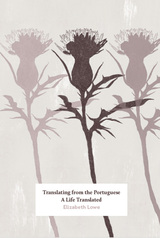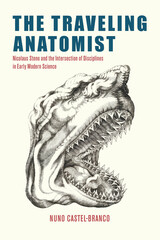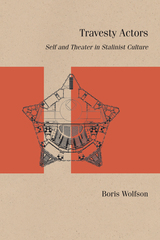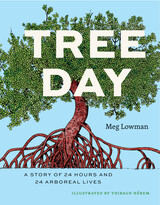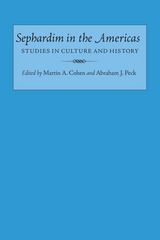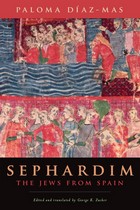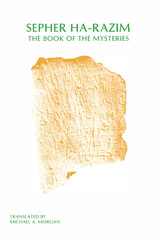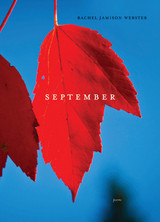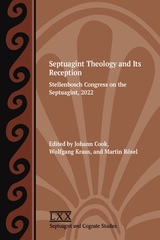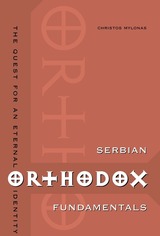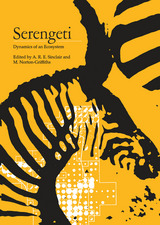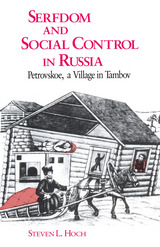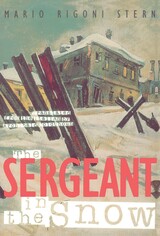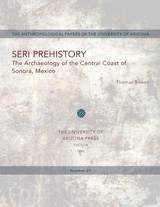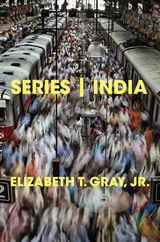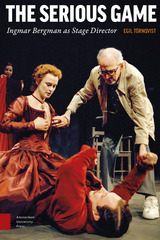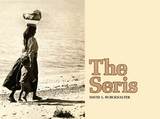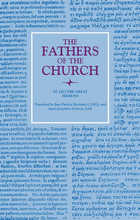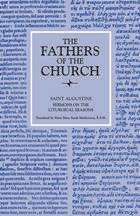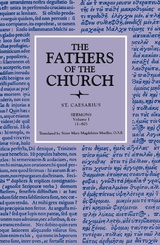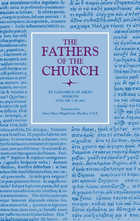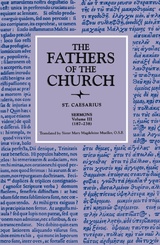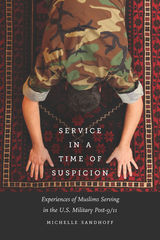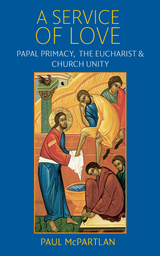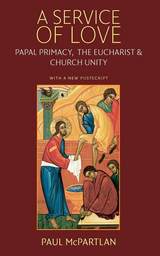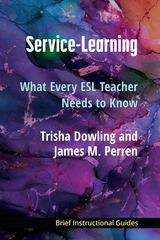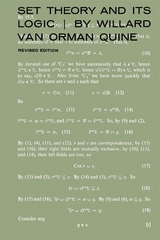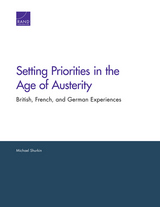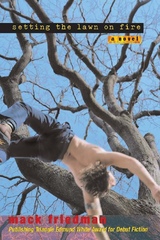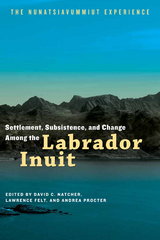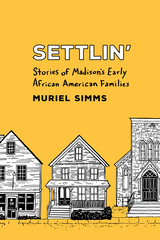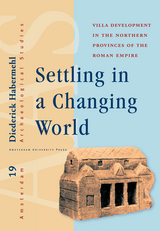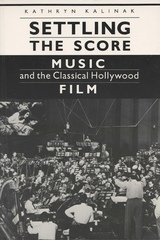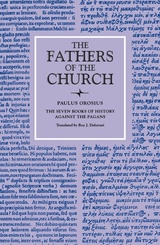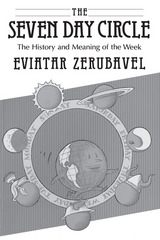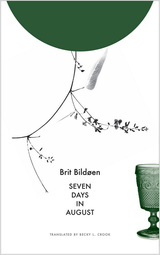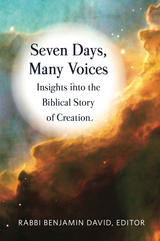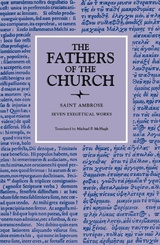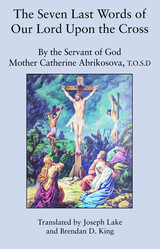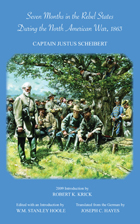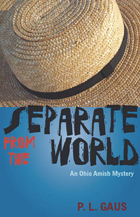 Separate from the World: An Ohio Amish Mystery
P. L. Gaus
Ohio University Press, 2008 As another college year draws to an end, Professor Michael Branden is weary after nearly thirty years of teaching. Sitting in his office on a warm spring day, he receives an unexpected visit from an Amish man who claims his brother, a dwarf like himself, has been murdered. Their discussion of the odd details of the case is interrupted by a commotion on campus, which turns out to be the apparent suicide of a young woman, who, it seems, has leapt to her death from the college bell tower.
The investigations of these two deaths become intertwined as Professor Branden again teams up with his colleagues Pastor Cal Troyer and Sheriff Bruce Robertson to seek explanations for these bizarre events.
Separate from the World is a story of a rift between two Amish factions, one that favors the use of medicine and that participates in a college study of genetic traits particular to the Amish community, and the other that rejects any outside influence.
Once more, P. L. Gaus takes us inside a separate culture and, in a manner both gentle and grim, highlights the complex relationship of the Amish and the “English” as they live inside or outside each other’s orbits.
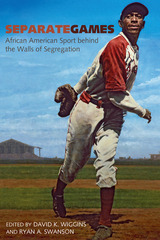 Separate Games: African American Sport behind the Walls of Segregation
David K. Wiggins
University of Arkansas Press, 2017 Winner of the 2017 NASSH Book Award for best edited collection.
The hardening of racial lines during the first half of the twentieth century eliminated almost all African Americans from white organized sports, forcing black athletes to form their own teams, organizations, and events. This separate sporting culture, explored in the twelve essays included here, comprised much more than athletic competition; these “separate games” provided examples of black enterprise and black self-help and showed the importance of agency and the quest for racial uplift in a country fraught with racialist thinking and discrimination. The significance of this sporting culture is vividly showcased in the stories of the Cuban Giants baseball team, basketball’s New York Renaissance Five, the Tennessee State Tigerbelles track-and-field team, black college football’s Turkey Bowl Classic, car racing’s Gold and Glory Sweepstakes, Negro League Baseball’s East-West All-Star game, and many more. These teams, organizations, and events made up a vibrant national sporting complex that remained in existence until the integration of sports beginning in the late 1940s. Separate Games explores the fascinating ways sports helped bind the black community and illuminate race pride, business acumen, and organizational abilities.
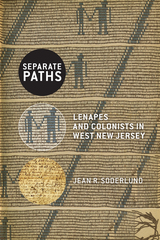 Separate Paths: Lenapes and Colonists in West New Jersey
Jean R. Soderlund
Rutgers University Press, 2022 Winner of the 2023 McCormick Prize from the New Jersey Studies Academic Alliance
Separate Paths: Lenapes and Colonists in West New Jersey is the first cross-cultural study of European colonization in the region south of the Falls of the Delaware River (now Trenton). Lenape men and women welcomed their allies, the Swedes and Finns, to escape more rigid English regimes on the west bank of the Delaware, offering land to establish farms, share resources, and trade. In the 1670s, Quaker men and women challenged this model with strategies to acquire all Lenape territory for their own use and to sell as real estate to new immigrants. Though the Lenapes remained sovereign and “old settlers” retained their Swedish Lutheran religion and ethnic autonomy, the West Jersey proprietors had considerable success in excluding Lenapes from their land. The Friends believed God favored their endeavor with epidemics of smallpox and other European diseases that destroyed Lenape families and communities. Affluent Quakers also introduced enslavement of imported Africans and Natives—and the violence that sustained it—to a colony they had promoted with the liberal West New Jersey Concessions of 1676-77. Thus, they defied their prior experience of religious persecution and their principles of peaceful resolution of conflict, equality of everyone before God, and the golden rule to treat others as you wish to be treated. Despite mutual commitment to peace by Lenapes, old settlers, and Friends, Quaker colonization had similar results to military conquests of Natives by English in Virginia and New England, and Dutch in the Hudson Valley and northern New Jersey. Still, in alliance with old settlers, Lenape communities survived in areas outside the focus of English colonization, in the Pine Barrens, upper reaches of streams, and Atlantic shore.
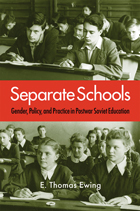 Separate Schools: Gender, Policy, and Practice in Postwar Soviet Education
E. Thomas Ewing
Northern Illinois University Press, 2010
Starting in 1943, millions of children were separated into boys’ and girls’ schools in cities across the Soviet Union. The government sought to reinforce gender roles in a wartime context and to strengthen discipline and order by separating boys and girls into different classrooms. The program was a failure. Discipline further deteriorated in boys’ schools, and despite intentions to keep the education equal, girls’ schools experienced increased perceptions of academic inferiority, particularly in the subjects of math and science. The restoration of coeducation in 1954 demonstrated the power of public opinion, even in a dictatorship, to influence school policies.
In the first full-length study of the program, Ewing examines this large-scale experiment across the full cycle of deliberating, advocating, implementing, experiencing, criticizing, and finally repudiating separate schools. Looking at the encounters of pupils in classrooms, policy objectives of communist leaders, and growing opposition to separate schools among teachers and parents, Ewing provides new insights into the last decade of Stalin’s dictatorship. A comparative analysis of the Soviet case with recent efforts in the United States and elsewhere raises important questions. Based on extensive research that includes the archives of Uzbekistan and Kazakhstan, Separate Schools will appeal to historians of Russia, those interested in comparative education and educational history, and specialists in gender studies.
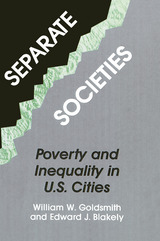 Separate Societies
William Goldsmith
Temple University Press, 1992 Paul Davidoff Award, Association of Collegiate Schools of Planning, 1993
"A passionately argued, provocative book that takes us back to the long neglected emphasis on the cities that was so distinctive a part of the original War On Poverty. But now, at issue is the city of the 21st century."
--Eugene Smolensky
"Economic and political forces no longer combat poverty--they generate poverty!" exclaim William Goldsmith and Edward Blakely in their report on the plight of American's urban poor. Focusing on the reality of separation--social segmentation, economic inequality, and geographic isolation--the authors examine the presence and persistence of urban poverty, the transformation of national industry into a global economy, and the dilemmas of local reform. Goldsmith and Blakely document the appalling conditions of poor and minority people in central cities, examining those conditions in relation to inequalities in the national distributions of income and wealth. They analyze the connections between the structure and movement of the new global economy and the problems of the poorest Americans. They demonstrate how globalized markets and production arrangements have worsened the opportunities facing most American cities and workers. Noting that neither economic growth nor public subsidy has solved the problems of the poor, Goldsmith and Blakely propose that the very separation that exacerbates poverty be used to motive restructure.
The authors maintain that when those in power locally respond to the pressure exerted by those suffering from inequality and isolation, community-level institutions will be restructured. These multi-local coalitions of small businesses and neighborhood organizations need to press for reallocation of federal resources in favor of domestic needs and redirection of the national economic favor of workers and common citizens.
"This is a major work that will influence debate on the issue of American urban poverty into the next century. The authors argue that the recent upsurge in urban poverty has been generated by a particular set of American political responses to changes in the international and national economies, exacerbated by a long process of federally subsidized suburbanization and by racial discrimination. The difference [from Wilson's the Truly Disadvantaged] is that Goldsmith and Blakely's policy recommendations are more comprehensive and have a greater focus on strategies 'from the bottom up.'"
--Joe T. Darden, Dean of Urban Affairs Programs, Michigan State University
"Goldsmith and Blakely present a vivid, factually accurate account of the post-1970s rise in inequality, underemployment, poverty, and collapsing societal infrastructures. Having outlined the dimensions of national disaster, they do not give up hope. Rather, they advocate the improved industrial policy, expanded opportunity for education, and increased family support.... Their provocative optimism, although guarded, is a refreshing challenge, much needed in this period of pessimism and cynicism."
--Robin M. Williams, Jr., Henry Scarborough Professor of Social Science, Emeritus, Cornell University
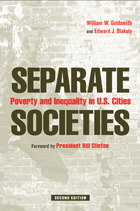 Separate Societies: Poverty and Inequality in U.S. Cities
Authored by William W. Goldsmith and Edward J. Blakely with a foreword by President Bill Clinton
Temple University Press, 2010 “Economic and political forces no longer combat poverty—they generate poverty!" exclaim William Goldsmith and Edward Blakely in their report on the plight of American's urban poor. In this revised and updated edition of their 1992 book Separate Societies,the authors present a compelling examination of the damaging divisions that isolate poor city minority residents from the middle-class suburban majority. They pay special attention to how the needs of the permanently poor have been unmet through the alternating years of promises and neglect, and propose a progressive turn away from 30 years of conservative policies. Separate Societies vividly documents how the urban working class has been pushed out of industrial jobs through global economic restructuring, and how the Wall Street meltdown has aggravated underemployment, depleted public services, and sharpened racial and class inequalities. The authors insist that the current U.S. approach puts Americans out of work and lowers the standard of living for all. As such, Goldsmith and Blakely urge the Obama administration to create better urban policy and foster better metropolitan management to effectively and efficiently promote equality.
A Separate Space: Creating a Military Service for Space
Michael Spirtas
RAND Corporation, 2020 As the United States creates the Space Force as a service within the Department of the Air Force, RAND assessed which units to bring into the Space Force, analyzed career field sustainability, and drew lessons from other defense organizations. The report focuses on implications for effectiveness, efficiency, independence, and sense of identity for the new service.
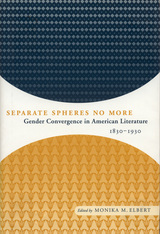 Separate Spheres No More: Gender Convergence in American Literature, 1830-1930
Monika Elbert
University of Alabama Press, 2000 Examines the intersection of male and female spheres in American literature
Although they wrote in the same historical milieu as their male counterparts, women writers of the 19th- and early 20th-centuries have generally been "ghettoized" by critics into a separate canonical sphere. These original essays argue in favor of reconciling male and female writers, both historically and in the context of classroom teaching. While some of the essays pair up female and male authors who write in a similar style or with similar concerns, others address social issues shared by both men and women, including class tensions, economic problems, and the Civil War experience. Rather than privileging particular genres or certain well-known writers, the contributors examine writings ranging from novels and poetry to autobiography, utopian fiction, and essays. And they consider familiar figures like Harriet Beecher Stowe, Emily Dickinson, and Ralph Waldo Emerson alongside such lesser-known writers as Melusina Fay Peirce, Susie King Taylor, and Mary Gove Nichols.
Each essay revises the binary notions that have been ascribed to males and females, such as public and private, rational and intuitive, political and domestic, violent and passive. Although they do not deny the existence of separate spheres, the contributors show the boundary between them to be much more blurred than has been assumed until now.
 Separating Church and State: ROGER WILLIAMS AND RELIGIOUS LIBERTY
Timothy L. Hall
University of Illinois Press, 1998 Roger Williams, founder of the colony of Rhode Island, is famous as an
apostle of religious tolerance and a foe of religious establishments.
In Separating Church and State, Timothy Hall combines impressive
historical and legal scholarship to explore Williams's theory of religious
liberty and relate it to current debate. Williams's fierce religious dogmaticism,
Hall argues, is precisely what led to his religious tolerance, making
him one of the most articulate champions of the argument for the necessary
separation of church and state.
"Both timely and provocative. . . . Offers Williams's largely overlooked
but deeply important perspective on the peaceful coexistence of committed
believers of diverse faiths. The book also brings into question crucial
tenets of the United States Supreme Court's First Amendment religion clause
jurisprudence at a time when many are raising questions about it."
-- Marci A. Hamilton, Benjamin N. Cardozo School of Law, New York City
"Hall has the entire Williams corpus under his command, and he plays
the relevant texts like a master organist. He also has the legal corpus
equally at his fingertips. One of the great strengths of his book is that
it bridges the too often separate fields of history and jurisprudence."
-- Edwin Gaustad, author of Liberty of Conscience: Roger Williams in
America
 Separating Power: Essays on the Founding Period
Gerhard Casper
Harvard University Press, 1997 The separation of powers along functional lines--legislative, executive, and judicial--has been a core concept of American constitutionalism ever since the Revolution. As noted constitutional law scholar Gerhard Casper points out in this collection of essays, barren assertions of the importance of keeping the powers separate do not capture the complexity of the task when it is seen as separating power flowing from a single source--the people. Popular sovereignty did not underlie earlier versions of the separation of powers doctrine.
Casper vividly illustrates some of the challenges faced by Washington, Adams, Hamilton, Madison, Gallatin, Jefferson, and many others in Congress and the executive branch as they guided the young nation, setting precedents for future generations. He discusses areas such as congressional-executive relations, foreign affairs, appropriations, and the Judiciary Act of 1789 from the separation of powers vantage point.
The picture of our government's formative years that emerges here, of a rich and overlapping understanding of responsibilities and authority, runs counter to rigid, syllogistic views. Separating Power gives us a clear portrait of the issues of separation of power in the founding period, as well as suggesting that in modern times we should be reluctant to tie separation of powers notions to their own procrustean bed.
 Separation of Church and State
Philip Hamburger
Harvard University Press, 2004 In a powerful challenge to conventional wisdom, Philip Hamburger argues that the separation of church and state has no historical foundation in the First Amendment. The detailed evidence assembled here shows that eighteenth-century Americans almost never invoked this principle. Although Thomas Jefferson and others retrospectively claimed that the First Amendment separated church and state, separation became part of American constitutional law only much later.
Hamburger shows that separation became a constitutional freedom largely through fear and prejudice. Jefferson supported separation out of hostility to the Federalist clergy of New England. Nativist Protestants (ranging from nineteenth-century Know Nothings to twentieth-century members of the K.K.K.) adopted the principle of separation to restrict the role of Catholics in public life. Gradually, these Protestants were joined by theologically liberal, anti-Christian secularists, who hoped that separation would limit Christianity and all other distinct religions. Eventually, a wide range of men and women called for separation. Almost all of these Americans feared ecclesiastical authority, particularly that of the Catholic Church, and, in response to their fears, they increasingly perceived religious liberty to require a separation of church from state. American religious liberty was thus redefined and even transformed. In the process, the First Amendment was often used as an instrument of intolerance and discrimination.
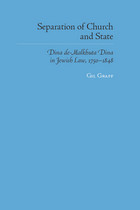 Separation of Church and State: Dina de-Malkhuta Dina in Jewish Law
Gil Graff
University of Alabama Press, 1985 Observes that the significance of dina de-malkhuta dina and its interpretation is vital for an understanding of modern Jewish life as well as the relationship of Diaspora Jews to the Jewish community in the state of Israel
For the Jewish community, the end of the Middle Ages and the emergence of the modern nation-state brought the promise of equal citizenship as well as the possible loss of Jewish corporate identity. The legal maxim dina de-malkhuta dina (the law of the State is law) invoked in Talmidic times to justify the acceptance of the king’s law and qualified in the Middle Ages by Maimonides and Rashbam to include the requirement of consent by the governed underwent further redefinition by Jews in the Napoleonic age. Graff focuses on the struggle between 18th and 19th-century Jewish religious reformers and traditionalists in defining the limits of dina de-malkhuta dina. He traces the motivations of the reformers who, in their zeal to gain equality for the formerly disenfranchised Jewish communities in Western Europe, were prepared to render unto the State compromising authority over Jewish religious life under the rubric of dina de-malkhuta dina was intended to strike a balance between synagogue and state and not to be used as a pretext for the liquidation of the community’s corporate existence.
 Separation of Church and State in the United States
Alvin W. Johnson and Frank H. Yost
University of Minnesota Press, 1948 Separation of Church and State in the United States was first published in 1948. Minnesota Archive Editions uses digital technology to make long-unavailable books once again accessible, and are published unaltered from the original University of Minnesota Press editions. This book is more than a revised and enlarged edition of Dr. Johnson's Legal Status of Church-State Relationships in the United States. Besides rewriting and bringing up to date much of the original material, the authors have added a number of chapters dealing with subjects that have gained prominence in recent years: citizenship and the bearing of arms, saluting the flag, distribution of religious literature, and freedom of speech for Communists. Such recent cases as the Supreme Court decision in McCollum v. Board of Education—better known as the Champaign, Illinois, case—are discussed in some detail. School administrators will find the book of great practical value, for it deals predominantly with church-state relationships in the public schools, one of the chief areas of conflict. These conflicts include such questions as Bible readings and religious instruction in the public schools, dismissed and released time for religious education, the allowing of credit for religious instruction, public aid to sectarian schools, the wearing of religious garb, furnishing free textbooks and transportation for students in parochial schools.
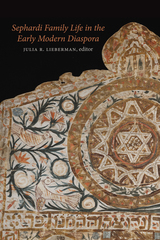 Sephardi Family Life in the Early Modern Diaspora
Edited by Julia R. Lieberman
Brandeis University Press, 2010 This collection of essays examines an important and under-studied topic in early modern Jewish social history”—the family life of Sephardi Jewish families in the Ottoman Empire as well as in communities in Western Europe. At the height of its power in the sixteenth and seventeenth centuries, the Ottoman Empire spanned three continents, controlling much of southeastern Europe, western Asia, and North Africa. Thousands of Jewish families that had been expelled from Spain and Portugal at the end of the fifteenth century created communities in these far-flung locations. Later emigrants from Iberia, who converted to Christianity at the time of the expulsion or before, created communities in Western European cities such as Amsterdam, Hamburg, and Livorno. Sephardi communities were very different from those of Ashkenazi Jews in the same period. The authors of these essays use the lens of domestic life to illuminate the diversity of the post-Inquisition Sephardi Jewish experience, enabling readers to enter into little-known and little-studied Jewish historical episodes. Contributors include: Tirtsah Levie Bernfeld, Hannah Davidson, Cristina Galasso, David Graizbord, Ruth Lamdan, and Julia Lieberman
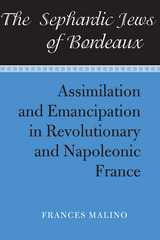 The Sephardic Jews of Bordeaux: Assimilation and Emancipation in Revolutionary and Napoleonic France
Frances Malino
University of Alabama Press, 1978 Sephardim of Bordeaux—the first in Europe to be recognized as a Jewish community
This book focuses on a small community of French Jews, the first in Europe to encounter the requirements of an emerging nation-state and to be recognized by that state as full and equal citizens. The Sephardim of Bordeaux were typical of neither the majority of the Jews of France nor those of Western Europe. They had entered France as Catholics; only after more than a century of public adherence to Catholicism was their community officially recognized as Jewish. Nevertheless, their assimilation and conformity to the standards of French society as well as their commitment to a Judaism fashioned as much by contemporary political and economic concerns as by tradition reveal a legacy bequeathed to French Jewry and an important model for the development of the modern Jew.
Describing the tensions that existed between the Sephardic community of Bordeaux and the Ashkenazic Jews of France, the author also depicts their role in the relation of the Jews with Napoleon and the forming of the Grand Sanhedrin.
Sephardim in the Americas: Studies in Culture and History
Martin A. Cohen
University of Alabama Press, 1993 Multidisciplinary essays examinig the historical and cultural history of the Sephardic experience in the Americas, from pre-expulsion Spain to the modern era, as recounted by some of the most outstanding interpreters of the field.
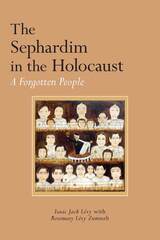 The Sephardim in the Holocaust: A Forgotten People
Isaac Jack Lévy with Rosemary Lévy Zumwalt
University of Alabama Press, 2020 Documents the first-hand experiences in the Holocaust of the Sephardim from Greece, the Balkans, North Africa, Libya, Cos, and Rhodes
The Sephardim suffered devastation during the Holocaust, but this facet of history is poorly documented. What literature exists on the Sephardim in the Holocaust focuses on specific countries, such as Yugoslavia and Greece, or on specific cities, such as Salonika, and many of these works are not available in English.
The Sephardim in the Holocaust: A Forgotten People embraces the Sephardim of all the countries shattered by the Holocaust and pays tribute to the memory of the more than 160,000 Sephardim who perished. Isaac Jack Lévy and Rosemary Lévy Zumwalt draw on a wealth of archival sources, family history (Isaac and his family were expelled from Rhodes in 1938), and more than 150 interviews conducted with survivors during research trips to Belgium, Canada, France, Greece, Israel, Mexico, the Netherlands, the former Yugoslavia, and the United States. Lévy follows the Sephardim from Athens, Corfu, Cos, Macedonia, Rhodes, Salonika, and the former Yugoslavia to Auschwitz.
The authors chronicle the interminable cruelty of the camps, from the initial selections to the grisly work of the Sonderkommandos inside the crematoria, detailing the distinctive challenges the Sephardim faced, with their differences in language, physical appearance, and pronunciation of Hebrew, all of which set them apart from the Ashkenazim. They document courageous Sephardic revolts, especially those by Greek Jews, which involved intricate planning, sequestering of gunpowder, and complex coordination and communication between Ashkenazi and Sephardic inmates—all done in the strictest of secrecy. And they follow a number of Sephardic survivors who took refuge in Albania with the benevolent assistance of Muslims and Christians who opened their doors to give sanctuary, and traces the fate of the approximately 430,000 Jews from Morocco, Algiers, Tunisia, and Libya from 1939 through the end of the war.
The author’s intention is to include the Sephardim in the shared tragedy with the Ashkenazim and others. The result is a much needed, accessible, and viscerally moving account of the Sephardim’s unique experience of the Holocaust.
Sephardim: The Jews from Spain
Paloma Díaz-Mas
University of Chicago Press, 1992 Here, in a single volume, is the first comprehensive history in English of the Sephardim—descendants of the Jews expelled from Spain in 1492. Paloma Díaz-Mas recounts the journey and customs of this fascinating group as they moved across the globe. They settled initially in Mediterranean Europe, the Low Countries, North Africa, and the Turkish Empire, but in the nineteenth century, a second diaspora brought the Sephardim to the United States, South America, Israel, and Western Europe. She traces the origins and survival of their unique language and explores the literature they produced. Their relationship to Spain is also uncovered, as well as their everyday lives. Sephardim is an authoritative and completely accessible investigation of the history and legacy of this amazing people.
Sepher Ha-Razim: The Book of Mysteries
Michael A. Morgan
SBL Press, 1983 Michael A. Morgan translates Mordecai Margaliath’s text of Sepher Ha-Razim, a fourth century CE magical text, into English. Sepher Ha-Razim includes a story about the book’s transmission from the angel Raziel to Noah eventually down to Solomon, six sections describing the nature, function, magical praxis and angelic inhabitants of six of the heavens, and the divine throne in the seventh heaven. With parallels to Talmudic passages, Enochic literature, and Hekhaloth literature, Sepher Ha-Razim sheds light on Greco-Roman magic in general and more specifically Jewish life in the early centuries CE.
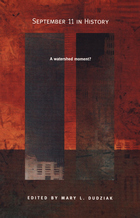 September 11 in History: A Watershed Moment?
Mary L. Dudziak, ed.
Duke University Press, 2003 Hours after the collapse of the Twin Towers, the idea that the September 11 attacks had “changed everything” permeated American popular and political discussion. In the period since then, the events of September 11 have been used to justify profound changes in U.S. public policy and foreign relations. Bringing together leading scholars of history, law, literature, and Islam, September 11 in History asks whether the attacks and their aftermath truly marked a transition in U.S. and world history or whether they are best understood in the context of pre-existing historical trajectories. From a variety of perspectives, the contributors to this collection scrutinize claims about September 11, in terms of both their historical validity and their consequences. Essays range from an analysis of terms like “ground zero,” “homeland,” and “the axis of evil” to an argument that the U.S. naval base at Guantánamo Bay has become a site for acting out a repressed imperial history. Examining the effect of the attacks on Islamic self-identity, one contributor argues that Osama bin Laden enacted an interpretation of Islam on September 11 and asserts that progressive Muslims must respond to it. Other essays focus on the deployment of Orientalist tropes in categorizations of those who “look Middle Eastern,” the blurring of domestic and international law evident in a number of legal developments including the use of military tribunals to prosecute suspected terrorists, and the justifications for and consequences of American unilateralism. This collection ultimately reveals that everything did not change on September 11, 2001, but that some foundations of democratic legitimacy have been significantly eroded by claims that it did. Contributors
Khaled Abou el Fadl
Mary L. Dudziak
Christopher L. Eisgruber
Laurence R. Helfer
Sherman A. Jackson
Amy B. Kaplan
Elaine Tyler May
Lawrence G. Sager
Ruti G. Teitel
Leti Volpp
Marilyn B. Young
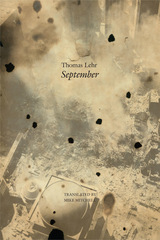 September: Mirage
Thomas Lehr
Seagull Books, 2013 Two fathers with two daughters: Martin, professor of German, writes but is studying Earth Sciences at MIT; Tariq, a doctor in Baghdad and Muna, is studying the archaeology of a region that is seen as the cradle of civilization. These two parallel relationships in two very different parts of the world expose the human similarities beneath cultural differences. In Thomas Lehr’s moving and realistic novel, the similarities between these men become a similarity of suffering as well. Martin’s daughter dies with her mother in the World Trade Center on September 11, 2001, and though Tariq survives three wars and Saddam Hussein’s regime intact, his family does not—in the last days of the conflict, his daughter is raped, her lover is murdered, and she sees her sister and mother die in a bomb attack. Out of these tragedies that almost seem to define the first decade of our century, Lehr has fashioned a richly woven, multilayered tapestry that not only explores the human side but brings out the cultural, historical, social, and political context within which the tragedies occur. The alternating interior monologues of the four main characters engage the reader in language which reaches an unforgettable poetic intensity.
September: Poems
Rachel Jamison Webster
Northwestern University Press, 2013 The poems in Rachel Webster’s debut collection September often address a fleeting moment. Like the month, the moment can be a single leaf falling or a season of life. Webster’s pastoral poems address personal physical change in the seasons of life, including childhood, love, motherhood, and death. Together they lead the reader through a lyrical landscape of conversation, meditation, and healing. The work of a poet sensitive to worlds external and internal, September speaks to the core of life and the simplicity of human events and the natural world around us.
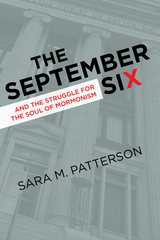 The September Six and the Struggle for the Soul of Mormonism
Patterson, Sara M.
Signature Books, 2023 In the single month of September 1993, the Church of Jesus Christ of Latter-day Saints excommunicated or disciplined six of its members. These six individuals–some of them intellectuals, some activists, and some both–were soon dubbed the “September Six.” In The September Six and the Struggle for the Soul of Mormonism, Sara M. Patterson challenges readers to think more deeply about the events of that month and the era in which they unfolded. Patterson argues that the clever alliterative phrase “September Six” masks our ability to see that what happened that month was part of a much broader, decades-long cultural and theological debate over the nature of the church and its restoration narrative. During those decades the institutional church invested in and policed a purity system, expecting believers to practice doctrinal, familial, and bodily purity. Dissenters within the institution pushed back, imagining instead a vision of the Restoration that embraced personal conscience, truth-seeking and telling, and social egalitarianism at its core. Both sides were profoundly shaped by the cultural milieu that surrounded them. What happened in September 1993 continues to echo in the church today, having lasting effects on the institution, its believers, and the broader culture.
Septuagint Theology and Its Reception: Stellenbosch Congress on the Septuagint, 2022
Johann Cook
SBL Press, 2024 In this follow-up to Toward a Theology of the Septuagint: Stellenbosch Congress on the Septuagint, 2018 (2020), contributors demonstrate what a theology of the Septuagint should look like. Essays address questions of methodology, and case studies from different books show the relevance and benefits of a theological approach. Examples are drawn from Exodus, Deuteronomy, Proverbs, Job, Tobit, 1 and 2 Maccabees, Hosea, Ezekiel, Daniel, and Ben Sira. Contributors include Nicholas Peter Legh Allen, Bryan Beeckman, Alma Brodersen, Johann Cook, Beate Ego, Karin Finsterbusch, Pierre Jordaan, Wolfgang Kraus, Jean Maurais, Cynthia L. Miller-Naudé, Mogens Müller, Jacobus A. Naudé, Peter Nagel, Larry Perkins, Martin Rösel, Barbara Schmitz, Frank Ueberschaer, Jan Willem van Henten, and Michael van der Meer.
Serapion Sister: The Poetry of Exizaveta Polonskaja
Leslie Dorfman Davis
Northwestern University Press, 2001 Serapion Sister explores the poetry of Elizaveta Polonskaja—the least-known member of the Serapion Brothers, a controversial group of Soviet writers who, while supporting the revolution, were committed to artistic freedom.
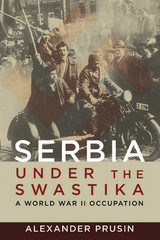 Serbia under the Swastika: A World War II Occupation
Alexander Prusin
University of Illinois Press, 2017 The 1941 Axis invasion of Yugoslavia initially left the German occupiers with a pacified Serbian heartland willing to cooperate in return for relatively mild treatment. Soon, however, the outbreak of resistance shattered Serbia's seeming tranquility, turning the country into a battlefield and an area of bitter civil war. Deftly merging political and social history, Serbia under the Swastika looks at the interactions between Germany’s occupation policies, the various forces of resistance and collaboration, and the civilian population. Alexander Prusin reveals a German occupying force at war with itself. Pragmatists intent on maintaining a sedate Serbia increasingly gave way to Nazified agencies obsessed with implementing the expansionist racial vision of the Third Reich. As Prusin shows, the increasing reliance on terror catalyzed conflict between the nationalist Chetniks, communist Partisans, and the collaborationist government. Prusin unwraps the winding system of expediency that at times led the factions to support one-another against the Germans--even as they fought a ferocious internecine civil war to determine the future of Yugoslavia. Comprehensive and judicious, Serbia under the Swastika is a rare English-language foray into the still-fraught history of Serbia in World War II.
Serbian & Greek Art Music: A Patch to Western Music History
Edited by Katy Romanou
Intellect Books, 2009 The music of Serbia and Greece has long been a vital part of Balkan culture, but it has been excluded from the academic canon of Western music history. Katy Romanou corrects this oversight with Serbian and Greek Art Music, the first book in English on the subject. Written by seven renowned musicologists, the book stresses the interaction between music and politics and relates the efforts of local musicians to synchronize their musical environment with the West. Focusing on music education, musical culture, and creation, this timely volume will be of interest to musicologists and scholars of Balkan culture.
Serbian Orthodox Fundamentals: The Quest for an Eternal Identity
Christos Mylonas
Central European University Press, 2003 This book is a comprehensive exposition of the interaction of a national (the Serbian people) and a religiou (the Orthodox Christian faith) content, in the formation of a distinctive national identity and a mode of being. Its interdisciplinary approach, drawing on sociology, social anthropology, theology, political theory, Balkan historiography, and Serbian folklore, is deployed to provide a powerful and original analysis of how Serbian Orthodoxy has resulted in the sacralisation of the Serbian nation by framing the parameters of its existence. Addresses the following questions: what 'makes' a Serb? Are meaningful assumptions possible by introducing Serbian Orthodoxy as the primal point of reference? Why does religion appear to have an especially strong appeal?
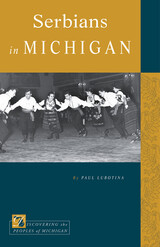 Serbians in Michigan
Paul Lubotina
Michigan State University Press, 2014 Fighting, nationalism, and religion influenced Serbian migration to America in three distinct waves during the twentieth century, first following the Balkan Wars, again after the Second World War, and most recently, following the breakup of Yugoslavia in the 1980s. Serbians in Michigan examines the lives of Serbian immigrants from lowland areas of the Balkans and the distinct highland culture of Montenegro. The work provides cultural background to Serbian society that serves as a benchmark to compare the changes that occurred among the population after arriving in Michigan. The book also functions as an informational how-to guide for individuals of Serbian descent who are interested in learning more about their ancestors. Lubotina provides key words, phrases, and recipes that allow readers to sample aspects of Serbian culture from the comfort of their homes. Additionally, the book explores the nature of a split between conservative and liberal factions in Serbian-American communities. However, a key theme in the book is how the Serbian Orthodox Church has maintained Serbian heritage and nationalism through several generations in America.
Serbocroatian Heroic Songs
Milman Parry
Harvard University Press, 1954 In researching this collection, Milman Parry set out to test the theories he had evolved on oral epic, theories that were to introduce a new era of Homeric scholarship. In the Balkans, one of the few areas where a living tradition of oral heroic poetry was still to be found, he observed firsthand how unlettered singers composed their poems, and collected more than 1200 hours of poetic performance from the most experienced bards. Comprising representative texts and translations from the Parry Collection, this series records the South Slavic tradition.
Serbocroatian Heroic Songs
Milman Parry
Harvard University Press, 1954 This limited edition contains the critical texts of eight long oral epics from four bards of northern Bosnia, the northern most predominantly Muslim district in Europe. Sung with the accompaniment of the picked tambura rather than the bowed gusle that is familiar elsewhere in the Yugoslav tradition, the epos in northern Bosnia was often strophic or stanzaic rather than stichic. This volume is the first publication in the more than century-old scholarship on South Slavic oral traditions to take note of that fact, and to document it with specific texts. The editor's Prolegomena include detailed discussions of the principles of rhythm in this epos, the sources of the tales in it, and extensive comparative commentaries linking the eight narratives with those found in other Yugoslav towns, especially with the tradition of Avdo Međedović at Bijelo Polje.
Serbocroatian Heroic Songs
Milman Parry
Harvard University Press The Wedding of Vlahinjic Alija represents a unique experiment in field collecting of oral traditional epic poetry. In order to determine whether and exactly how the text of a long epic would change as the best of oral poets told and retold it, Milman Parry first made a complete audio-recording of Avdo Međedović singing this long heroic narrative, and then some days later had the entire epic taken down again by dictation from the same singer.
Both texts, the sung (6053 verses) and the dictated (5883 verses) are presented in this volume, showing precisely the effects both of recomposition and of the “intervention” of writing by an amanuensis. Osmanbeg Delibegović i Pavičević Luka is 13,326 verses long, a modern oral traditional epic of truly Homeric length. It is the longest complete and continuous oral epic text that has yet been recorded anywhere in the modern world.
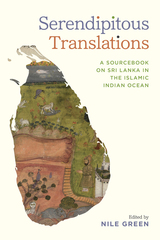 Serendipitous Translations: A Sourcebook on Sri Lanka in the Islamic Indian Ocean
Edited by Nile Green
University of Texas Press, 2025 The most comprehensive anthology of primary sources on Sri Lanka’s links with the Islamic world ever assembled in English. Sri Lanka is an underappreciated focal point of global history. Known to Persian and Arab traders as Serendib, the island has long been a site of intensive cultural and material exchange, as well as a holy place—Islamic tradition holds that the biblical Adam arrived there after his expulsion from Eden. Assembling centuries of texts, this volume presents an array of sources from the Indian Ocean. Serendipitous Translations gathers travelogues, literary works, commercial records, inscriptions, religious tracts, pilgrim manuals, and more—an unprecedented range of Muslim voices from Sri Lanka between the 1200s and 1990s. These works vividly document medieval pilgrimages, maritime mysticism, diplomatic encounters, colonial-era commerce, and the bustling everyday affairs of a cosmopolitan Asian nexus. Expert translations bring Arabic, Malay, Turkish, Urdu, Dhivehi, Sinhala, Arabic-Tamil, and Tamil texts to readers of English for the first time. Editor Nile Green situates these texts in their Indian Ocean contexts by introducing the broad sweep of Sri Lanka’s story. An invaluable collection, Serendipitous Translations is the most comprehensive anthology of primary sources ever assembled on Sri Lanka’s thousand-year links to the Muslim world.
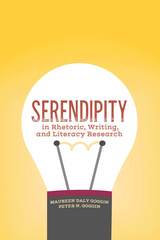 Serendipity in Rhetoric, Writing, and Literacy Research
Maureen Daly Goggin
Utah State University Press, 2018 In the course of research, most scholars have known moments of surprise, catastrophe, or good fortune, though they seldom refer to these occurrences in reports or discuss them with students. Serendipity in Rhetoric, Writing, and Literacy Research reveals the different kinds of work scholars, particularly those in rhetoric, writing, and literacy, need to do in order to recognize a serendipitous discovery or a missed opportunity. In published scholarship and research, the path toward discovery seems clean and direct. The dead ends, backtrackings, start-overs, and stumbles that occur throughout the research process are elided, and seems that the researchers started at point A and arrived safely and neatly at point B without incident, as if by magic. The path, however, is never truly clear and straight. Research and writing is messy. Serendipity in Rhetoric, Writing, and Literacy Research features chapters from twenty-three writing scholars who have experienced moments of serendipity in their own work—not by magic or pure chance but through openness and active waiting, which offer an opportunity to prepare the mind. Serendipity in Rhetoric, Writing, and Literacy Research illustrates the reality of doing research: there is no reliable prescription or one-size-fits-all manual, but success can be found with focused dedication and an open mind. Contributors: Ellen Barton, Zachary C. Beare, Lynn Z. Bloom, Jennifer Clary-Lemon, Caren Wakerman Converse, Gale Coskan-Johnson, Kim Donehower, Bill Endres, Shirley E. Faulkner-Springfield, Lynée Lewis Gaillet, Brad Gyori, Judy Holiday, Gesa E. Kirsch, Lori Ostergaard, Doreen Piano, Liz Rohan, Ryan Skinnell, Patricia Wilde, Daniel Wuebben
Serengeti: Dynamics of an Ecosystem
Edited by A. R. E. Sinclair and M. Norton-Griffiths
University of Chicago Press, 1979 Originally published in 1979, Serengeti: Dynamics of an Ecosystem was immediately recognized as the first synthesis of the patterns and processes of a major ecosystem. A prototype for initial studies, Serengeti contains baseline data for further and comparative studies of ecosystems. The new Serengeti II builds on the information presented originally in Serengeti; both books together offer essential information and insights for ecology and conservation biology.
 Serengeti II: Dynamics, Management, and Conservation of an Ecosystem
Edited by A. R. E. Sinclair and Peter Arcese
University of Chicago Press, 1995 Serengeti II: Dynamics, Management, and Conservation of an Ecosystem brings together twenty years of research by leading scientists to provide the most most thorough understanding to date of the spectacular Serengeti-Mara ecosystem in East Africa, home to one of the largest and most diverse populations of animals in the world.
Building on the groundwork laid by the classic Serengeti: Dynamics of an Ecosystem, published in 1979 by the University of Chicago Press, this new book integrates studies of the ecosystem at every level—from the plants at the bottom of the visible food chain, to the many species of herbivores and predators, to the system as a whole. Drawing on new data from many long-term studies and from more recent research initiatives, and applying new theory and computer technology, the contributors examine the large-scale processes that have produced the Serengeti's extraordinary biological diversity, as well as the interactions among species and between plants and animals and their environment. They also introduce computer modeling as a tool for exploring these interactions, employing this new technology to test and anticipate the effects of social, political, and economic changes on the entire ecosystem and on particular species, and so to shape future conservation and management strategies.
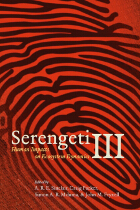 Serengeti III: Human Impacts on Ecosystem Dynamics
Edited by A. R. E. Sinclair, Craig Packer, Simon A. R. Mduma, and John M. Fryxel
University of Chicago Press, 2008 Serengeti National Park is one of the world’s most diverse ecosystems, a natural laboratory for ecology, evolution, and conservation, with a history that dates back at least four million years to the beginnings of human evolution. The third book of a ground- breaking series, Serengeti III is the result of a long-term integrated research project that documents changes to this unique ecosystem every ten years. Bringing together researchers from a wide range of disciplines—ecologists, paleontologists, economists, social scientists, mathematicians, and disease specialists— this volume focuses on the interactions between the natural system and the human-dominated agricultural system. By examining how changes in rainfall, wildebeest numbers, commodity prices, and human populations have impacted the Serengeti ecosystem, the authors conclude that changes in the natural system have affected human welfare just as changes in the human system have impacted the natural world. To promote both the conservation of biota and the sustainability of human welfare, the authors recommend community-based conservation and protected-area conservation. Serengeti III presents a timely and provocative look at the conservation status of one of earth’s most renowned ecosystems.
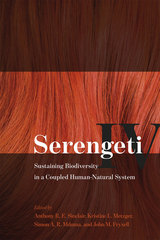 Serengeti IV: Sustaining Biodiversity in a Coupled Human-Natural System
Edited by Anthony R. E. Sinclair, Kristine L. Metzger, Simon A. R. Mduma, and John M. Fryxell
University of Chicago Press, 2015 The vast savannas and great migrations of the Serengeti conjure impressions of a harmonious and balanced ecosystem. But in reality, the history of the Serengeti is rife with battles between human and non-human nature. In the 1890s and several times since, the cattle virus rinderpest—at last vanquished in 2008—devastated both domesticated and wild ungulate populations, as well as the lives of humans and other animals who depended on them. In the 1920s, tourists armed with the world’s most expensive hunting gear filled the grasslands. And in recent years, violence in Tanzania has threatened one of the most successful long-term ecological research centers in history.
Serengeti IV, the latest installment in a long-standing series on the region’s ecology and biodiversity, explores the role of our species as a source of both discord and balance in Serengeti ecosystem dynamics. Through chapters charting the complexities of infectious disease transmission across populations, agricultural expansion, and the many challenges of managing this ecosystem today, this book shows how the people and landscapes surrounding crucial protected areas like Serengeti National Park can and must contribute to Serengeti conservation. In order to succeed, conservation efforts must also focus on the welfare of indigenous peoples, allowing them both to sustain their agricultural practices and to benefit from the natural resources provided by protected areas—an undertaking that will require the strengthening of government and education systems and, as such, will present one of the greatest conservation challenges of the next century.
 The Serengeti Lion: A Study of Predator-Prey Relations
George B. Schaller
University of Chicago Press, 1976 Based on three years of study in the Serengeti National Park, George B. Schaller’s The Serengeti Lion describes the vast impact of the lion and other predators on the vast herds of wildebeest, zebra, and gazelle for which the area is famous. The most comprehensive book available on the lion, this classic work includes the author’s findings on all aspects of lion behavior, including its social system, population dynamics, hunting behavior, and predation patterns. “If you have only enough time to read one book about field biology, this is the one I recommend.”—Edward O. Wilson, Science “This book conveys not only the fascination of its particular study of lion behavior but the drama and wonder and beauty of the intimate interdependence of all living things.”—Saturday Review “This is an important book, not just for its valuable information on lions, but for its broad, open, and intelligent approach to problems that cut across the fields of behavior, populations, ecology, wildlife management, evolution, anthropology, and comparative biology.”—Richard G. Van Gelder, Bioscience
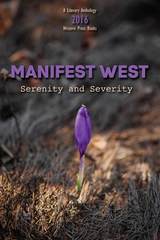 Serenity and Severity
Caleb Seeling
University Press of Colorado, 2016 Volume 5, Manifest West Series, Western Press Books Serenity and severity form a classic Western dichotomy with many manifestations. Beautiful growth and renewal follow a terrifying and destructive forest fire. Rain upon a hayfield can be interpreted as grace or judgment from above, depending on the season. The unpredictability of nature provides hikers with a breathtaking view one day and a life-threatening scenario the next. Yet the nature of the West does not only imply the outdoors. The people of the West encounter serenity and severity in all aspects of life, and this duality impacts their identity and shapes their lifestyles, outlooks, worldviews, and values. This year’s collection includes political discussions, philosophical ponderings, and lighthearted humor that are all a part of life in the West. For the fifth volume of Manifest West, twenty-nine writers explore this theme, revealing the duality of Western life through many different narrative trails—including governed environment, overwhelming fires, hiking adventures, and the effect of location on family. Creativity and diversity come to this anthology in both content and form, with flash fiction joining Manifest West’s standard genres of creative nonfiction, short fiction, and poetry. Their combined reflections enable us to see the intense relationship between humanity and nature; sometimes nature directs humans’ lives, to their harm and to their benefit, and other times, humanity abuses the very environment it cherishes as its home. Authors bring their personal styles, voices, and experiences with life in the West to contribute to a balanced and unique interpretation of serenity and severity. Contributors: Rebecca Aronson, Betsy Bernfeld, Heidi E. Blankenship, Kaye Lynne Booth, Sarah B. Boyle, John Brantingham, William Cass, David Lavar Coy, Benjamin Dancer, Gail Denham, Patricia Frolander, John Haggerty, Lyla D. Hamilton, Michael Harty, Rick Kempa, Don Kunz, Ellaraine Lockie, Nathan Alling Long, Sarah Fawn Montgomery, Juan J. Morales, Lance Nizami, Ronald Pickett, Terry Severhill, David Stallings, Scott T. Starbuck, Abigail Van Kirk, Victoria Waddle, Evan Morgan Williams, Steven Wingate Manifest West is Western Press Books’ literary anthology series. The press, affiliated with Western State Colorado University, produces one anthology annually and focuses on Western regional writing.
 Serf, Seigneur, and Sovereign: Agrarian Reform in Eighteenth-Century Bohemia
William E. Wright
University of Minnesota Press, 1966 Serf, Seigneur, and Sovereign was first published in 1966. Minnesota Archive Editions uses digital technology to make long-unavailable books once again accessible, and are published unaltered from the original University of Minnesota Press editions. This is a detailed history of the agrarian reforms which took place in Bohemia during the reigns of the Habsburg rulers Maria Theresa, 1740–1780, and Joseph II, 1780–1790. The enactment of the land reforms had far-reaching social, economic, and political effects, and the subject constitutes an important chapter in the history of the nation we now know as Czechoslovakia. The topic has been hardly touched in English, however, and has only recently been properly treated by the Marxist historians of post-World War II Czechoslovakia. Much of Professor Wright's account is based on documents not previously used by historians, particularly materials in the Hofkammerarchiv in Vienna. The author provides a background by describing the development of serfdom in Bohemia over approximately two hundred years prior to the accession of Maria Theresa to the throne of Austria in 1740. In major sections of the book Professor Wright traces the causes, events, and effects of the program of agrarian reform which Maria Theresa and Joseph II carried out. He shows how the changes in the land system profoundly affected the relationships of the serf, seigneur, and sovereign, and how they paved the way for the much greater social revolution which was to come with the emancipation of 1848. In addition to providing a wealth of factual information, the account gives a dramatic picture of the plight of the peasant, along with valid glimpses of the personalities of the rulers and their ministers. Specialists in European history, social history, or agrarian history will find the book particularly rewarding.
The Sergeant in the Snow
Mario Rigoni Stern
Northwestern University Press, 1998 Mario Rigoni Stern was barely twenty-one and already a battle veteran at the time of the World War II disaster he describes in The Sergeant in the Snow. In July 1942 three divisions of Italian Alpini troops, specially trained for winter warfare, began retreating--entirely on foot, with no supplies, at temperatures of 30-40 degrees below zero. By the end of the march, 90,000 men were missing or dead and 45,000 frostbitten and wounded.
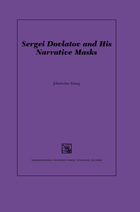 Sergei Dovlatov and His Narrative Masks
Jekaterina Young
Northwestern University Press, 2012 This book provides an introduction to Sergei Dovlatov (1941–1990) that is closely attentive to the details of his life and work, their place in the history of Soviet society and literature, and of émigré culture during this turbulent period. A journalist, newspaper editor, and prose writer, Dovlatov is most highly regarded for his short stories, which draw heavily on his experiences in Russia before 1979, when he was forced out of the country. During compulsory military service, before becoming a journalist, he worked briefly as a prison camp guard—an experience that gave him a unique perspective on the operations of the Soviet state. After moving to New York, Dovlatov published works (in the New Yorker and elsewhere) that earned him considerable renown in America and back in Russia. Young’s book presents a valuable critical overview of the prose of a late twentieth-century master within the context of the prevailing Russian and larger literary culture.
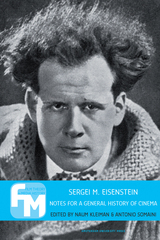 Sergei M. Eisenstein: Notes for a General History of Cinema
Edited by Naum Kleiman and Antonio Somaini
Amsterdam University Press, 2016 One of the iconic figures of the twentieth-century cinema, Sergei Eisenstein is best known as the director of The Battleship Potemkin, Alexander Nevskii and Ivan the Terrible. His craft as director and film editor left a distinct mark on such key figures of the Western cinema as Nicolas Roeg, Francis Ford Coppola, Sam Peckinpah and Akiro Kurosawa.This comprehensive volume of Eisenstein’s writings is the first-ever English-language edition of his newly discovered notes for a general history of the cinema, a project he undertook in 1946-47 before his death in 1948. In his writings, Eisenstein presents the main coordinates of a history of the cinema without mentioning specific directors or films: what we find instead is a vast genealogy of all the media and of all the art forms that have preceded cinema’s birth and accompanied the first decades of its history, exploring the same expressive possibilities that cinema has explored and responding to the same, deeply rooted, “urges” cinema has responded to. Cinema appears here as the heir of a very long tradition that includes death masks, ritual processions, wax museums, diorama and panorama, and as a medium in constant transformation, that far from being locked in a stable form continues to redefine itself.
The texts by Eisenstein are accompanied by a series of critical essays written by some of the world’s most qualified Eisenstein scholars.
 Sergei Paradjanov: Shadows of Forgotten Ancestors
Joshua First
Intellect Books, 2016 Released in 1965, Sergei Paradjanov’s Shadows of Forgotten Ancestors is a landmark of Soviet-era cinema—yet, because its emphasis on folklore and mysticism in traditional Carpathian Hutsul culture broke with Soviet realism, it caused Paradjanov to be blacklisted soon after its release.
This book is the first full-length companion to the film. In addition to a synopsis of the plot and a close analysis of the many levels of symbolism in the film, it offers a history of the film’s legendarily troubled production process (which included Paradjanov challenging a cinematographer to a duel). The book closes with an account of the film’s reception by critics, ordinary viewers, and Soviet officials, and the numerous controversies that have kept it a subject of heated debate for decades. An essential companion to a fascinating, complicated work of cinema art, this book will be invaluable to students, scholars, and regular film buffs alike.
Seri Prehistory: The Archaeology of the Central Coast of Sonora, Mexico
Thomas Bowen
University of Arizona Press, 1976 The Anthropological Papers of the University of Arizona is a peer-reviewed monograph series sponsored by the School of Anthropology. Established in 1959, the series publishes archaeological and ethnographic papers that use contemporary method and theory to investigate problems of anthropological importance in the southwestern United States, Mexico, and related areas.
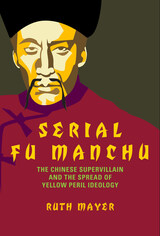 Serial Fu Manchu: The Chinese Supervillain and the Spread of Yellow Peril Ideology
Ruth Mayer
Temple University Press, 2013 The evil mastermind—and master of disguise—Fu Manchu has long threatened to take over the world. In the past century, his dastardly plans have driven serialized novels, comic books, films, and TV. Yet this sinister Oriental character represents more than an invincible criminal in pop culture; Fu Manchu became the embodiment of the Yellow Peril. Serial Fu Manchu provides a savvy cultural, historical, and media-based analysis that shows how Fu Manchu’s irrepressibility gives shape to—and reinforces—the persistent Yellow Peril myth. Ruth Mayer argues that seriality is not merely a commercial strategy but essential to the spread of European and American fears of Asian expansion. Tracing Fu Manchu through transnational serials in varied media from 1913 to the 1970s, Mayer shows how the icon evolved. She pays particular attention to the figure’s literary foundations, the impact of media changes on his dissemination, and his legacy.
In the series Asian American History and Culture, edited by Sucheng Chan, David Palumbo-Liu, Michael Omi, K. Scott Wong, and Linda Trinh Võ
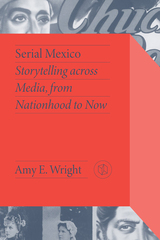 Serial Mexico: Storytelling across Media, from Nationhood to Now
Amy E. Wright
Vanderbilt University Press, 2023 Honorable Mention, Katherine Singer Kovacs Prize, Modern Language Association, 2023
Honorable Mention, Premio al Mejor Libro en Humanidades, Latin American Studies Association–Mexico Section, 2025
No book until now has tied in two centuries of Mexican serial narratives—tales of glory, of fame, and of epic characters, grounded in oral folklore—with their subsequent retelling in comics, radio, and television soap operas. Wright’s multidisciplinary Serial Mexico delves into this storytelling tradition: examining the nostalgic tales reimagined in novelas, radionovelas, telenovelas and onwards, and examining the foundational figures who have been woven into society.
This panorama shows the Mexican experience of storytelling from the country’s early days until now, showcasing protagonists that mock authority, make light of hierarchy, and embrace the hybridity and mestizaje of Mexico. These tales reflect on and respond to crucial cultural concerns such as family, patriarchy, gender roles, racial mixing, urbanization, modernization, and political idealism. Serial Mexico thus examines how serialized storytelling’s melodrama and sensationalism reveals key political and cultural messaging.
In a detailed yet accessible style, Wright describes how these stories have continued to morph with current times’ concerns and social media. Will tropes and traditions carry on in new and reimagined serial storytelling forms? Only time will tell. Stay tuned for the next episode.
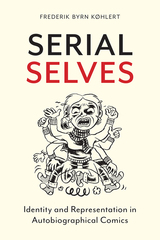 Serial Selves: Identity and Representation in Autobiographical Comics
Frederik Byrn Køhlert
Rutgers University Press, 2019 Autobiography is one of the most dynamic and quickly-growing genres in contemporary comics and graphic narratives. In Serial Selves, Frederik Byrn Køhlert examines the genre’s potential for representing lives and perspectives that have been socially marginalized or excluded. With a focus on the comics form’s ability to produce alternative and challenging autobiographical narratives, thematic chapters investigate the work of artists writing from perspectives of marginality including gender, sexuality, disability, and race, as well as trauma. Interdisciplinary in scope and attuned to theories and methods from both literary and visual studies, the book provides detailed formal analysis to show that the highly personal and hand-drawn aesthetics of comics can help artists push against established narrative and visual conventions, and in the process invent new ways of seeing and being seen.
As the first comparative study of how comics artists from a wide range of backgrounds use the form to write and draw themselves into cultural visibility, Serial Selves will be of interest to anyone interested in the current boom in autobiographical comics, as well as issues of representation in comics and visual culture more broadly.
 Seriality and Social Change
Peter Hitchcock
Seagull Books, 2025 Can revolution unfold in chapters? Seriality has long shaped how we read, think, and act; Peter Hitchcock explores how it structures both knowledge and social change.
From Karl Marx’s decision to publish Capital in serial form to contemporary adaptations in manga and graphic novels, Seriality and Social Change examines how serialization both democratizes knowledge and shapes the very process of social transformation. Peter Hitchcock delves into the paradox of the serial: while it can expand access to radical thought, it can also impose structural limits, slowing or containing the revolutionary potential it seeks to unleash.
Through a sweeping analysis that links literature and political economy, Hitchcock explores how serialized narratives frame, sustain, or even hinder movements for change. Does seriality mirror the mechanics of capitalism, or can it be a tool for subverting them? Engaging with this question across genres and forms, Seriality and Social Change invites readers to rethink how revolution is told and imagined over time.
Series | India
Elizabeth T. Gray
Four Way Books, 2015 Anchored by braided and unstable narratives of young Westerners in India, the poems in Series | India explore the rich borderlands that run between the familiar and the foreign, illumination and opacity, gods and charlatans. In lyrics deeply informed by Gray’s study and experience in India, and formally characterized by shifting and juxtaposed perceptions, perspectives, and voices, we encounter a young couple seeking refuge and enlightenment in a place where the lines between the divine, the human, the gorgeous, the deadly, and the hilarious are often indistinct. How do we make meaning of our encounters with love, death, the divine, the absurd, the horrific? What and how do we actually see? How do we choose? The poems explore these hard questions with compassion, humor, and awe.
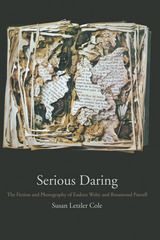 Serious Daring: The Fiction and Photography of Eudora Welty and Rosamond Purcell
Susan Letzler Cole
University of Arkansas Press, 2016 Serious Daring is the story of the complementary journeys of two American women artists, celebrated fiction writer Eudora Welty and internationally acclaimed photographer Rosamond Purcell, each of whom initially practiced, but then turned from, the art form ultimately pursued by the other. For both Welty and Purcell, the art realized is full of the art seemingly abandoned. Welty’s short stories and novels use images of photographs, photographers, and photography. Purcell photographed books, texts, and writing. Both women make compelling art out of the seeming tension between literary and visual cultures. Purcell wrote a memoir in which photographs became endnotes. Welty re-emerged as a photographer through the publication of four volumes of what she called her “snapshots,” magnificent black-and-white photographs of small-town Mississippi and New York City life. Serious Daring is a fascinating look at how the road not taken can stubbornly accompany the chosen path, how what is seemingly left behind can become a haunting and vital presence in life and art.
The Serious Game: Ingmar Bergman as Stage Director
Egil Törnqvist
Amsterdam University Press, 2016 Though Ingmar Bergman became famous as a filmmaker, his roots-and, to some extent, his heart-were in the theater. He directed more than one hundred plays in his career, and The Serious Game takes a close look at fourteen productions he staged at the Royal Dramatic Theatre in Stockholm. Looking closely at the relationship between the verbal and the visual, this book gives even longtime Bergman fans a new understanding of his sensitivity to nuance, his versatility, and his dedication to craftsmanship. **INCLUDES DVD WITH FOURTEEN VIDEO RECORDINGS, ALL IN COLOUR**
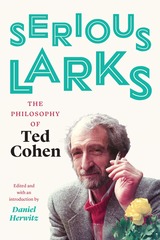 Serious Larks: The Philosophy of Ted Cohen
Ted Cohen
University of Chicago Press, 2018 Ted Cohen was an original and captivating essayist known for his inquisitive intelligence, wit, charm, and a deeply humane feel for life. For Cohen, writing was a way of discovering, and also celebrating, the depth and complexity of things overlooked by most professional philosophers and aestheticians—but not by most people. Whether writing about the rules of baseball, of driving, or of Kant’s Third Critique; about Hitchcock, ceramics, or jokes, Cohen proved that if you study the world with a bemused but honest attentiveness, you can find something to philosophize about more or less anywhere.
This collection, edited and introduced by philosopher Daniel Herwitz, brings together some of Cohen’s best work to capture the unique style that made Cohen one of the most beloved philosophers of his generation. Among the perceptive, engaging, and laugh-out-loud funny reflections on movies, sports, art, language, and life included here are Cohen’s classic papers on metaphor and his Pushcart Prize–winning essay on baseball, as well as memoir, fiction, and even poetry. Full of free-spirited inventiveness, these Serious Larks would be equally at home outside Thoreau’s cabin on the waters of Walden Pond as they are here, proving that intelligence, sensitivity, and good humor can be found in philosophical writing after all.
Serious Play: Modern Clown Performance
Louise Peacock
Intellect Books, 2009 Slapstick comedy is the primary mode of performance for clowns, and in Serious Play, drama scholar Louise Peacock explores the evolution over the past fifty years of this unique brand of physical comedy. Though an analysis of clowning in a range of settings—theaters, circuses, hospitals, refugee camps, and churches—Peacock offers a framework for the evaluation of clowning, and she examines the therapeutic potential of the comedic performance. This is the first book to consider clowning venues and styles in light of play theory, including comparisons of traditional clown comedy and contemporary circuses like Cirque du Soleil. A distinctive study, Serious Play also provides authoritative definitions of clowns and clown performance styles that establishes a critical vocabulary for clowning performance.
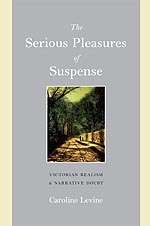 The Serious Pleasures of Suspense: Victorian Realism and Narrative Doubt
Caroline Levine
University of Virginia Press, 2003 Scholars have long recognized that narrative suspense dominates the formal dynamics of nineteenth-century British fiction, both high and low. But few have asked why suspense played such a crucial role in the Victorian novel--and in Victorian culture more broadly. The Serious Pleasures of Suspense argues that a startling array of nineteenth-century thinkers--from John Ruskin and Michael Faraday to Charlotte Brontë and Wilkie Collins--saw suspense as the perfect vehicle for a radically new approach to knowledge that they called "realism." Although by convention suspense has belonged to the realm of sensational mysteries and gothic horrors, and realism to the world of sober, reformist, middle-class domesticity, the two were in fact inextricably intertwined. The real was defined precisely as that which did not belong to the mind, that which stood separate from patterns of thought and belief. In order to get at the truth of the real, readers would have to learn to suspend their judgment. Suspenseful plots were the ideal vehicles for disseminating this experience of doubt, training readers to pause before leaping to conclusions.
Far from being merely low or sensational, the mysteries of many plotted texts were intended to introduce readers to a rigorous epistemological training borrowed from science. And far from being complacently conservative, suspense was deliberately employed to encourage a commitment to skepticism and uncertainty. In The Serious Pleasures of Suspense, Caroline Levine argues convincingly that the nineteenth-century critics were not wrong about suspense: the classic readerly text was indeed far more writerly--dynamic, critical, questioning, and indeterminate--than modern critics have been inclined to imagine.
Offering original readings of canonical texts, including Jane Eyre, Great Expectations, The Moonstone, and The Picture of Dorian Gray, and drawing on a range of historical sources, from popular fiction and art criticism to the philosophy of science and scientific biography, Levine combines narrative theory and the history of ideas to offer a stunning rereading of nineteenth-century realism.
--------------------------------------------------------------------------------
Caroline Levine is Assistant Professor of English at the University of Wisconsin, Madison, and the coeditor, with Mark W. Turner, of From Author to Text: Re-reading George Eliot's "Romola."
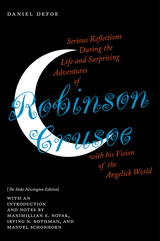 Serious Reflections During the Life and Surprising Adventures of Robinson Crusoe with his Vision of the Angelick World: The Stoke Newington Edition
Daniel Defoe
Bucknell University Press, 2022 Serious Reflections During the Life and Surprising Adventures of Robinson Crusoe with his Vision of the Angelick World, first published in 1720 and considered a sequel to The Farther Adventures of Robinson Crusoe, is a collection of essays written in the voice of the Crusoe character. Expressing Defoe’s thoughts about many moral questions of the day, the narrator takes up isolation, poverty, religious liberty, and epistemology. Defoe also used this volume to revive his interest in poetry, not the satiric poetry of the early eighteenth century, but the more inspirational verse that appeared in some of his later works. Serious Reflections also includes an imaginative flight in which Crusoe wanders among the planets, a return to the moon voyage impulse of Defoe’s 1705 work The Consolidator. Illuminating the ideas and philosophy of this most influential of English novelists, it is invaluable for any student of the period.
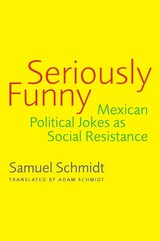 Seriously Funny: Mexican Political Jokes as Social Resistance
Samuel Schmidt, Translated by Adam Schmidt
University of Arizona Press, 2014 Political jokes exist around the world and across many types of political systems. But what purposes do they serve? Do they have an impact on politics—or on politicians? Surprisingly, scholars have paid scant attention to these significant questions. And, until the publication of this book, no one had ever systematically studied political humor in Mexico. When the first edition of this work was published in Mexico, it caused a stir. Elected officials, it turned out, had grudgingly accepted that they and their politics could be the target of jokes uttered in public, and even on television, but they were incensed that a leading academic had collected political jokes into a book and analyzed their function in a country that had experienced nearly a century of one-party rule.
Now available in English for the first time, Seriously Funny is a groundbreaking work. Its goal is to examine the ways in which political humor—including nicknames, anagrams, poems, and parodies of religious prayers, in addition to jokes—has developed and operated in one country over more than four centuries. Although political humor thrives in Mexico, it is often cleverly encoded so that it doesn’t appear to be critical of government policies or officials. But, writes Samuel Schmidt, that is precisely its purpose: to question the actions and assumptions of the party in power. Schmidt argues persuasively that political jokes are acts of minor rebellion: their objective is not to overthrow a government but to correct its mistakes.
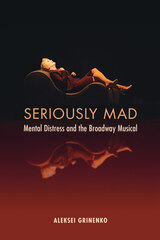 Seriously Mad: Mental Distress and the Broadway Musical
Aleksei Grinenko
University of Michigan Press, 2023 Theatermakers in the United States have long been drawn to madness as a source of dramatic spectacle. During the Broadway musical’s golden age in the mid-twentieth century, creative teams used the currently in-vogue psychoanalytic ideas about mental life to construct troubled characters at odds with themselves and their worlds. As the clinical and cultural profile of madness transformed over the twentieth century, musicals continued to delve into the experience of those living with mental pain, trauma, and unhappiness.
Seriously Mad offers a dynamic account of stage musicals’ engagement with historically significant theories about mental distress, illness, disability, and human variance in the United States. By exploring who is considered mad and what constitutes madness at different moments in U.S. history, Aleksei Grinenko shows how, in attempts to bring the musicals closer to highbrow sophistication, theater dramatized serious medical conditions and social problems. Among the many Broadway productions discussed are Next to Normal, A Strange Loop, Sweeney Todd, Man of La Mancha, Gypsy, Oklahoma!, and Lady in the Dark.
The Seris
David Burckhalter
University of Arizona Press, 1981 A collection of black and white photographs of the Seri Indians of Sonora, Mexico, including various portraits and descriptions of the subjects.
Sermons
Saint Leo the Great
Catholic University of America Press, 1995 It would be practically impossible to understand this monumental transition from the Roman world to Christendom without taking into account the pivotal role played by Leo the Great. In this regard, his sermons provide invaluable data for the social historian. It was Leo--and not the emperor--who went out to confront Attila the Hun. It was Leo who once averted and on another occasion mitigated the ravages of barbarian incursions. As significant as his contribution was to history, Leo had an even greater impact on theology.
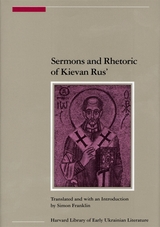 Sermons and Rhetoric of Kievan Rus’
Simon Franklin
Harvard University Press The authors included in this volume—Ilarion, Klim Smoljatic, and Kirill of Turov—are remarkable for both their personal and literary achievements. Appointed in 1051 by Prince Jaroslav the Wise, Ilarion was the first of only two recorded “native” metropolitans of Kiev. His “Sermon on Law and Grace” constitutes the finest piece of eleventh-century Rus’ rhetorical literature. Klim Smoljatic, the second “native” metropolitan of Rus’ (from 1147), is the author of the controversial “Epistle to Foma,” which addresses the debate over the proper nature and limits of Christian learning. Finally, the twelfth-century monk Kirill of Turov is best known for his collection of allegorical lessons and some of the most accomplished sermons of Kievan Rus’. The volume contains the first complete translations of the “Epistle to Foma” and the lessons and sermons of Kirill, as well as an entirely new rendering of the “Sermon on Law and Grace.”
Simon Franklin prefaces the texts with a substantial introduction that places each of the three authors in their historical context and examines the literary qualities as well as textual complexities of these outstanding works of Rus’ literature.
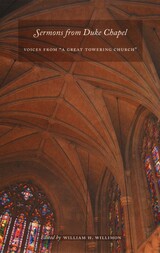 Sermons from Duke Chapel: Voices from "A Great Towering Church"
William H. Willimon, ed.
Duke University Press, 2005 Many of America’s greatest Protestant preachers—Paul Tillich, William Sloane Coffin, Barbara Brown Taylor, Fleming Rutledge, Peter J. Gomes, Billy Graham, and others—have spoken powerfully from the pulpit of the “great towering church” that is the spiritual and architectural center of Duke University. This collection of fifty-eight of the most notable sermons proclaimed from that pulpit commemorates the seventy-fifth anniversary of the groundbreaking for Duke Chapel. It is a sweeping panorama of sermons selected and edited by Bishop William H. Willimon, Dean of the Chapel for twenty years and one of the most widely read writers on preaching in America. Opening with the sermon preached in June 1935 at the dedication of the Chapel and closing with one by Willimon delivered at the beginning of the 2003–4 school year, this volume presents Protestant Christianity at its most eloquent and prophetic. Some sermons are pure meditations on biblical texts; others are period pieces in the best sense of the term, reflecting on such contemporary concerns as civil rights, the assassinations of Martin Luther King Jr. and Robert F. Kennedy, and the wars in Europe, Vietnam, and Iraq. Willimon provides a brief introduction to each sermon, commenting on the work and thought of the preacher. Diverse in subject and style, the sermons collected in this volume are a treasure for those who love fine preaching, a resource for those studying the history of homiletics, and a light to rekindle the memories of those who have worshiped in the Chapel over the years.
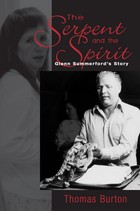 The Serpent And The Spirit: Glenn Summerford's Story
Thomas G Burton
University of Tennessee Press, 2004
“A snake handler convicted of the attempted murder of his wife by means of serpent bite is serving ninety-nine years in prison. The reader is gradually pulled into an increasingly complex story as Thomas Burton allows the many individuals involved in this event to tell their stories. Readers are less likely to find themselves concerned with what “really” happened than with larger issues they too will become involved in. this is more than a story about the headline ‘preacher tries to murder wife – with rattlesnakes!” it is a story of individuals struggling with their faith and their fate under the steady gaze of their God.” —Ralph W. Hood Jr., winner of the American Psychological Association’s William James Award in the psychology of religion
In this comprehensive, multilayered set of narratives, the story of Glenn Summerford’s fall from grace is told by its participants, through interviews, court documents, and other primary sources. Free of either prejudice against or romanticizing about the snake-handling Holiness religion, this book presents an absorbing story of a fascinating group of people, while allowing the reader to draw his or her own conclusions about Summerford’s guilt or innocence. The Serpent and the Spirit is a startling commentary on truth and its representation, religion and its expression, humanity and its flaws.
Thomas Burton is professor emeritus of English at East Tennessee State University. He is the winner of the Appalachian Consortium Laurel Leaves Award.
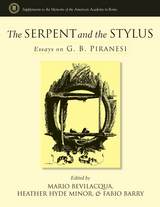 The Serpent and the Stylus: Essays on G. B. Piranesi
Edited by Mario Bevilacqua, Heather Hyde Minor, and Fabio Barry
University of Michigan Press, 2006 Piranesi was an architect, engraver, antiquities restorer and dealer, draftsman, archaeologist, furniture and fireplace designer, author, and bookseller. His creations in paper and in stone garnered considerable renown in his own lifetime, allowing him to transform himself from a penniless son of a stonemason to a wealthy entrepreneur. However, despite attempts to catalogue and analyze his work, little is known about Piranesi. Since Henri Focillon published his monograph on the artist in 1918, scholars have sought to expand his interpretive strategies used to examine Piranesi and his work. This volume is a representative sampling of the contemporary scholarship on Piranesi, with each essay scrutinizing a particular aspect of his oeuvre. By engaging with material found in eighteenth-century manuscripts and printed materials, as well as the texts and images Piranesi produced, the nine essays by esteemed contributors add to the rapidly growing and diversifying field of eighteenth-century studies. The outcome is a volume that will add to the expanding, glittering mosaic of Piranesi’s life and his work. Mario Bevilacqua is Associate Professor at the University of Florence, Italy. Heather Hyde Minor is Assistant Professor at the University of Illinois, Urbana-Champaign. Fabio Barry is Assistant Professor at the American University of Rome, Italy.
 The Serpent and the Swan: The Animal Bride in Folklore and Literature
Boria Sax
University of Tennessee Press, 2001 The Serpent and the Swan is a history and analysis of animal bride tales from antiquity to the present. The animal bride tale, the author argues, is an enduring expression of humankind's need to remain close to and a part of nature.
Boria Sax traces the idea of the animal bride through history by drawing upon legends and literary works from throughout the world. He pays particular attention to Eurasian sources which support his thesis that the animal bride theme originated among the serpent cults of Mesopotamia and southeastern Europe. Through time, the details of the animal bride theme changed as a result of mankind's changing perceptions of the natural world. In general, this study is an account of myths and beliefs that have surrounded animals—and women—during the rise of modern humankind.
The Serpent and the Swan identifies and explains images of the animal bride that pervade, enliven, and enrich our culture. The bride becomes Eve taking an apple from the serpent, Medea casting spells, Cinderella riding to the royal ball in a pumpkin coach, and the Little Mermaid rising from the waves.
The Author: Boria Sax, who holds a doctorate in German and intellectual history, is the author of The Frog King and The Parliament of Animals, among other books.
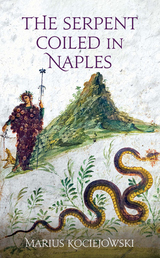 The Serpent Coiled in Naples
Marius Kociejowski
Haus Publishing, 2023 A travelogue revealing the hidden stories of Naples.
In recent years Naples has become, for better or worse, the new destination in Italy. While many of its more unusual features are on display for all to see, the stories behind them remain largely hidden. In Marius Kociejowski’s portrait of this baffling city, the serpent can be many things: Vesuvius, the mafia-like Camorra, the outlying Phlegrean Fields (which, geologically speaking, constitute the second most dangerous area on the planet). It is all these things that have, at one time or another, put paid to the higher aspirations of Neapolitans themselves. Naples is simultaneously the city of light, sometimes blindingly so, and the city of darkness, although often the stuff of cliché. The boundary that separates death from life is porous in the extreme: the dead inhabit the world of the living and vice versa. The Serpent Coiled in Naples is a travelogue, a meditation on mortality, and much else besides.
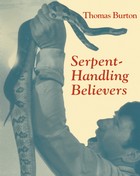 Serpent Handling Believers
Thomas G Burton
University of Tennessee Press, 1993 In some remote churches in East Tennessee and nearby states, Jesus’ words in the sixteenth chapter of Saint Mark are taken literally: “and they shall take up serpents; and if they drink any deadly thing, it shall not hurt them.”Members of these churches describe themselves as Pentecostal-Holiness, autonomous groups of Christians with strong traditional religious views and a fundamentalist approach to biblical interpretation. Their strong faith is based largely on personal experience. Handling serpents and fire, laying on the hands of healing, speaking in tongues, and drinking poison are seen as acts of Christian obedience that demonstrate the power of the Holy Spirit.
In the past these very religious people have often been distorted by the media as members of a “snake religion” or a “snake cult” because of their unorthodox beliefs and practices. Thomas Burton seeks to present a more balanced view of this generally misunderstood group in this in-depth study of serpent handlers and their religious culture. Using both oral history and scholarly research, Burton traces the evolution of Christian serpent handling from its apparent beginning in East Tennessee and explores legal and ethical issues associated with this and other unorthodox practices, allowing participants to speak for themselves through personal interviews. The result is both a dramatic presentation, through vivid photography, and a thorough analytical insight into the serpent handlers’ culture.
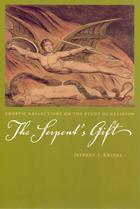 The Serpent's Gift: Gnostic Reflections on the Study of Religion
Jeffrey J. Kripal
University of Chicago Press, 2006 “Because thou hast done this, thou art cursed above all cattle, and above every beast of the field.” With those words in Genesis, God condemns the serpent for tempting Adam and Eve, and the serpent has shouldered the blame ever since. But how would the study of religion change if we looked at the Fall from the snake’s point of view? Would he appear as a bringer of wisdom, more generous than the God who wishes to keep his creation ignorant?
Inspired by the early Gnostics who took that startling view, Jeffrey J. Kripal uses the serpent as a starting point for a groundbreaking reconsideration of religious studies and its methods. In a series of related essays, he moves beyond both rational and faith-based approaches to religion, exploring the erotics of the gospels and the sexualities of Jesus, John, and Mary Magdalene. He considers Feuerbach’s Gnosticism, the untapped mystical potential of comparative religion, and even the modern mythology of the X-Men.
Ultimately, The Serpent’s Gift is a provocative call for a complete reorientation of religious studies, aimed at a larger understanding of the world, the self, and the divine.
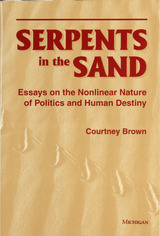 Serpents in the Sand: Essays in the Nonlinear Nature of Politics and Human Destiny
Courtney Brown
University of Michigan Press, 1995 For decades, social scientists have worked with models that have sought to quantify and explain human behavior. The common foundation for nearly all of these mathematical applications is the assumption of linear progression, equilibrium, and stability. Serpents in the Sand not only argues that political life is fundamentally nonlinear but thoroughly analyzes specific instances of extreme nonlinearity in politics. By so doing, Courtney Brown offers a guide to the reader on how to apply nonlinearity, including chaos theory, to real-world situations. The author develops his argument by in-depth analysis of four examples covering a broad spectrum of political life. He considers, first, the relationship between individual rationality and the influence of a voter's political milieu. He then turns to look at the dynamics behind the Johnson vs. Goldwater landslide presidential election of 1964. The fall of the Weimar Republic and the rise of Nazi Germany provide a third case study, followed, by an analysis of the relationship between democratic electoral politics and the ecological environment. Highly original in its finding, Serpents in the Sand resembles no other work on politics. It is the first study of nonlinearity in political behavior to base its argument on specific examples rather than on analogies to physical and ecological systems. Substantively, the book draws provocative conclusions from the test cases, examining for instance the potential for disaster in the oscillatory relationship between the way U.S. presidents are elected and the management of the country's environment. In the end, Serpents in the Sand extends its argument to the philosophy of human existence, showing that human behavior is as nonlinear as all other processes in the universe. Courtney Brown is Associate Professor of Political Science, Emory University.
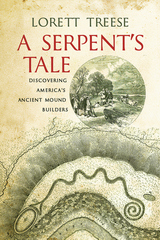 A Serpent's Tale: Discovering America's Ancient Mound Builders
Lorett Treese
Westholme Publishing, 2016 The Fascinating Story of the Enigmatic Monuments that Inspired American Archaeology
When American settlers first crossed the Appalachian Mountains they were amazed to discover that the wilderness beyond contained ancient ruins—large man-made mounds and enclosures, and impressive earthen sculptures, such as a gigantic serpent. Reports trickled back to the eager ears of President Thomas Jefferson and others. However, most did not believe these earthworks had anything to do with Native Americans; rather, given the intense interest in the history of Western Civilization at the time, it became popular to speculate that the ruins had been built by refugees from Greece, Rome, Egypt—or even the lost continent of Atlantis. Since their discovery, the mounds have attracted both scholars and quacks, from the early investigations sponsored by the then new Smithsonian Institution to the visions of the American psychic Edgar Cayce.
As Lorett Treese explains in her fascinating history A Serpent’s Tale: Discovering America’s Ancient Mound Builders, the enigmatic nature of these antiquities fueled both fanciful claims and scientific inquiry. Early on, the earthworks began to fall to agricultural and urban development. Realizing that only careful on-site investigation could reveal the mysteries of the mounds, scholars hastened to document and classify them, giving rise to American archaeology as a discipline. Research made it possible to separate the Mound Builders into three distinct pre-contact Native American cultures. More recently, Mound Builder remains have attracted the practitioners of new disciplines like archaeoastronomy who suggest they may have functioned as calendars. There is no doubt that the abandoned monuments that made the Midwest’s Ohio Valley the birthplace of American archaeology have yet to reveal all the knowledge they contain on the daily lives and world views of persons of North American prehistory.
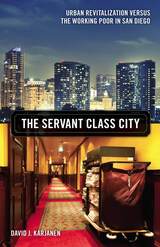 The Servant Class City: Urban Revitalization versus the Working Poor in San Diego
David J. Karjanen
University of Minnesota Press, 2016 San Diego, California, is frequently viewed as a model for American urban revitalization. It looks like a success story, with blight and poverty replaced by high-rises and jobs. But David J. Karjanen shows that the much-touted job opportunities for poor people have been concentrated in low-paying service work as the cost of living in San Diego has soared. The Servant Class City documents how, over a period of three decades, San Diego’s urban transformation actually eroded the economic standing of the city’s working poor. Karjanen demonstrates that urban policy in San Diego, which has been devoted to increasing tourism, has fostered the creation of jobs that do not actually provide either livable wages or paths to upward mobility. Marshaling a wealth of heretofore uncollected data, he challenges the presumption that decades-long stagnation of job mobility in the united states is a result of insufficient worker training or a “skills mismatch,” or is attributable to various personal qualities of the urban poor. Karjanen interweaves profiles of people with a compelling presentation of data. Each chapter addresses a significant topic: hospitality industry jobs, retail work, informal employment, “fringe banking,” and economic barriers to mobility. In revealing the true story of the “poverty traps” that are associated with low-wage jobs in the service economy, The Servant Class City complicates the rosy picture of life in an American tourist boomtown.
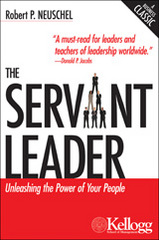 The Servant Leader: Unleashing the Power of Your People
Robert P. Neuschel
Northwestern University Press, 2005 In The Servant Leader, Robert P. Neuschel makes the case that our leadership is experiencing a diminution in ethics and a loss of enduring values. These weakening factors are exacerbated by a preoccupation with the short term. As Neuschel puts it, "We are more concerned about achieving quick shareholder value than building an enduring organization that can increase its capacity to produce useful products or services more competitively and more effectively on an enduring basis." He lays the blame at the feet of our corporate leadership.
He asks: what steps might we take to revitalize the quality and strength of our leadership? He then forcefully and straightforwardly gives an outline of what he believes are the major changes in leadership we must bring about. As a professor of management and strategy, and earlier, as a director and senior partner at a major consulting firm, and as a captain in the U. S. Army, Neuschel observed the best of leadership, and practiced it. He shares his insights with us in The Servant Leader.
The Servant's Hand: English Fiction from Below
Bruce W. Robbins
Duke University Press, 1993 A work of innovative literary and cultural history, The Servant's Hand examines the representation of servants in nineteenth-century British fiction. Wandering in the margins of these texts that are not about them, servants are visible only as anachronistic appendages to their masters and as functions of traditional narrative form. Yet their persistence, Robbins argues, signals more than the absence of the "ordinary people" they are taken to represent. Robbins's argument offers a new and distinctive approach to the literary analysis of class, while it also bodies forth a revisionist counterpolitics to the realist tradition from Homer to Virginia Woolf. Originally published in 1986 (Columbia University Press), The Servant's Hand is appearing for the first time in paperback.
 Service and Procedures in Bureaucracy: A Case Study
Roy G. Francis and Robert C. Stone
University of Minnesota Press, 1956
Service and Procedures in Bureaucracy was first published in 1956. Minnesota Archive Editions uses digital technology to make long-unavailable books once again accessible, and are published unaltered from the original University of Minnesota Press editions.
Large, complex systems of organization, such as government bureaus, giant corporations, and massive trade unions, play a decisive role in the daily lives of millions of people and exert an important influence upon national and even international affairs. This gives major sociological significance to the bureaucratic organizations of such groups.
The research reported here was undertaken to test two widespread beliefs about modern, largescale organizations, and the findings point to modifications in what has been regarded as the classic sociological concept of bureaucracy.
Does the personnel in bureaucracies commonly substitute rule-following, preoccupation with procedure, for the intended service purpose of the organization? And are bureaucracies characterized by impersonality, that is, detachment of office from individual, so that relations are between offices rather than between individuals? These are the questions the authors sought to answer in their study of the Louisiana Division of Employment Security. They observed employees working at their jobs, conducted interviews, administered questionnaires, and studied the official documents and records of the organization.
Here is a picture of bureaucracy in real life that will provide valuable insight to those actively concerned with administration and personnel problems, as well as to students in the social sciences.
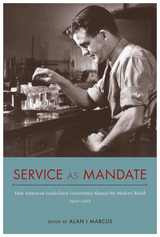 Service as Mandate: How American Land-Grant Universities Shaped the Modern World, 1920–2015
Edited by Alan I Marcus
University of Alabama Press, 2015 Established by the Morrill Land-Grant College Act of 1862, America’s land-grant universities have had far-reaching influences on the United States and the world. Service as Mandate, Alan I Marcus’s second edited collection of insightful essays about land-grant universities, explores how these universities have adapted to meet the challenges of the past sixty-five years and how, having done so, they have helped to create the modern world.
From their founding, land-grant schools have provided educational opportunities to millions, producing many of the nation’s scientific, technical, and agricultural leaders and spawning countless technological and agricultural innovations. Nevertheless, their history has not always been smooth or without controversy or setbacks. These vital centers of learning and research have in fact been redefined and reconceptualized many times and today bear only a cursory resemblance to their original incarnations.
The thirteen essays in this collection explore such themes as the emphasis on food science and home economics, the country life movement, the evolution of a public research system, the rise of aerospace engineering, the effects of the GI Bill, the teaching of military science, the sustainable agriculture movement, and the development of golf-turf science. Woven together, these expertly curated scenes, vignettes, and episodes powerfully illustrate these institutions’ ability to flex and adapt to serve the educational needs of an ever-changing American citizenry.
By dint of their mission to remedy social, economic, and technical problems; to improve standards of living; and to enhance the quality of life, land-grant universities are destined and intended to be agents of change—a role that finds them at times both celebrated and hotly contested, even vilified. A readable and fascinating exploration of land-grant universities, Service as Mandate offers a vital exploration of these dynamic institutions to educators, policy makers, students, and the wider communities that land-grant universities serve.
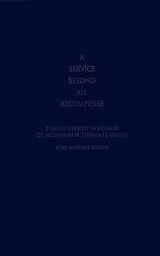 A Service Beyond All Recompense
Kurt Martens
Catholic University of America Press, 2018 When Monsignor Thomas J. Green, professor at the School of Canon Law at The Catholic University of America, approached his seventy-fifth birthday and the fiftieth anniversary of his priestly ordination, his colleagues planned on offering him a fitting tribute in the form of a festschrift. Six people with different backgrounds, but all related to Msgr. Green on one way or another, have written a laudatio – a short congratulatory letter – in honor of Monsignor Green. No less than fifteen contributions on various topics by colleagues, canon law scholars, clearly relate and reflect upon the honoree's scholarly contributions to canon law. The topics are extremely varied, and illustrate how Monsignor Green has been or is active in nearly every area of canon law. Virtually every book of the Code of Canon Law is covered, if not directly, at least indirectly. While the book is a tribute to an eminent professor, the various scholarly contributions are unique pieces of scholarship. The authors of the laudatio are: John Garvey (President, The Catholic University of America); Andrew Abela (Provost, The Catholic University of America); Rev. Msgr. J. Brian Bransfield (General Secretary of the United States Conference of Catholic Bishops); Rev. Msgr. Ronny E. Jenkins (Dean, School of Canon Law, The Catholic University of America); Rev. Msgr. J. James Cuneo (Diocese of Bridgeport) and Sister Sharon Euart, RSM (Executive Director, Resource Center for Religious Institutes, Silver Spring, MD).
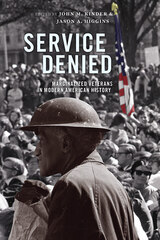 Service Denied: Marginalized Veterans in Modern American History
Edited by John M. Kinder and Jason A. Higgins
University of Massachusetts Press, 2022 Wartime military service is held up as a marker of civic duty and patriotism, yet the rewards of veteran status have never been equally distributed. Certain groups of military veterans—women, people of color, LGBTQ people, and former service members with stigmatizing conditions, “bad paper” discharges, or criminal records—have been left out of official histories, excised from national consciousness, and denied state recognition and military benefits. Chronicling the untold stories of marginalized veterans in the twentieth and twenty-first centuries, Service Denied uncovers the generational divides, cultural stigmas, and discriminatory policies that affected veterans during and after their military service. Together, the chapters in this collection recast veterans beyond the archetype, inspiring an innovative model for veterans studies that encourages an intersectional and interdisciplinary analysis of veterans history. In addition to contributions from the volume editors, this collection features scholarship by Barbara Gannon, Robert Jefferson, Evan P. Sullivan, Steven Rosales, Heather Marie Stur, Juan Coronado, Kara Dixon Vuic, John Worsencroft, and David Kieran.
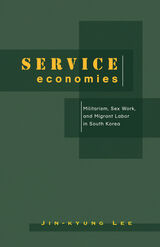 Service Economies: Militarism, Sex Work, and Migrant Labor in South Korea
Jin-kyung Lee
University of Minnesota Press, 2010 Service Economies presents an alternative narrative of South Korean modernity by examining how working-class labor occupies a central space in linking the United States and Asia to South Korea's changing global position from a U.S. neocolony to a subempire.
Making surprising and revelatory connections, Jin-kyung Lee analyzes South Korean military labor in the Vietnam War, domestic female sex workers, South Korean prostitution for U.S. troops, and immigrant/migrant labor from Asia in contemporary South Korea. Foregrounding gender, sexuality, and race, Lee reimagines the South Korean economic "miracle" as a global and regional articulation of industrial, military, and sexual proletarianization.
Lee not only addresses these under-studied labors individually but also integrates and unites them to reveal an alternative narrative of a changing South Korean working class whose heterogeneity is manifested in its objectification. Delving into literary and popular cultural sources as well as sociological work, Lee locates South Korean development in its military and economic interactions with the United States and other Asian nation-states, offering a unique perspective on how these practices have shaped and impacted U.S.-South Korea relations.
Service in a Time of Suspicion: Experiences of Muslims Serving in the U.S. Military Post-9/11
Michelle Sandhoff
University of Iowa Press, 2017 On September 11, 2001, nineteen members of the Islamist extremist organization al-Qaeda launched four coordinated attacks on the United States, killing 2,977 people. These events and the government’s subsequent “War on Terror” refueled long-standing negative stereotypes about Muslims and Islam among many Americans. And yet thousands of practicing Muslims continued to serve or chose to enlist in the U.S. military during these years.
In Service in a Time of Suspicion, fifteen such service members talk about what it means to be Muslim, American, and a uniformed member of the armed services in the twenty-first century. These honest accounts remind us of our shared humanity.
 Service Learning
Edited by Joan Schine
University of Chicago Press, 1997 In the current wave of school reform, service learning is frequently cited as a strategy for engaging disaffected students and for developing the habits and attitudes of constructive citizenship. This volume brings together a variety of current perspectives on the theory and practice of service learning.
Although a small number of schools and colleges have incorporated service learning in their curricula for many years, only in the last decade has it become the object of extensive study for researchers, scholars, and practitioners, as well as for policymakers and the general public. The Yearbook includes a historical overview, discussion of the roles of state and federal government in establishing and supporting service learning, and descriptions of existing programs at the school and college level. A theoretical framework for service learning is delineated, existing research is described, and additional areas for research and evaluation are suggested.
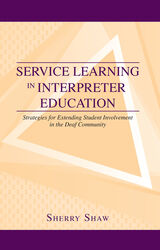 Service Learning in Interpreter Education: Strategies for Extending Student Involvement in the Deaf Community
Sherry Shaw
Gallaudet University Press, 2013 Institutions of higher learning around the nation have embraced the concept of student civic engagement as part of their curricula, a movement that has spurred administrators in various fields to initiate programs as part of their disciplines. In response, sign language interpreting educators are attempting to devise service-learning programs aimed at Deaf communities. Except for a smattering of journal articles, however, they have had no primary guide for fashioning these programs. Sherry Shaw remedies this in her new book Service Learning in Interpreter Education: Strategies for Extending Student Involvement in the Deaf Community.
Shaw begins by outlining how to extend student involvement beyond the field experience of an internship or practicum and suggests how to overcome student resistance to a course that seems atypical. She introduces the educational strategy behind service-learning, explaining it as a tool for re-centering the Deaf community in interpreter education. She then provides the framework for a service-learning course syllabus, including establishing Deaf community partnerships and how to conduct student assessments.
Service Learning in Interpreter Education concludes with first-person accounts from students and community members who recount their personal and professional experiences with service learning. With this thorough guide, interpreter education programs can develop stand-alone courses or modules within existing coursework.
A Service of Love
Paul McPartlan
Catholic University of America Press, 2013 In this short and penetrating study, Paul McPartlan, a member of the international Roman Catholic-Orthodox theological dialogue, presents a proposal, carefully argued both historically and theologically, for a primacy exercising a service of love in a reconciled church, West and East.
A Service of Love
Paul McPartlan
Catholic University of America Press, 2016 "Msgr Paul McPartlan's book constitutes a significant contribution to the theological dialogue between the Roman Catholic and the Orthodox Churches. It combines valuable historical information with deep theological insights by presenting the development of papal primacy in the two millennia of Church history in close connection with collegiality and the Eucharist. A scholarly work with particular importance for the discussion of one of the most crucial issues in ecclesiology and ecumenism. It is warmly recommended for study by all those interested in the promotion of Christian unity." -Metropolitan John (Zizioulas) of Pergamon
Service: Poems
Bruce Lack
Texas Tech University Press, 2015 What Bruce Lack offers in the poems in Service is truth—complex, ambiguous, paradoxical, contradictory, impossible—about the experiences of a Marine fighting the Iraq War and the jarring transition that comes with returning home to find the war reduced to background noise for a remote civilian population. Bruce Lack’s forceful, authentic poetry confronts the human cost of sending young men and women to fight a war of questionable justification against an insurgency unbound by rules of engagement. Lack’s poems engage honestly with the frustration of fighting an elusive, ruthless enemy, the guilt of surviving when others do not, and the residual anger that may never
leave the generation of veterans of the War on Terror. Written in the voice of the Marine but directed toward and accessible to the civilian, Service is a book that seeks to close the communication gap between the two.
The Service Sector in Soviet Economic Growth: A Comparative Study
Gur Ofer
Harvard University Press, 1973 The service sector represents a smaller share of the national economy in the Soviet Union than in other countries at similar levels. This gap is found in trade, in private and business services, and, surprisingly, in public administration. Gur Ofer provides a twofold examination of this phenomenon. He uses cross country comparisons to study the “normal” relationships between the size of the service institutions and economic development. At the same time he investigates specific factors operating in Socialist and Soviet countries, thus uniting the special Soviet case with general development theory.
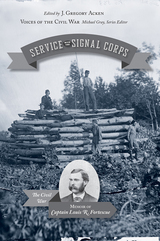 Service with the Signal Corps: The Civil War Memoir of Captain Louis R. Fortescue
J. Gregory Acken
University of Tennessee Press, 2014 "This book provides very informative and fascinating insight into the experiences of a Signal Corps officer of the Union Army.” —Steven J. Rausch, U.S. Army Signal Corps historian
In 1854 an assistant surgeon named Albert J. Myer entered the Union Army and created a system of transmitting information that would revolutionize military communications. His flag-and-torch system led to the formation of the U.S. Army Signal Corps. Major Myer selected only educated men for this new arm of the military, and among these was twenty-three-year-old Louis R. Fortescue. Fortescue’s memoir, written in the postwar years but based on his wartime diaries, offers a rare view of this lesser-known support arm of the Union army.
The Signal Corps originally met with resistance, particularly from high-ranking Regular Army officers, but the men who served in the corps—including Fortescue—took great pride in their duties and eventually succeeded in changing the minds of their unit’s detractors by achieving the most basic, but often bedeviling, strategic objective on any battlefield: effective communication. Fortescue’s memoir not only presents a unique look at the corps, but it also provides important insights into the war as a whole. Fortescue experienced the conflict from several perspectives—infantry subaltern, signal officer, aide-de-camp (briefly), and prisoner of war—and took an active role in a number of significant campaigns and battles. Fortescue’s ardent opinions on the war, President Lincoln, army commanders, and the South are expressed without reservation, making this account a must-read for anyone interested in how Civil War veterans understood their cause and interpreted their experiences.
Expertly edited by J. Gregory Acken to place events in chronological order and make the text as complete and accessible to the reader as possible, this remarkable record of Fortescue’s Civil War service fills a much-needed void in the historiography of the conflict. As the first full-length, published memoir to deal with Civil War Signal Corps service, this book provides a glimpse into the most tumultuous era in the nation’s history from an underexplored new perspective.
J. Gregory Acken served for twelve years on the Board of Governors of theCivil War Library and Museum of Philadelphia. He is the editor of Inside the Army
of the Potomac: The Civil War Experience of Captain Francis Adams Donaldson. He lives in New Jersey.
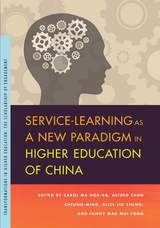 Service-Learning as a New Paradigm in Higher Education of China
Carol Ma Hok-ka
Michigan State University Press, 2018 The first reference book to introduce the concept and development of service-learning in China, Service-Learning as a New Paradigm in Higher Education of China provides a full picture of the infusion of service-learning into the Chinese educational system and describes this new teaching experience using case studies, empirical data, and educational and institutional policies within Chinese context. The text demonstrates how students learn outside the classroom through service-learning with valuable feedback and reflection from faculty members and fellow students about the meaning of education in China. Though service-learning was initially developed in the United States, the concept is rooted in Chinese literatures and values. This book will help readers understand how service-learning is being used as a pedagogy with Chinese values and philosophy in Chinese education, filling a niche within the worldwide literature of service-learning.
Service-Learning: What Every ESL Teacher Needs to Know
Trisha Dowling and James M. Perren
University of Michigan Press, 2021 Service-Learning: What Every ESL Teacher Needs to Know gives practical information on implementing service-learning in the field of TESOL. Service-learning—"the accomplishment of tasks that meet genuine human needs in combination with conscious educational growth"—has developed into a pedagogical approach that incorporates student learning and reflection with curricular concepts while partnering with community organizations. Following an overview of service-learning in the field of TESOL, this text includes sections on incorporating service-learning in an ESL course, finding appropriate community partnerships, making decisions about culture- and language-based lessons, assessing students, and making the experience meaningful. Also included are four specific strategies to help readers make the case for service-learning to administrators.
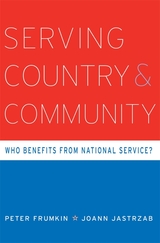 Serving Country and Community: Who Benefits from National Service?
Peter Frumkin and JoAnn Jastrzab
Harvard University Press, 2010 The United States has a long history of citizens rendering service to their communities. Examples of government-sponsored voluntary service organizations include the Civilian Conservation Corps, the Peace Corps, and Volunteers in Service to America (VISTA). During the Clinton administration, the national service movement was advanced by the establishment of AmeriCorps, a large-scale national service program designed to place young people in community service positions across the country. More recently, the Obama administration has set in motion a major program expansion of AmeriCorps over the coming decade.
Many decades, billions of dollars, and hundreds of thousands of volunteers after the creation of the first national service programs, it remains unclear who benefits from service, under what conditions these programs work best, and how exactly these service efforts contribute to the strengthening of communities. Serving Country and Community answers each of these questions through an in-depth study of how service shapes the lives of young people and a careful analysis of the strengths and weaknesses of these programs. Based on years of field work and data collection, Serving Country and Community provides an in-depth examination of the aims and effects of national service and, in the process, opens up a conversation about what works and what needs reform in national service today.
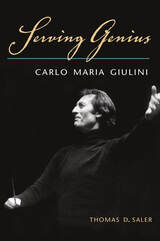 Serving Genius: Carlo Maria Giulini
Thomas D. Saler
University of Illinois Press, 2020 Serving Genius tells the life story of Carlo Maria Giulini, one of the most renowned and beloved conductors of the twentieth century. Detailing Giulini's extraordinary professional career, Thomas D. Saler also chronicles Giulini's personal life, including his musical awakening while growing up amid the spectacular beauty of the Dolomite mountains, his years as a student in Rome's Academy of St. Cecilia, his conscription into the Italian army during World War II, his nine months in hiding for his anti-fascist and pacifist beliefs, and his selfless devotion to his wife, Marcella. A humble master who shunned the limelight, Giulini took a deeply emotional and subjective approach to making music. Saler provides uniquely detailed analysis of Giulini's nuanced musicianship and the way he conveyed that musicianship to the orchestra through physical gestures. Meditating on the very art of conducting at which Giulini excelled, Saler discusses each of the conductor's major musical appointments, including stints with the Chicago Symphony Orchestra, Philharmonia Orchestra, Vienna Symphony, and Los Angeles Philharmonic. The book also addresses his repertoire of choice, leadership style, and moral framework. Drawing on extensive interviews with Giulini's family, music critics, arts administrators, orchestra members, and collaborating soloists, Serving Genius draws out the personal amid the professional life of this giant among twentieth-century conductors.
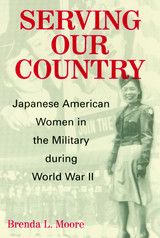 Serving Our Country: Japanese American Women in the Military during World War II
Moore, Brenda L
Rutgers University Press, 2003 Following the 1941 attack on Pearl Harbor and America's declaration of war on Japan, the U.S. War Department allowed up to five hundred second-generation, or "Nisei," Japanese American women to enlist in the Women's Army Corps and, in smaller numbers, in the Army Medical Corps. Through in-depth interviews with surviving Nisei women who served, Brenda L. Moore provides fascinating firsthand accounts of their experiences. Interested primarily in shedding light on the experiences of Nisei women during the war, the author argues for the relevance of these experiences to larger questions of American race relations and views on gender and their intersections, particularly in the country's highly charged wartime atmosphere. Uncovering a page in American history that has been obscured, Moore adds nuance to our understanding of the situation of Japanese Americans during the war.
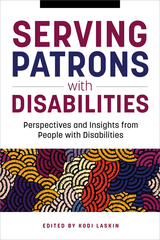 Serving Patrons with Disabilities: Perspectives and Insights from People with Disabilities
Edited by Kodi Laskin
American Library Association, 2023 Ensuring accessibility is more important than ever; however, answering questions of what needs to be done and why to make a library accessible can be an uncomfortable and daunting hurdle to true inclusion. This book is a safe, nonjudgmental tool for overcoming this awkwardness, offering readers practical, to-the-point information and guidance that complies with the Americans with Disabilities Act (ADA). Its contributors showcase real-world stories and viewpoints that illustrate ways to provide excellent customer service and a safe environment to all patrons regardless of ability. Readers will learn about - bridging the gap between people with disabilities and those without, through empathy, patience, and understanding;
- techniques for training staff and overcoming discomfort;
- making your library accessible for people with mobility issues;
- how to interact with and assist a person with limited sight or hearing;
- guidance for interacting with a service animal handler;
- advice on library programming for people with learning differences; and
- best practices for effective service to patrons who use a speech assistance device.
 Serving the Academic, Social, and Emotional Needs of Multicultural Newcomers
Brenda Custodio and Judith B. O’Loughlin
University of Michigan Press, 2025 As newcomers—immigrant students who have been in the U.S. less than two years—arrive in record numbers, many school districts are looking for ways to best support these new arrivals. Serving the Academic, Social, and Emotional Needs of Multicultural Newcomers offers a research-based overview of newcomer students across the nation and provides specific strategies for helping them integrate into U.S. schools in a variety of settings (ESL, bilingual, mainstream/content classrooms). In addition to a brief overview of how newcomer programs can provide academic and social-emotional services for recently arrived English learners, the authors draw on their experience to offer five best practices for serving newcomers. Readers will learn how to: - Collaborate with school professionals to create a program specifically to meet the unique needs of new arrivals.
- Provide intensive literacy, numeracy, and content area support, especially for students with interrupted schooling.
- Develop the classroom supports necessary for students to achieve academic success.
- Provide supports that address the physical, social, and emotional challenges of newcomers.
- Work with families and communities to support students outside of a school environment.
With reflective questions at the end of each chapter, this book is designed to be used as a textbook with study groups or as a self-study resource for professional development.
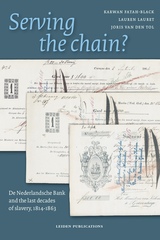 Serving the chain?: De Nederlandsche Bank and the last decades of slavery, 1814-1863
Karwan Fatah-Black
Leiden University Press, 2024 "In the nineteenth century, when the principal cultural, political, and financial institutions of the Netherlands were established, slavery was still very much part of the nation’s global imperial structures. Dutch families, institutions, and governments are increasingly interested in the role their predecessors played in this history of colonialism and enslavement. This book is a history of De Nederlandsche Bank in which particular attention is paid to its links with slavery, both as a factor in the economy and as a subject of political debate. Because De Nederlandsche Bank served the Dutch ministery of Colonies and consequently followed Dutch trade interests, the bank's history intersects with the history of slavery. The investigation in this book focuses not only upon DNB’s formal involvement but also on the private involvement of its directors. In addition, it examines whether the bank and its directors played any role in the abolition of slavery."
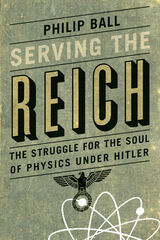 Serving the Reich: The Struggle for the Soul of Physics under Hitler
Philip Ball
University of Chicago Press, 2014 The compelling story of leading physicists in Germany—including Peter Debye, Max Planck, and Werner Heisenberg—and how they accommodated themselves to working within the Nazi state in the 1930s and ’40s.
After World War II, most scientists in Germany maintained that they had been apolitical or actively resisted the Nazi regime, but the true story is much more complicated. In Serving the Reich, Philip Ball takes a fresh look at that controversial history, contrasting the career of Peter Debye, director of the Kaiser Wilhelm Institute for Physics in Berlin, with those of two other leading physicists in Germany during the Third Reich: Max Planck, the elder statesman of physics after whom Germany’s premier scientific society is now named, and Werner Heisenberg, who succeeded Debye as director of the institute when it became focused on the development of nuclear power and weapons.
Mixing history, science, and biography, Ball’s gripping exploration of the lives of scientists under Nazism offers a powerful portrait of moral choice and personal responsibility, as scientists navigated “the grey zone between complicity and resistance.” Ball’s account of the different choices these three men and their colleagues made shows how there can be no clear-cut answers or judgment of their conduct. Yet, despite these ambiguities, Ball makes it undeniable that the German scientific establishment as a whole mounted no serious resistance to the Nazis, and in many ways acted as a willing instrument of the state.
Serving the Reich considers what this problematic history can tell us about the relationship between science and politics today. Ultimately, Ball argues, a determination to present science as an abstract inquiry into nature that is “above politics” can leave science and scientists dangerously compromised and vulnerable to political manipulation.
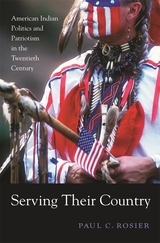 Serving Their Country: American Indian Politics and Patriotism in the Twentieth Century
Paul C. Rosier
Harvard University Press, 2009 Over the twentieth century, American Indians fought for their right to be both American and Indian. In an illuminating book, Paul C. Rosier traces how Indians defined democracy, citizenship, and patriotism in both domestic and international contexts.
Battles over the place of Indians in the fabric of American life took place on reservations, in wartime service, in cold war rhetoric, and in the courtroom. The Society of American Indians, founded in 1911, asserted that America needed Indian cultural and spiritual values. In World War II, Indians fought for their ancestral homelands and for the United States. The domestic struggle of Indian nations to defend their cultures intersected with the international cold war stand against termination—the attempt by the federal government to end the reservation system. Native Americans seized on the ideals of freedom and self-determination to convince the government to preserve reservations as places of cultural strength. Red Power activists in the 1960s and 1970s drew on Third World independence movements to assert an ethnic nationalism that erupted in a series of protests—in Iroquois country, in the Pacific Northwest, during the occupation of Alcatraz Island, and at Wounded Knee.
Believing in an empire of liberty for all, Native Americans pressed the United States to honor its obligations at home and abroad. Like African Americans, twentieth-century Native Americans served as a visible symbol of an America searching for rights and justice. American history is incomplete without their story.
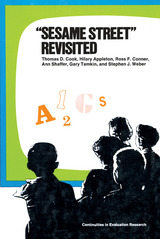 Sesame Street Revisited
Thomas D. Cook
Russell Sage Foundation, 1975 In the course of its television lifetime, "Sesame Street" has taught alphabet-related skills to hundreds of thousands of preschool children. But the program may have attracted more of its regular viewers from relatively affluent homes in which the parents were better educated. Analyzing and reevaluating data drawn from several sources, principally the Educational Testing Service's evaluations of "Sesame Street," the authors of this book open fresh lines of inquiry into how much economically disadvantaged children learned from viewing the series for six months and into whether the program is widening the gap that separates the academic achievement of disadvantaged preschoolers from that of their more affluent counterparts. The authors define as acute dilemma currently facing educational policymakers: what positive results are achieved when a large number of children learn some skills at a younger age if this absolute increase in knowledge is associated with an increase in the difference between social groups?
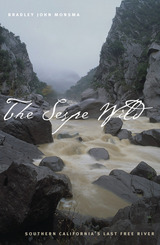 The Sespe Wild: Southern California'S Last Free River
Bradley John Monsma
University of Nevada Press, 2007 A hundred miles northwest of Los Angeles, Sespe Creek flows through some of the wildest territory in California. A mostly roadless expanse of chaparral and mixed forest, in many places nearly inaccessible even on foot, the Sespe is the untamed heart of Southern California, a wilderness on the edge of one of the world’s major metropolitan developments. To nature writer and outdoorsman John Bradley Monsma, the Sespe is both his place of escape and the place “that teaches me to be fully alive.” In The Sespe Wild, Monsma shares his exploration of this unique and fantastic region. His attention ranges from the physical Sespe, examined on foot or by kayak, to the subsurface geology that shaped it, the Chumash people who first occupied it, and the impact of Spanish and then American settlers. He also considers the Sespe through the eyes of some of its nonhuman populations—the nearly extinct condors, the vanished grizzlies, the mountain sheep, the steelhead trout, the red-legged frogs. Through the metaphor of the river, he ponders the tensions between preservation and overmanagement of wildlife and wilderness areas, the ecology of fire, the intricate connections between species, and the almost miraculous ways that the Sespe has escaped the fate of other Southern California streams, dammed or carved up into canals by development. “To consider this place,” Monsma says, “is to call up issues crucial wherever wilderness and cities meet: recreational impacts on wildlife habitat, the dynamics of accessibility and protection, the physical and psychological need for healthy ecosystems, threats of development and resource extraction.” Monsma’s engaging text addresses the Sespe’s losses and its ongoing pattern of creation and renewal, leading us through rich layers of natural and cultural history in a narrative as colorful and exciting as a day on a Sespe trail. The Sespe, existing at the intersection of ecological processes and human ideals of wilderness, reminds us that nature and culture have always intermingled, and that the past and present, animal and human, “natural” and “unnatural” are ultimately and irrevocably inseparable.
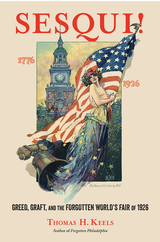 Sesqui!: Greed, Graft, and the Forgotten World's Fair of 1926
Thomas H. Keels
Temple University Press, 2017 In 1916, Philadelphia department-store magnate John Wanamaker launched plans for a Sesqui-Centennial International Exposition in 1926. It would be a magnificent world's fair to celebrate the 150th anniversary of the Declaration of Independence. The “Sesqui” would also transform sooty, industrial Philadelphia into a beautiful Beaux Arts city. However, when the Sesqui opened on May 31, 1926, in the remote, muddy swamps of South Philadelphia, the fair was unfinished, with a few shabbily built and mostly empty structures. Crowds stayed away in droves: fewer than five million paying customers attended, costing the city millions of dollars. Philadelphia became a national scandal—a city so corrupt that one political boss could kidnap an entire world’s fair. In his fascinating history Sesqui!, noted historian Thomas Keels situates this ill-fated celebration—a personal boondoggle by the all-powerful Congressman William S. Vare—against the transformations taking place in America during the 1920s. Keels provides a comprehensive account of the Sesqui as a meeting ground for cultural changes sweeping the country: women’s and African-American rights, anti-Semitism, eugenics, Prohibition, and technological advances.
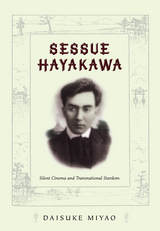 Sessue Hayakawa: Silent Cinema and Transnational Stardom
Daisuke Miyao
Duke University Press, 2007 While the actor Sessue Hayakawa (1886–1973) is perhaps best known today for his Oscar-nominated turn as a Japanese military officer in The Bridge on the River Kwai (1957), in the early twentieth century he was an internationally renowned silent film star, as recognizable as Charlie Chaplin or Douglas Fairbanks. In this critical study of Hayakawa’s stardom, Daisuke Miyao reconstructs the Japanese actor’s remarkable career, from the films that preceded his meteoric rise to fame as the star of Cecil B. DeMille’s The Cheat (1915) through his reign as a matinee idol and the subsequent decline and resurrection of his Hollywood fortunes. Drawing on early-twentieth-century sources in both English and Japanese, including Japanese-language newspapers in the United States, Miyao illuminates the construction and reception of Hayakawa’s stardom as an ongoing process of cross-cultural negotiation. Hayakawa’s early work included short films about Japan that were popular with American audiences as well as spy films that played upon anxieties about Japanese nationalism. The Jesse L. Lasky production company sought to shape Hayakawa’s image by emphasizing the actor’s Japanese traits while portraying him as safely assimilated into U.S. culture. Hayakawa himself struggled to maintain his sympathetic persona while creating more complex Japanese characters that would appeal to both American and Japanese audiences. The star’s initial success with U.S. audiences created ambivalence in Japan, where some described him as traitorously Americanized and others as a positive icon of modernized Japan. This unique history of transnational silent-film stardom focuses attention on the ways that race, ethnicity, and nationality influenced the early development of the global film industry.
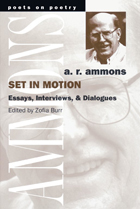 Set in Motion: Essays, Interviews, and Dialogues
A. R. Ammons
University of Michigan Press, 1996 Set in Motion collects for the first time the prose writings of A. R. Ammons, one of our most important and enduring contemporary poets. Hailed as a major force in American poetry by such redoubtable critics as Harold Bloom and Helen Vendler, Ammons has reflected upon the influences of luminaries like Emerson, Thoreau, Whitman, Frost, Stevens, and Williams while creating a compelling style and an artistic vision uniquely his own.
Set in Motion includes essays, reviews, and interviews as well as a selection of Ammons's poems, with commentary from the author about their inspiration and effects. He takes up the questions that have been central to American poetry over the last forty years and connects them to the larger enterprise of living in a difficult, changing world. At a moment when the arts are under attack, Ammons reminds us of the crucial role poetry plays in teaching us to recognize and use sources of understanding that are irreducible to statement.
A. R. Ammons is the author of Sphere, A Coast of Trees, and Garbage and was recently the editor of The Best American Poetry 1994. His awards include the MacArthur and Guggenheim fellowships, the Bollingen Prize, two National Book Awards, and prizes from the American Academy of Arts and Letters and the National Book Critics Circle. He is Goldwin Smith Professor of Poetry, Cornell University.
Set Theory and Its Logic: Revised Edition
W. V. Quine
Harvard University Press, 1963 This is an extensively revised edition of W. V. Quine’s introduction to abstract set theory and to various axiomatic systematizations of the subject. The treatment of ordinal numbers has been strengthened and much simplified, especially in the theory of transfinite recursions, by adding an axiom and reworking the proofs. Infinite cardinals are treated anew in clearer and fuller terms than before.
Improvements have been made all through the book; in various instances a proof has been shortened, a theorem strengthened, a space-saving lemma inserted, an obscurity clarified, an error corrected, a historical omission supplied, or a new event noted.
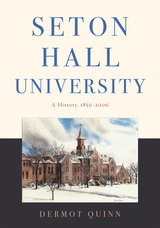 Seton Hall University: A History, 1856–2006
Dermot Quinn
Rutgers University Press, 2023 Founded in 1856 by Bishop James Roosevelt Bayley of Newark, Seton Hall University has played a large part in New Jersey and American Catholic life for nearly two centuries. From its modest beginnings as a small college and seminary to its present position as a major national university, it has always sought to provide “a home for the mind, the heart, and the spirit.”
In this vivid and elegantly written history, Dermot Quinn examines how Seton Hall was able to develop as an institution while keeping faith with its founder’s vision. Looking at the men and women who made Seton Hall what it is today, he paints a compelling picture of a university that has enjoyed its share of triumphs but has also suffered tragedy and loss. He shows how it was established in an age of prejudice and transformed in the aftermath of war, while exploring how it negotiated between a distinctly Roman Catholic identity and a mission to include Americans of all faiths.
Seton Hall University not only recounts the history of a great educational institution, it also shares the personal stories of the people who shaped it and were shaped by it: the presidents, the priests, the faculty, the staff, and of course, the students.
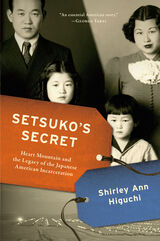 Setsuko's Secret: Heart Mountain and the Legacy of the Japanese American Incarceration
Shirley Ann Higuchi
University of Wisconsin Press, 2020 As children, Shirley Ann Higuchi and her brothers knew Heart Mountain only as the place their parents met, imagining it as a great Stardust Ballroom in rural Wyoming. As they grew older, they would come to recognize the name as a source of great sadness and shame for their older family members, part of the generation of Japanese Americans forced into the hastily built concentration camp in the aftermath of Executive Order 9066.
Only after a serious cancer diagnosis did Shirley's mother, Setsuko, share her vision for a museum at the site of the former camp, where she had been donating funds and volunteering in secret for many years. After Setsuko's death, Shirley skeptically accepted an invitation to visit the site, a journey that would forever change her life and introduce her to a part of her mother she never knew.
Navigating the complicated terrain of the Japanese American experience, Shirley patched together Setsuko's story and came to understand the forces and generational trauma that shaped her own life. Moving seamlessly between family and communal history, Setsuko's Secret offers a clear window into the "camp life" that was rarely revealed to the children of the incarcerated. This volume powerfully insists that we reckon with the pain in our collective American past.
 Setting Aside All Authority: Giovanni Battista Riccioli and the Science against Copernicus in the Age of Galileo
Christopher M. Graney
University of Notre Dame Press, 2015 Setting Aside All Authority is an important account and analysis of seventeenth-century scientific arguments against the Copernican system. Christopher M. Graney challenges the long-standing ideas that opponents of the heliocentric ideas of Copernicus and Galileo were primarily motivated by religion or devotion to an outdated intellectual tradition, and that they were in continual retreat in the face of telescopic discoveries.
Graney calls on newly translated works by anti-Copernican writers of the time to demonstrate that science, not religion, played an important, and arguably predominant, role in the opposition to the Copernican system. Anti-Copernicans, building on the work of the Danish astronomer Tycho Brahe, were in fact able to build an increasingly strong scientific case against the heliocentric system at least through the middle of the seventeenth century, several decades after the advent of the telescope. The scientific case reached its apogee, Graney argues, in the 1651 New Almagest of the Italian Jesuit astronomer Giovanni Battista Riccioli, who used detailed telescopic observations of stars to construct a powerful scientific argument against Copernicus.
Setting Aside All Authority includes the first English translation of Monsignor Francesco Ingoli’s essay to Galileo (disputing the Copernican system on the eve of the Inquisition’s condemnation of it in 1616) and excerpts from Riccioli's reports regarding his experiments with falling bodies.
“Christopher M. Graney’s Setting Aside All Authority makes a fine contribution to the history of science and especially the history of astronomy. The case Graney presents for the rationality of denying Copernicanism, as late as the mid-seventeenth century, is cogent, and he presents a good deal of novel historical material that urges a reevaluation of a major figure—Riccioli. The book will interest not only historians but also philosophers of science, and scientists in the relevant specialties (astronomy, physics) together with their students at both the undergraduate and graduate level.” —Peter Barker, University of Oklahoma
"The most exciting history of science book so far this century, Graney’s brilliant portrait of Riccioli and his science—amiable but punchy, rigorous but accessible—ought to stimulate a complete revision of what we thought we knew about the Copernican Revolution. Rarely have scientific analysis, historical scholarship, and writerly flair come together with such force." —Dennis Danielson, author of Paradise Lost and the Cosmological Revolution
"For students of the Copernican revolution, here is an unexpected contribution that will force the experts to revise their lecture notes. Christopher Graney (with translation assistance from Christina Graney) has almost single-handedly revised the traditional story about Jesuit Giambattista Riccioli’s list of pro and con arguments for the heliocentric cosmology. Big surprise: in 1651 the geocentric cosmology had science on its side." —Owen Gingerich, author of God's Planet
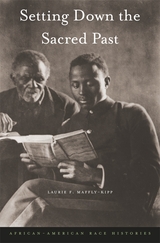 Setting Down the Sacred Past: African-American Race Histories
Laurie F. Maffly-Kipp
Harvard University Press, 2010 As early as the 1780s, African Americans told stories that enabled them to survive and even thrive in the midst of unspeakable assault. Tracing previously unexplored narratives from the late eighteenth century to the 1920s, Laurie Maffly-Kipp brings to light an extraordinary trove of sweeping race histories that African Americans wove together out of racial and religious concerns.
Asserting a role in God's plan, black Protestants sought to root their people in both sacred and secular time. A remarkable array of chroniclers—men and women, clergy, journalists, shoemakers, teachers, southerners and northerners—shared a belief that narrating a usable past offered hope, pride, and the promise of a better future. Combining Christian faith, American patriotism, and racial lineage to create a coherent sense of community, they linked past to present, Africa to America, and the Bible to classical literature. From collected shards of memory and emerging intellectual tools, African Americans fashioned stories that helped to restore meaning and purpose to their lives in the face of relentless oppression.
In a pioneering work of research and discovery, Maffly-Kipp shows how blacks overcame the accusation that they had no history worth remembering. African American communal histories imagined a rich collective past in order to establish the claim to a rightful and respected place in the American present. Through the transformative power of storytelling, these men and women led their people—and indeed, all Americans—into a more profound understanding of their interconnectedness and their prospects for a common future.
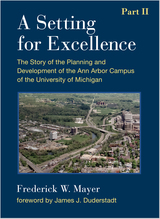 A Setting For Excellence, Part II: The Story of the Planning and Development of the Ann Arbor Campus of the University of Michigan
Frederick W. Mayer
University of Michigan Press, 2017 Campus planning is often a crucial underlying set of goals for university administrations, even if, over time, the mix of new and old buildings, changes in usage patterns and activities of students, and evolution of styles present challenges to a cohesive campus plan. In its two-hundred year history the University of Michigan has planned its campus in waves, from the earliest days of the iconic buildings around the Diag to the plans for the hospitals and the North Campus. This immensely informative and entertaining second volume in the history of the evolution of the campuses offers an absorbing narrative from the perspective of Fred Mayer, who served for more than three decades as the campus planner for the university during an important period of its growth during the late twentieth century.
By tracing the development of the Ann Arbor campus from its early days to the present, within the context of the evolution of higher education in America, Mayer provides a strong argument for the importance of rigorous and enlightened campus planning as a critical element of the learning environment of the university. His comprehensive history of campus planning, illustrated with photos, maps, and diagrams from Michigan’s history, is an outstanding contribution to the university’s history as it approaches its bicentennial.
 A Setting For Excellence: The Story of the Planning and Development of the Ann Arbor Campus of the University of Michigan
Frederick W. Mayer
University of Michigan Press, 2015 While there are times when the mix of old and new buildings and the chaotic activities of thousands of students can give a haphazard appearance to the university, campus planning has in fact become a highly refined form of architecture. This is demonstrated in a convincing fashion by this immensely informative and entertaining history of the evolution of the campuses of the University of Michigan by Fred Mayer, who served for more than three decades as the campus planner for the university during an important period of its growth during the late twentieth century. By tracing the development of the Michigan campus from its early days to the present, within the context of the evolution of higher education in America, Mayer provides a strong argument for the importance of rigorous and enlightened campus planning as a critical element of the learning environment of the university. His comprehensive history of campus planning, illustrated with photos, maps, and diagrams from Michigan’s history, is an outstanding contribution to the university’s history as it approaches its bicentennial in 2017. Perhaps more important, Mayer’s book provides a valuable treatise on the evolution of campus planning as an architectural discipline.
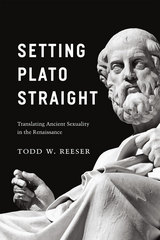 Setting Plato Straight: Translating Ancient Sexuality in the Renaissance
Todd W. Reeser
University of Chicago Press, 2015 When we talk of platonic love or relationships today, we mean something very different from what Plato meant. For this, we have fifteenth and sixteenth-century European humanists to thank. As these scholars—most of them Catholic—read, digested, and translated Plato, they found themselves faced with a fundamental problem: how to be faithful to the text yet not propagate pederasty or homosexuality.
In Setting Plato Straight, Todd W. Reeser undertakes the first sustained and comprehensive study of Renaissance textual responses to Platonic same-sex sexuality. Reeser mines an expansive collection of translations, commentaries, and literary sources to study how Renaissance translators transformed ancient eros into non-erotic, non-homosexual relations. He analyzes the interpretive lenses translators employed and the ways in which they read and reread Plato’s texts. In spite of this cleansing, Reeser finds surviving traces of Platonic same-sex sexuality that imply a complicated, recurring process of course-correction—of setting Plato straight.
Setting Priorities in the Age of Austerity: British, French, and German Experiences
Michael Shurkin
RAND Corporation, 2013 Examines the British, French, and German armies’ approaches to accommodating significant budget cuts while attempting to sustain their commitment to full spectrum operations. Specifically, it looks at the choices these armies are making with respect to how they spend dwindling resources: What force structure do they identify as optimal? How much readiness do they regard as necessary? Which capabilities are they abandoning?
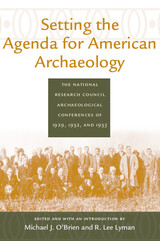 Setting the Agenda for American Archaeology: The National Research Council Archaeological Conferences of 1929, 1932, and 1935
Edited and with an introduction by Michael J. O'Brien and R. Lee Lyman
University of Alabama Press, 2001 A Dan Josselyn Memorial Publication
This collection elucidates the key role played by the National Research Council seminars, reports, and pamphlets in setting an agenda that has guided American archaeology in the 20th century. In the 1920s and 1930s, the fascination that Americans had for the continent's prehistoric past was leading to a widespread and general destruction of archaeological evidence. In a drive toward the commercialization of antiquities, amateur collectors and "pot hunters" pillaged premier and lesser-known sites before the archaeological record could be properly investigated and documented. Adding to the problem was a dearth of professionals and scholars in the field to conduct professional investigations and to educate the public about the need for preservation and scientific research methods.
In stepped the National Research Council, a division of the National Academy of Sciences, the Committee on State Archaeological Surveys. The CSAS initiated an enormously successful outreach program to enlist the aid of everyday citizens in preserving the fragile but valuable prehistoric past. Meetings held in St. Louis, Birmingham, and Indianapolis provided nuts-and-bolts demonstrations by trained archaeologists and laid out research agendas that both professionals and amateurs could follow.
Setting the Agenda contains the complete reports of the three NRC conferences, a short publication on the methods and techniques for conducting archaeological surveys, and a guide for amateur archaeologists. An extensive introduction by the editors sets these documents in context and provides insight into the intentions of the NRC committee members as they guided the development of American archaeology.
Setting the Lawn on Fire: A Novel
Mack Friedman
University of Wisconsin Press, 2007 Setting the Lawn on Fire, the first novel by critically acclaimed writer Mack Friedman, trails its narrator through his obsessions with sex, drugs, art, and poison. Ivan, a young Jewish boy from Milwaukee, embarks on a journey of sexual discovery that leads him from Wisconsin to Alaska, Philadelphia, and Mexico through stints as a fishery worker, artist, and finally a hustler who learns to provide the blank canvas for other people’s dreams. The result is a new kind of coming-of-age story that sees passion from every angle because its protagonist is every kind of lover: the seducer and the seduced, the pornographer and the model, the hunter and the prey, the trick and the john. In the end, Setting the Lawn on Fire is also something rare—a fully realized, contemporary romance that illuminates the power of desire and the rituals of the body, the brain, and the heart that attempt to contain our passions.
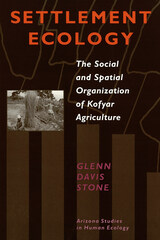 Settlement Ecology: The Social and Spatial Organization of Kofyar Agriculture
Glenn Davis Stone
University of Arizona Press, 1996 What determines agrarian settlement patterns? Glenn Davis Stone addresses this question by analyzing the spatial aspects of agrarian ecology--the relationship between how farmers farm and where they settle--and how farming and settlement change as population density rises. Crosscutting the fields of cultural anthropology, archaeology, geography, and agricultural economics, Settlement Ecology presents a new perspective on the process of agricultural intensification and explores the relationships between intensification and settlement decision making. Stone insists that paleotechnic ("traditional") agriculture must be seen as a social process, with the social organization of agricultural work playing a key role in shaping settlement characteristics. These relationships are demonstrated in a richly documented case study of the Kofyar, who have been settling a frontier in the Nigerian savanna. The history of agricultural change and the development of the settlement pattern are reconstructed through ethnography, archival research, and aerial photos and are analyzed using innovative graphical methods. Stone also reflects on the limits of ecological determination of settlement, comparing the farming and settlement trajectories of the Kofyar and Tiv on the same frontier.
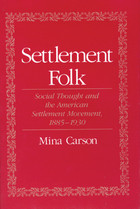 Settlement Folk: Social Thought and the American Settlement Movement, 1885-1930
Mina Carson
University of Chicago Press, 1990 Mina Carson deftly merges social and intellectual history to reconsider the settlement movement—its Anglo-American roots and evolution, its conflicts and accomplishments. Carson focuses her study on the careers and ideas of settlement founders and leaders, among them Jane Addams, Robert Woods, Mary Simkhovitch, Lillian Wald, and Graham Taylor. She demonstrates how these influential, often charismatic leaders appropriated and adapted certain Victorian values—such as the Social Gospel and the religion of character—to their visions of urban reform through action and experimentation.
These extraordinary individuals left an enduring legacy of beliefs about professional and voluntary responsibility for welfare services. As Carson shows, however, their genius for image creation and their myriad connections with other intellectual and social leaders extended the influence of the settlement ideology in many directions: fostering new attitudes toward the American city and the equality of the sexes, initiating a new social-scientific approach to social problems, and shaping the self-definition of the American educated middle class.
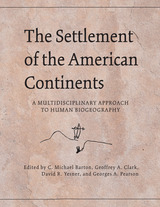 The Settlement of the American Continents: A Multidisciplinary Approach to Human Biogeography
Edited by C. Michael Barton, Geoffrey A. Clark, David R. Yesner, and Georges A. Pearson
University of Arizona Press, 2004 When many scholars are asked about early human settlement in the Americas, they might point to a handful of archaeological sites as evidence. Yet the process was not a simple one, and today there is no consistent argument favoring a particular scenario for the peopling of the New World.
This book approaches the human settlement of the Americas from a biogeographical perspective in order to provide a better understanding of the mechanisms and consequences of this unique event. It considers many of the questions that continue to surround the peopling of the Western Hemisphere, focusing not on sites, dates, and artifacts but rather on theories and models that attempt to explain how the colonization occurred.
Unlike other studies, this book draws on a wide range of disciplines—archaeology, human genetics and osteology, linguistics, ethnology, and ecology—to present the big picture of this migration. Its wide-ranging content considers who the Pleistocene settlers were and where they came from, their likely routes of migration, and the ecological role of these pioneers and the consequences of colonization. Comprehensive in both geographic and topical coverage, the contributions include an explanation of how the first inhabitants could have spread across North America within several centuries, the most comprehensive review of new mitochondrial DNA and Y-chromosome data relating to the colonization, and a critique of recent linguistic theories.
Although the authors lean toward a conservative rather than an extreme chronology, this volume goes beyond the simplistic emphasis on dating that has dominated the debate so far to a concern with late Pleistocene forager adaptations and how foragers may have coped with a wide range of environmental and ecological factors. It offers researchers in this exciting field the most complete summary of current knowledge and provides non-specialists and general readers with new answers to the questions surrounding the origins of the first Americans.
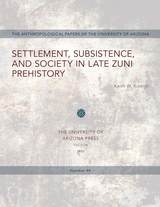 Settlement, Subsistence, and Society in Late Zuni Prehistory
Keith W. Kintigh
University of Arizona Press, 1985 Beginning about A.D. 1250, the Zuni area of New Mexico witnessed a massive population aggregation in which the inhabitants of hundreds of widely dispersed villages relocated to a small number of large, architecturally planned pueblos. Over the next century, twenty-seven of these pueblos were constructed, occupied briefly, and then abandoned. Another dramatic settlement shift occurred about A.D. 1400, when the locus of population moved west to the “Cities of Cibola” discovered by Coronado in 1540.
Keith W. Kintigh demonstrates how changing agricultural strategies and developing mechanisms of social integration contributed to these population shifts. In particular, he argues that occupants of the earliest large pueblos relied on runoff agriculture, but that gradually spring-and river-fed irrigation systems were adopted. Resultant strengthening of the mechanisms of social integration allowed the increased occupational stability of the protohistorical Zuni towns.
Settler
Maggie Queeney
Tupelo Press, 2021 These fourteen-line poems give voice to the individual and collective experiences of women. They are windows into a stark otherworld, one filled with the raw materials of experience: sex, birth, cloth, pain. Spare and strange beauty marks the lives and worlds of these women, defined by their struggle for survival in the physical and psychological captivity of the domestic realm. The speaker moves between the singular and plural, sounding out the overlapping experiences of women as both subject and object of the domination inherent in settler colonialism.
 Settler Attachments and Asian Diasporic Film
Beenash Jafri
University of Minnesota Press, 2025 A cinematic study of Asian–Indigenous relationality Settler Attachments and Asian Diasporic Film is an interdisciplinary examination of the stubborn attachment of Asian diasporas to settler-colonial ideals and of the decolonial possibilities Asian diasporic films imagine. Beenash Jafri uniquely addresses the complexities of Asian–Indigenous relationality through film and visual media, urging film scholars to approach their subjects with an eye to the entanglements of race, diaspora, and Indigeneity. Highlighting how Asian diasporic attachments to settler colonialism are structural, she explores how they are manifested through melancholic yearning within the figure of the Asian cowboy in films such as Cowgirl and Wild West and through the aesthetic and representational politics of body and land in experimental films by Shani Mootoo and Vivek Shraya. While recognizing the pervasive violence of settler colonialism, Jafri maintains a hopeful outlook, showcasing how Asian diasporic filmmakers persistently work toward decolonial worldmaking. This emerging vision can be seen in the radical friendship between Ali Kazimi and Onondaga artist Jeffrey Thomas in Kazimi’s film Shooting Indians, in the queer relational survivance depicted in films such as This Place and Scarborough, and in the sensory disruptions of Jin-me Yoon’s interactive art project Untunnelling Vision. From film and media studies to diaspora studies and critical ethnic studies, Indigenous studies to queer theory, Settler Attachments and Asian Diasporic Film provides a critical framework for engaging cinematic media to understand and imagine beyond the entrenched settler-colonial dynamics within Asian diasporic communities. Retail e-book files for this title are screen-reader friendly with images accompanied by short alt text and/or extended descriptions.
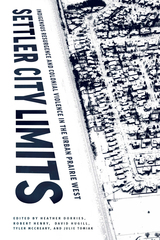 Settler City Limits: Indigenous Resurgence and Colonial Violence in the Urban Prairie West
Heather Dorries
Michigan State University Press, 2019 While cities like Winnipeg, Minneapolis, Saskatoon, Rapid City, Edmonton, Missoula, Regina, and Tulsa are places where Indigenous marginalization has been most acute, they have also long been sites of Indigenous placemaking and resistance to settler colonialism. Settler City Limits addresses urban struggles involving Anishinabek, Cree, Creek, Dakota, Flathead, Lakota, and Métis peoples. Collectively, these studies showcase how Indigenous people in the city resist ongoing processes of colonial dispossession and create spaces for themselves and their families. Working at intersections of Indigenous studies, settler colonial studies, urban studies, geography, and sociology, this book examines how the historical and political conditions of settler colonialism have shaped urban development in the Canadian Prairies and American Great Plains. Settler City Limits frames cities as Indigenous spaces and places, both in terms of the historical geographies of the regions in which they are embedded and with respect to ongoing struggles for land, life, and self-determination.
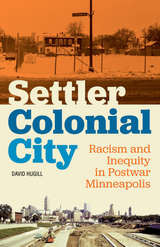 Settler Colonial City: Racism and Inequity in Postwar Minneapolis
David Hugill
University of Minnesota Press, 2021 Revealing the enduring link between settler colonization and the making of modern Minneapolis
Colonial relations are often excluded from discussions of urban politics and are viewed instead as part of a regrettable past. In Settler Colonial City, David Hugill confronts this culture of organized forgetting by arguing that Minnesota’s largest city is enduringly bound up with the power dynamics of settler-colonial politics. Examining several distinct Minneapolis sites, Settler Colonial City tracks how settler-colonial relations were articulated alongside substantial growth in the Twin Cities Indigenous community during the second half of the twentieth century—creating new geographies of racialized advantage. Studying the Phillips neighborhood of Minneapolis in the decades that followed the Second World War, Settler Colonial City demonstrates how colonial practices and mentalities shaped processes of urban reorganization, animated non-Indigenous “advocacy research,” informed a culture of racialized policing, and intertwined with a broader culture of American imperialism. It reveals how the actions, assumptions, and practices of non-Indigenous people in Minneapolis produced and enforced a racialized economy of power that directly contradicts the city’s “progressive” reputation. Ultimately, Settler Colonial City argues that the hierarchical and racist political dynamics that characterized the city’s prosperous beginnings are not exclusive to a bygone era but rather are central to a recalibrated settler-colonial politics that continues to shape contemporary cities across the United States.
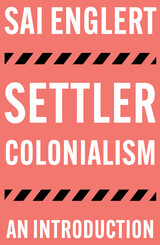 Settler Colonialism: An Introduction
Sai
Pluto Press, 2022 Sai Englert offers readers an accessible and global account of settler colonialism, taking in its history, some of its main characteristics, and its continued relevance today. From the Palestinian struggle against Israel occupation to the First Nations' mass opposition to pipeline construction in North America, indigenous peoples are at the forefront of some of the most important struggles of our age. Rich with their own unique histories, characteristics, and social relations, these different struggles are connected by the enemy they face: settler colonialism. While settler-colonial regimes differ, Englert explains how they are all defined by a fundamental conflict between themselves and the indigenous people they aim to dispossess, exploit and/or eliminate. To understand settler colonialism as a distinct, structural, and contemporary process, is also to start engaging with a number of international social movements, political struggles, and solidarity campaigns differently. It is to start asking how decolonization – as a material struggle for freedom – might be possible.
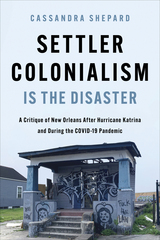 Settler Colonialism is the Disaster: A Critique of New Orleans After Hurricane Katrina and During the COVID-19 Pandemic
Cassandra Shepard
University of Illinois Press, 2026 Rebuilding efforts in the aftermath of Hurricane Katrina and during the COVID-19 pandemic unleashed perpetual disaster on New Orleans’ Black and Indigenous communities. Neoliberalism masked by the auspices of repair, progress, and inclusion reinforced the plight of the urban poor while exacerbating the racial and class inequalities that existed before the storm. Cassandra Shepard’s analysis draws on ideas of settler-colonialism to chart how depriving Black and Indigenous people of critical resources intensified the harm, violence, and death inherent in systems of colonization. As Shepard shows, the rhetoric of improvement allows coloniality to masquerade as rebuilding while white elites consolidate power, profit, and privilege. Displaced and disenfranchised people of color, meanwhile, experience the impact of racial-disaster capitalism, with the chaos surrounding Katrina and COVID-19 obscuring the for-profit economic, political, and social exploitation of non-white New Orleanians. Ambitious and provocative, Settler Colonialism is the Disaster refutes the myth of New Orleans’ presumptive revival by shining new light on the ongoing colonization project at its heart.
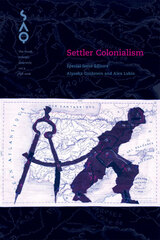 Settler Colonialism, Volume 107
Alex Lubin
Duke University Press At a time when the Chinese are being labeled the “new colonialists,” this special issue of SAQ revisits the history of settler colonialism in such varied societies as the United States, South Africa, Eritrea, and Palestine/Israel. This issue examines similarities and differences among the diverse historical, geographical, and economic instances of settler colonialism, the practice of colonists moving permanently to a new settlement and, in some instances, growing to outnumber the indigenous inhabitants. Avoiding an oversimplified settler-native dichotomy, contributors engage current debates about the postcolonial to unsettle reductive chronologies of decolonization, addressing how formations of modern settler colonialism, both successful and failed projects (the Italians in Eritrea), compare with more general historical developments of colonial empire.
Essays consider how race, sexuality and gender, and ethnicity shape experiences of settler colonialism, how public and private space are administered, how citizenship laws establish boundaries of national inclusion and exclusion, how religious motives drive settler colonialism, and how settler colonial regimes appropriate and “cleanse” indigenous cultures and histories. One essay investigates the interwoven ideological rationales for cultural pluralism, Zionism, and opposition to empire in the United States prior to World War I, highlighting the seemingly paradoxical call for the support of a Zionist settlement of Israel on grounds that establishing a Jewish state through colonial appropriation paralleled American development. Another contributor argues that white settler colonialism in the United States is articulated within the present-day constellation of neoliberalism and post–civil rights “color-blind” discourse, focusing on the intersections of the U.S. vote against the UN Declaration on the Rights of Indigenous Peoples in 2007, the U.S. Supreme Court ruling on City of Sherrill v. Oneida Indian Nation of New York in 2005, and antisovereignty groups organizing against American Indian self-determination. Another offers the current situation in Darfur as a provocative rendering of postcolonial settler violence.
 Settler Garrison: Debt Imperialism, Militarism, and Transpacific Imaginaries
Jodi Kim
Duke University Press, 2022 In Settler Garrison Jodi Kim theorizes how the United States extends its sovereignty across Asia and the Pacific in the post-World War II era through a militarist settler imperialism that is leveraged on debt as a manifold economic and cultural relation undergirded by asymmetries of power. Kim demonstrates that despite being the largest debtor nation in the world, the United States positions itself as an imperial creditor that imposes financial and affective indebtedness alongside a disciplinary payback temporality even as it evades repayment of its own debts. This debt imperialism is violently reproduced in juridically ambiguous spaces Kim calls the “settler garrison”: a colonial archipelago of distinct yet linked military camptowns, bases, POW camps, and unincorporated territories situated across the Pacific from South Korea to Okinawa to Guam. Kim reveals this process through an analysis of how a wide array of transpacific cultural productions creates antimilitarist and decolonial imaginaries that diagnose US militarist settler imperialism while envisioning alternatives to it.
 Settler Militarism: World War II in Hawai'i and the Making of US Empire
Juliet Nebolon
Duke University Press, 2024 Under martial law during World War II, Hawaiʻi was located at the intersection of home front and war front. In Settler Militarism, Juliet Nebolon shows how settler colonialism and militarization simultaneously perpetuated, legitimated, and concealed one another in wartime Hawaiʻi for the purposes of empire building in Asia and the Pacific Islands. She demonstrates how settler militarism operated through a regime of racial liberal biopolitics that purported to protect all people in Hawaiʻi, even as it intensified the racial and colonial differentiation of Kanaka Maoli, Asian settlers, and white settlers. Nebolon identifies settler militarism’s inherent contradiction: It depends on life, labor, and land to reproduce itself, yet it avariciously consumes, via violent and extractive projects, those same lives and natural resources that it needs to subsist. From vaccination and blood bank programs to the administration of internment and prisoner-of-war camps, Nebolon reveals how settler militarism and racial liberal biopolitics operated together in the service of capitalism. Collectively, the social reproduction of these regimes created the conditions for the late-twentieth-century expansion of US military empire.
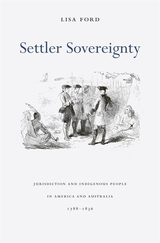 Settler Sovereignty: Jurisdiction and Indigenous People in America and Australia, 1788–1836
Lisa Ford
Harvard University Press, 2010 In a brilliant comparative study of law and imperialism, Lisa Ford argues that modern settler sovereignty emerged when settlers in North America and Australia defined indigenous theft and violence as crime.
This occurred, not at the moment of settlement or federation, but in the second quarter of the nineteenth century when notions of statehood, sovereignty, empire, and civilization were in rapid, global flux. Ford traces the emergence of modern settler sovereignty in everyday contests between settlers and indigenous people in early national Georgia and the colony of New South Wales. In both places before 1820, most settlers and indigenous people understood their conflicts as war, resolved disputes with diplomacy, and relied on shared notions like reciprocity and retaliation to address frontier theft and violence. This legal pluralism, however, was under stress as new, global statecraft linked sovereignty to the exercise of perfect territorial jurisdiction. In Georgia, New South Wales, and elsewhere, settler sovereignty emerged when, at the same time in history, settlers rejected legal pluralism and moved to control or remove indigenous peoples.
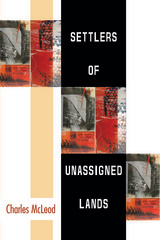 Settlers of Unassigned Lands
Charles McLeod
University of Michigan Press, 2015 In these seven stories spanning the Midwest to California, Charles McLeod brings us characters estranged from their homelands and locked in conflict with their past and present selves. In “How to Start Your Own Midwestern Ghost Town,” an unnamed narrator hatches a plan to capitalize on rural decay. A porn star trying to transition to the mainstream does an interview with a German reporter in “The Subject of Our First Issue Is Art.” In the title story, a closeted heroin dealer follows a ghostly girl into an Oakland graveyard. And in “Rancho Brava,” the conductor of a focus group about corporate salsa keeps getting interrupted by visitors from the Old West. Alternating between the comic, the tragic, and the neurotic—and often all three at once—McLeod’s second collection transports readers from the American mainstream to the dark edges of cities and the heartland’s lost, forgotten towns, into the lives of people trying to decipher if they can escape their pasts, and at what cost.
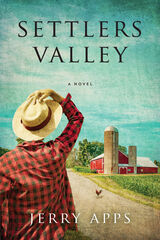 Settlers Valley
Jerry Apps
University of Wisconsin Press, 2021 No matter what Reader’s Digest would have you believe, C.J. Anderson wants you to know he’s no hero. Broken and reeling from the untimely death of his parents, the young vet with PTSD begins working a small farm plot at the suggestion of his grandfather. As the land yields its first crops, C.J. begins to heal and contacts a few wounded Army friends to join him in Settlers Valley. They build a collective of sustainable farmers who called themselves the Back to the Land Veterans. Their progressive ideas and neighborly spirit are welcome by many in the tight-knit town. But others would much rather things stay exactly the way they were, thank you very much. When a series of tragic events hits the valley, will neighbors come together, or will the town fall apart?
In this eminently readable story, Jerry Apps delves into the heart of small-town America. Reckoning with timely problems and opinions that divide us, he shows us the power in restoring our relationships with nature and our communities.
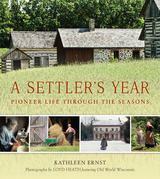 A Settler's Year: Pioneer Life through the Seasons
Kathleen Ernst
Wisconsin Historical Society Press, 2015 "This is a book with great meaning for those of us who grew up on farms, and a book to be shared with young people eager to know more about pioneer life." --Jerry Apps, author of "Old Farm: A History" and "Whispers and Shadows: A Naturalist's Memoir" "A Settler's Year" provides a rare glimpse into the lives of early immigrants to the upper Midwest. Evocative photographs taken at Old World Wisconsin, the country's largest outdoor museum of rural life, lushly illustrate stories woven by historian, novelist, and poet Kathleen Ernst and compelling firsthand accounts left by the settlers themselves. In this beautiful book, readers will discover the challenges and triumphs found in the seasonal rhythms of rural life in the nineteenth and early twentieth centuries. As they turn the pages--traveling from sprawling farm to tidy crossroads village, and from cramped and smoky cabins to gracious, well-furnished homes--they'll experience the back-straining chores, cherished folk traditions, annual celebrations, and indomitable spirit that comprised pioneer life. At its heart "A Settler's Year" is about people dreaming of, searching for, and creating new homes in a new land. This moving book transports us back to the pioneer era and inspires us to explore the stories found on our own family trees.
Settlin’: Stories of Madison’s Early African American Families
Muriel Simms
Wisconsin Historical Society Press, 2018 Only a fraction of what is known about Madison’s earliest African American settlers and the vibrant and cohesive communities they formed has been preserved in traditional sources. The rest is contained in the hearts and minds of their descendants. Seeing a pressing need to preserve these experiences, lifelong Madison resident Muriel Simms collected the stories of twenty-five African Americans whose families arrived, survived, and thrived here in the late nineteenth and early twentieth centuries. While some struggled to find work, housing, and acceptance, they describe a supportive and enterprising community that formed churches, businesses, and social clubs—and frequently came together in the face of adversity and conflict. A brief history of African American settlement in Madison begins the book to set the stage for the oral histories.
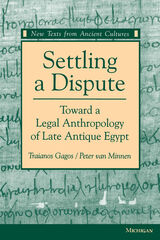 Settling a Dispute: Toward a Legal Anthropology of Late Antique Egypt
Traianos Gagos and Peter van Minnen
University of Michigan Press, 1994 Family squabbles and fights over real estate were no less complex in sixth-century Egypt than they are in the modern world. In this unusual volume Peter van Minnen and Traianos Gagos investigate just such a struggle, as described in a two-part papyrus some five feet long. Composed by the ancient equivalent of a notary public, the papyrus describes the outcome (after mediation) of a family dispute about valuable real estate.
Traianos Gagos and Peter van Minnen offer an English translation and a clear Greek text of the two papyrus fragments, as well as an important discussion of the nature of such mediation, its role in contemporary society, a consideration of the town of Aphrodito and its social and political elite, as well as many other topics that spring from this kind of document.
The use of methodologies from modern jurisprudence and anthropology together with an accessible style of writing mean that Settling a Dispute will be of interest to persons in many fields, including history, Classics, and Near Eastern studies. All Greek is translated, and an extensive commentary offers much helpful information on the text.
Traianos Gagos is Associate Archivist of the University of Michigan's papyri collection. Peter van Minnen is Senior Research Associate in the papyri collection at Duke University.
Settling in a Changing World: Villa Development in the Northern Provinces of the Roman Empire
Diederick Habermehl
Amsterdam University Press, 2013 Offering a broad analysis of the complex developments in rural habitation of the northern provinces of the Roman Empire, Settling in a Changing World reconstructs the colonial villa from social and economic perspectives to create a broad geographical and chronological framework that sheds light on both local and regional patterns. Considering data from the Netherlands, Belgium, Germany, and France, Diederick Habermehl analyzes, visualizes, and reconstructs the developments in settlement space and architecture. Applying theoretical concepts from both archaeology and cultural studies, this groundbreaking book ultimately offers a new perspective on the Roman villa as an architectural and cultural phenomenon.
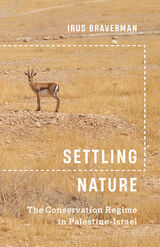 Settling Nature: The Conservation Regime in Palestine-Israel
Irus Braverman
University of Minnesota Press, 2023 A study of Palestine-Israel through the unexpected lens of nature conservation
Settling Nature documents the widespread ecological warfare practiced by the state of Israel. Recruited to the front lines are fallow deer, gazelles, wild asses, griffon vultures, pine trees, and cows—on the Israeli side—against goats, camels, olive trees, hybrid goldfinches, and akkoub—which are affiliated with the Palestinian side. These nonhuman soldiers are all the more effective because nature camouflages their tactical deployment as such. Drawing on more than seventy interviews with Israel’s nature officials and on observations of their work, this book examines the careful orchestration of this animated warfare by Israel’s nature administration on both sides of the Green Line. Alongside its powerful protection of wildlife biodiversity, the territorial reach of Israel’s nature protection is remarkable: to date, nearly 25 percent of the country’s total land mass is assigned as a park or a reserve. Settling Nature argues that the administration of nature advances the Zionist project of Jewish settlement and the corresponding dispossession of non-Jews from this space.
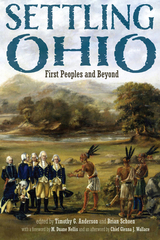 Settling Ohio: First Peoples and Beyond
Timothy G. Anderson
Ohio University Press, 2023 Scholars working in archaeology, education, history, geography, and politics tell a nuanced story about the people and dynamics that reshaped this region and determined who would control it. The Ohio Valley possesses some of the most resource-rich terrain in the world. Its settlement by humans was thus consequential not only for shaping the geographic and cultural landscape of the region but also for forming the United States and the future of world history. Settling Ohio begins with an overview of the first people who inhabited the region, who built civilizations that moved massive amounts of earth and left an archaeological record that drew the interest of subsequent settlers and continues to intrigue scholars. It highlights how, in the eighteenth century, Native Americans who migrated from the East and North interacted with Europeans to develop impressive trading networks and how they navigated complicated wars and sought to preserve national identities in the face of violent attempts to remove them from their lands. The book situates the traditional story of Ohio settlement, including the Northwest Ordinance, the dealings of the Ohio Company of Associates, and early road building, into a far richer story of contested spaces, competing visions of nationhood, and complicated relations with Indian peoples. By so doing, the contributors provide valuable new insights into how chaotic and contingent early national politics and frontier development truly were. Chapters highlighting the role of apple-growing culture, education, African American settlers, and the diverse migration flows into Ohio from the East and Europe further demonstrate the complex multiethnic composition of Ohio’s early settlements and the tensions that resulted. A final theme of this volume is the desirability of working to recover the often-forgotten history of non-White peoples displaced by the processes of settler colonialism that has been, until recently, undervalued in the scholarship.
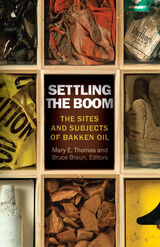 Settling the Boom: The Sites and Subjects of Bakken Oil
Mary E. Thomas
University of Minnesota Press, 2023 Examines how settler colonial and sexist infrastructures and narratives order a resource boom
Over the past decade, new oil plays have unsettled U.S. energy landscapes and imaginaries. Settling the Boom studies how the disruptive forces of an oil boom in the northern Great Plains are contained through the extension of settler temporalities, reassertions of heteropatriarchy, and the tethering of life to the volatility of oil and its cruel optimisms. This collection reveals the results of sustained research in Williston, North Dakota, the epicenter of the “Bakken Boom.” While the boom brought a rapid influx of capital and workers, the book questions simple timelines of before and after. Instead, Settling the Boom demonstrates how the unsettling forces of an oil play resolve through normative narratives and material and affective infrastructures that support settler colonialism’s violent extension and its gendered orders of time and space. Considering a wide range of evidence, from urban and regional policy, interviews with city officials, media, photography, and film, these essays analyze the ongoing material, aesthetic, and narrative ways of life and land in the Bakken. Contributors: Morgan Adamson, Macalester College; Kai Bosworth, Virginia Commonwealth U; Thomas S. Davis, Ohio State U; Jessica Lehman, Durham U.
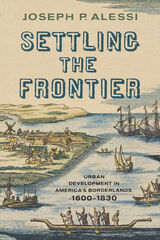 Settling the Frontier: Urban Development in America's Borderlands, 1600–1830
Joseph P. Alessi
Westholme Publishing, 2025 The Role of Indigenous People in the Founding of America's First Major Border Towns
In 1811, while escorting members of John Jacob Astor’s Pacific Fur Company up the Columbia River, their Chinookan guide refused to advance beyond a particular point that marked a boundary between his people and another indigenous group. Long before European contact, Native Americans created and maintained recognized borders, ranging from family hunting and fishing properties to larger tribal territories to vast river valley regions. Within the confines of these respective borders, the native population often established permanent settlements that acted as the venues for the major political, economic, and social activities that took place in virtually every part of precolonial North America. It was the location of these native settlements that played a major role in the establishment of the first European, and later, American frontier towns.
In Settling the Frontier: Urban Development in America’s Borderlands, 1600–1830, historian Joseph P. Alessi examines how the Pecos, Mohawk, Ohioan, and Chinook tribal communities aided Europeans and Americans in the founding of five of America’s earliest border towns—Santa Fe (New Mexico), Fort Amsterdam (New York City), Fort Orange (Albany, New York), Fort Pitt (Pittsburgh, Pennsylvania), and Fort Astoria (Portland, Oregon). Filling a void in scholarship about the role of Native American communities in the settlement of North America, Alessi reveals that, although often resistant to European and American progress or abused by it, Indians played an integral role in motivating and assisting Europeans with the establishment of frontier towns. In addition to the location of these towns, the native population was often crucial to the survival of the settlers in unfamiliar and unforgiving environments. As a result, these new towns became the logistical and economic vanguards for even greater development and exploitation of North America.
Settling the Score: Music and the Classical Hollywood Film
Kathryn Kalinak
University of Wisconsin Press, 1992 Beginning with the earliest experiments in musical accompaniment carried out in the Edison Laboratories, Kathryn Kalinak uses archival material to outline the history of American music and film. Focusing on the scores of several key composers of the sound era, including Erich Wolfgang Korngold’s Captain Blood, Max Steiner’s The Informer, Bernard Herrmann’s The Magnificent Ambersons, and David Raksin’s Laura, Kalinak concludes that classical scoring conventions were designed to ensure the dominance of narrative exposition. Her analyses of contemporary work such as John Williams’ The Empire Strikes Back and Basil Poledouris’ RoboCop demonstrate how the traditions of the classical era continue to influence scoring practices today.
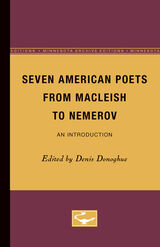 Seven American Poets from MacLeish to Nemerov: An Introduction
Denis Donoghue
University of Minnesota Press, 1975
Seven American Poets from MacLeish to Nemerov was first published in 1975. Volume 9, Minnesota Library on American Writers. Leonard Unger and George T. Wright, series editorsThe Minnesota Library on American Writers, of which this is the ninth volume, is based on collections of pamphlets from the series of University of Minnesota Pamphlets on American Writers. This book focuses on seven important contemporary American poets. The subject poets and the respective authors are Archibald MacLeish by Grover Smith, Richard Eberhart by Ralph J. Mills, Jr., Theodore Roethke, also by Mr. Mills, Randall Jarrell by M.L. Rosenthal, John Berryman by William J. Martz, Robert Lowell by Jay Martin, and Howard Nemerov by Peter Meinke.Mr. Donoghue writes an introduction in which he notes that “seven modern American poets demonstrate seven different ways of being an American.” He continues: “It is not my business, nor would it give me any pleasure, to comment on the difficulty of being an American poet: I am neither American nor a poet. But it is my impression that American poets have become more skillful in the art of being themselves; poets born in 1920 or later have had the advantage of seeing a thousand ways in which the job has been done, and the encouragement of such examples. Each poet must still do the work for himself, but he has before him the pioneers from Poe and Whitman to Williams, and he knows by their example what it means to work in the American grain.”In addition to the critical introductions there are selected bibliographies for each of the seven poets.
Seven American Women Writers of the Twentieth Century: An Introduction
Maureen Howard, Editor
University of Minnesota Press, 1977
Seven American Women Writers of the Twentieth Century was first published in 1977. Minnesota Archive Editions uses digital technology to make long-unavailable books once again accessible, and are published unaltered from the original University of Minnesota Press editions.
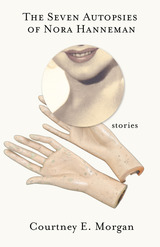 The Seven Autopsies of Nora Hanneman: Stories
Courtney E. Morgan
University of Alabama Press, 2017 The nineteen stories in The Seven Autopsies of Nora Hanneman track the splintered trajectory of the title character, tracing a chicken-scratch line of psychosexual development from childhood to old age.
In unfamiliar and sometimes bizarre narrative turns, the stories in Courtney E. Morgan’s The Seven Autopsies of Nora Hanneman traverse the gamut of female/human experience, both grounded in reality and in the irreal. Two schoolgirls culminate their sexual exploration in a surreal act of cannibalism. A sister molds her dead brother’s body into a bird. A woman gives birth to balls of twine and fur (among other things). A sex worker engages a version of herself in a brothel of prostituted body parts.
Morgan tears apart a host of archetypes and tropes of femininity—dismembering them, skinning them, and then draping them one by one over her characters like fur coats—revealing them as ill-fitting, sometimes comedic, sometimes monstrous, and always insufficient, masks. Along with these skins of the cultural “feminine,” the collection tries on an array of genres—dissecting, mutating, and breeding them together—from fairy tale to horror, surrealism to confessional (non)fiction, and erotica to (un)creation myth.
The book weaves around questions of sexuality, identity, and subjectivity. Mutability, instability, and liminality are foregrounded, both in content and form, character and language—blurring the lines between birth and death, death and sex, tugging at the transitional spaces of adolescence and gestation. Even as its treatment is essentialized, gender is muddied and obscured. Morgan shows off her linguistic range in this collection, from sharp-as-nails prose to lyrical moments of poetic reach—probing the extremes of the human condition through both narrative line and language itself.
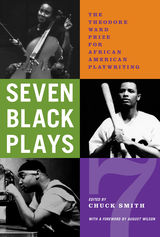 Seven Black Plays: The Theodore Ward Prize for African American Playwriting
Chuck Smith
Northwestern University Press, 2004 Awarded annually since 1987, the Theodore Ward Prize recognizes the outstanding individual accomplishments of African American playwrights, as well as their growing importance to the shape and direction of American drama in our time. This collection, edited by a director and educator who has been affiliated with the contest for fifteen of its seventeen years, showcases a selection of the award-winning plays and offers a rich and varied view of the best of two decades of evolving African American drama.
These seven plays, which span the Ward Prize's history, represent a wide range of talents, experience, and perspectives brought to bear on diverse themes, from a unique moment in the history of baseball's Negro League to a working-class couple contending with a neighborhood bully; from a child's memories of negotiating desegregation to coming of age amidst the ravages of racism, child abuse, and AIDS. By turns poetic and moving, brave and rousing, uproarious and unsettling, these works written by established and emerging playwrights allow actors, directors, theatergoers, and readers to sample the multifarious dramatic experience being limned by African American playwrights today.
The Seven Books of History Against the Pagans
Paulus Orosius
Catholic University of America Press, 1964 This work is valuable as history, containing as it does contemporary information on the period after 278 A.D. It was used widely during the Middle Ages, and the existence today of nearly 200 manuscript copies is evidence of its past popularity.
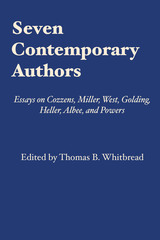 Seven Contemporary Authors: Essays on Cozzens, Miller, West, Golding, Heller, Albee, and Powers
Edited with an Introduction by Thomas B. Whitbread
University of Texas Press, 1966 These seven critical essays, each on a twentieth-century novelist, are disparate in content, but all are concerned with the problem of evil and inhumanity and with the paradoxes of human existence. Each essay discusses a different author, but this independence of subject is resolved into a central theme through the interpretive approach followed by the seven critics. Each of the contributors presents his subject against the background of the current disillusionment and frustration of our age. Underlying each essay are undertones of the "absurdity" of life today for those who consider it thoughtfully, and the contrast between what men would like reality to be and what they actually find. This unity of theme—the problem of evil, of inhumanity, of meaninglessness, the concern for the human being and his future—is developed in an interesting manner. It was exploited in different ways by the seven modern novelists discussed in the essays, and it is presented with different analytical techniques by the seven critics. Yet the reader senses the unity of feeling and purpose amid the diversity of fictional content and critical evaluation. Besdies the interpretive Introduction by Thomas B. Whitbread, the book contains the following essays: - R. W. Lewis, "The Conflicts of Reality: Cozzens' The Last Adam"
- Alan Friedman, "The Pitching of Love's Mansion in the Tropics of Henry Miller"
- Roger D. Abrahams, "Androgynes Bound: Nathanael West's Miss Lonelyhearts"
- George Clark, "An Illiberal Education: William Golding's Pedagogy"
- Vance Ramsey, "From Here to Absurdity: Heller's Catch-22"
- Anthony Channell Hilfer, "George and Martha: Sad, Sad, Sad"
- Robert G. Twombly, "Hubris, Health, and Holiness: The Despair of J. F. Powers"
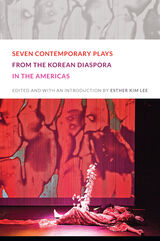 Seven Contemporary Plays from the Korean Diaspora in the Americas
Esther Kim Lee, ed.
Duke University Press, 2012 Showcasing the dynamism of contemporary Korean diasporic theater, this anthology features seven plays by second-generation Korean diasporic writers from the United States, Canada, and Chile. By bringing the plays together in this collection, Esther Kim Lee highlights the themes and styles that have enlivened Korean diasporic theater in the Americas since the 1990s. Some of the plays are set in urban Koreatowns. One takes place in the middle of Texas, while another unfolds entirely in a character's mind. Ethnic identity is not as central as it was in the work of previous generations of Asian diasporic playwrights. In these plays, experiences of diaspora and displacement are likely to be part of broader stories, such as the difficulties faced by a young mother trying to balance family and career. Running through these stories are themes of assimilation, authenticity, family, memory, trauma, and gender-related expectations of success. Lee's introduction includes a brief history of the Korean Peninsula in the twentieth century and of South Korean immigration to the Americas, along with an overview of Asian American theater and the place of Korean American theater within it. Each play is preceded by a brief biography of the playwright and a summary of the play's production history.
The Seven Day Circle: The History and Meaning of the Week
Eviatar Zerubavel
University of Chicago Press, 1989 "Days, months, and years were given to us by nature, but we invented the week for ourselves. There is nothing inevitable about a seven-day cycle, or about any other kind of week; it represents an arbitrary rhythm imposed on our activities, unrelated to anything in the natural order. But where the week exists—and there have been many cultures where it doesn't—it is so deeply embedded in our experience that we hardly ever question its rightness, or think of it as an artificial convention; for most of us it is a matter of 'second nature.'
Seven Days in August
Brit Bildøen
Seagull Books, 2016 Told in Bildøen’s signature lyrical prose, this story slowly unfurls the horrors of a national tragedy, while peeling back the layers of sorrow that infect relationships over time.
A few years after the deadly 2011 terror attack in Norway’s Utøya Island, Otto and Sofie are attempting to put the pieces of their life back together without their beloved daughter, who was murdered alongside countless other youths on one of the worst days in Norway’s history. Seven Days in August is the story of Otto and Sofie’s grief, painstakingly narrated over just one week—a window into their attempts to navigate a life together, face to face with their own helplessness and mortality.
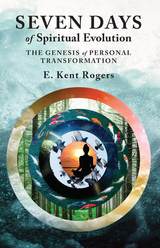 Seven Days of Spiritual Evolution: The Genesis of Personal Transformation
E. Kent Rogers
Swedenborg Foundation Publishers, 2018 What is the Creation story in the book of Genesis really trying to tell us? Is it truly a divinely-inspired description of God creating the world in just six days? With the ongoing evolution of modern scientific discoveries, these questions can be a challenge for Bible-readers like humanitarian and psychotherapist E. Kent Rogers—which is why he believes the story of Creation is actually a timeless guide for our own transition from darkness to light.
In Seven Days of Spiritual Evolution: The Genesis of Personal Transformation, Rogers responds to a growing movement of biblical literalism by turning to eighteenth-century spiritual teacher Emanuel Swedenborg, who wrote prolifically about how the deeper symbolic meanings of Bible text can provide spiritual guidance. Using Swedenborg’s language of correspondences, Rogers shows us how Genesis 1 describes our psychological landscape as it unfolds along the horizons of our inner journey toward God. He draws insightful parallels between the different stages of our spiritual growth and contemporary psychotherapeutic treatment—from person-centered to cognitive to behavioral therapies. To make the intangible tangible, Rogers accesses what he has learned as both a mental health counselor and spiritual practitioner to offer workable methods for improving how we think and behave on a daily basis.
Intended as a tool for anyone who is interested in personal and spiritual development, Seven Days of Spiritual Evolution weaves psychology, spirituality, and everyday experience into a practical approach to growth. “Faith isn’t about drawing lines in the sand or judging others,” Rogers says, “it’s about learning how to love others and to love God.” Ultimately, it’s about opening our hearts to the Bible as a useful and never-ending guidebook for God’s all-loving, redeeming, and merciful work in the world.
 Seven Days to the Funeral
Ján Rozner
Karolinum Press, 2024 A dissident's deeply personal and unflinching view of Soviet oppression in Czechoslovakia in the wake of the 1968 invasion.
Seven Days to the Funeral is the fictionalized memoir of Ján Rozner, a leading Slovak journalist, critic, dramaturg, and translator. Rozner and his wife Zora Jesenská were champions of the Prague Spring and were blacklisted after the Soviet-led invasion of Czechoslovakia in 1968. When Jesenská died in 1972, her funeral became a political event and attendees faced recriminations.
A painstaking account of the week after his wife’s death, Seven Days to the Funeral is a historical record of the devastating impact of the period after the invasion. Through ruthless portraits of key figures in Slovak culture, the book provides a fascinating cultural history of Slovakia from 1945 to 1972. It is also a moving love story of an unlikely couple. Although Rozner began the book in 1976, it was left unfinished upon his death. The book was published posthumously in 2009 by his second wife Sláva Roznerová.
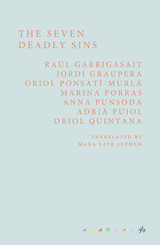 The Seven Deadly Sins
Translated by Mara Faye Lethem
Fum d'Estampa Press, 2022
The Seven Deadly Sins is an ambitious project bringing together seven of the most exciting, vibrant voices in Catalan literature to write essays on what are perhaps the most enigmatic—and least understood—aspects of religion and morality. Drawing from many different sources, the essayists tell each sin’s story and origin in their own unique way to produce a collection that is frequently hilarious, and always entertaining and informative. In Mara Faye Lethem’s stunning translation, these are essays that can be enjoyed as part of a whole or individually.
Raül Garrigasait, Jordi Graupera, Oriol Ponsatí-Murlà, Marina Porras, Anna Punsoda, Adrià Pujol, and Oriol Quintana are some of the most promising new writers and intellectuals working in Catalonia today. Coming from various backgrounds, these award-winning writers encapsulate the dynamic social and cultural movement that is the current literature scene in Catalonia.
 Seven Deadly Sins: A Very Partial List
Aviad KleinbergTranslated by Susan Emanuel in Collaboration with the Author
Harvard University Press, 2008 There is no society without right and wrong. There is no society without sin. But every culture has its own favorite list of trespasses. Perhaps the most influential of these was drawn up by the Church in late antiquity: the Seven Deadly Sins. Pride, sloth, gluttony, envy, anger, lust, and greed are not forbidden acts but the passions that lead us into temptation. Aviad Kleinberg, one of the most prominent public intellectuals in Israel, examines the arts of sinning and of finger pointing. What is wrong with a little sloth? Where would haute cuisine be without gluttony? Where would we all be without our parents’ lust? Has anger really gone out of style in the West? Can consumer culture survive without envy and greed? And with all humility, why shouldn’t we be proud?
With intellectual insight and deadpan humor, Kleinberg deftly guides the reader through Jewish, Christian, and Greco-Roman thoughts on sin. Each chapter weaves the past into the present and examines unchanging human passions and the deep cultural shifts in the way we make sense of them. Seven Deadly Sins is a compassionate, original, and witty look at the stuff that makes us human.
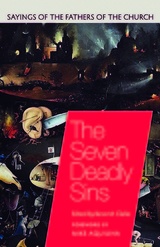 The Seven Deadly Sins: Sayings of the Fathers of the Church
Kevin M. Clarke
Catholic University of America Press, 2018 The Seven Deadly Sins: Sayings of the Fathers of the Church is the inaugural volume in a new series from the Catholic University of America Press. This series will feature a wide range of scholars compiling material from the Fathers of the Church series to focus on a specific area of theology. Forthcoming titles will focus on Death, Judgement, Heaven and Hell, and Angels and Demons, with others to be announced shortly.
Sacred Scripture did not neatly list the seven deadly sins, so where did this tradition come from? Unsurprisingly, it can be traced back to the Church Fathers. But were there eight or seven? In a sense, the answer is “both.” The tradition of the capital sins has a rich development in the patristic era, not only in the presentation of the list of vices but in the preaching and teaching of the early shepherds of the Church. So how do the capital sins spawn other vices in the soul? How does one cultivate the virtues that heal the soul from those vices? How are gluttony and lust related? Is sadness really a vice? How is vainglory different from pride? What role does almsgiving have in soothing the passion of anger? The Fathers of the Church answer these questions and more in this volume.
The capital vices are the gateway drugs to countless sins. The path of the book descends through the vices, culminating with their queen ruler, pride. The words of the Fathers will assist the reader in being more realistic about the attacks upon the soul. The text should also be edifying and medicinal. Since each chapter begins with vice and ends with virtue, one’s path through the chapters represents a sort of ascent out of vice and into the freedom of the virtues. The text gives special attention throughout to the thought of Augustine of Hippo, Evagrius of Pontus, John Cassian, Gregory the Great, and Maximus the Confessor.
The Seven Deadly Sins Today
Henry Fairlie
University of Notre Dame Press, 1978 Sin, like death, is an unassailable fact of life. It is also one of the last great taboos for public debate. In this compelling book, the Henry Fairlie shows that it is possible and necessary to talk about sin in ways that enrich our societies and our personal lives. Fairlie relates these ancient sins to the central issues of contemporary life: liberal vs. conservative politics, discrimination, pornography, abortion, the vistas of modern science, and especially the pop-psychologies that confirm the narcissism of our age.
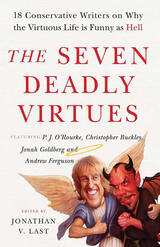 The Seven Deadly Virtues: 18 Conservative Writers on Why the Virtuous Life is Funny as Hell
Jonathan V. Last
Templeton Press, 2014 An all-star team of eighteen conservative writers offers a hilarious, insightful, sanctimony-free remix of William Bennett’s The Book of Virtues—without parental controls. The Seven Deadly Virtues sits down next to readers at the bar, buys them a drink, and an hour or three later, ushers them into the revival tent without them even realizing it.
The book’s contributors include Sonny Bunch, Christopher Buckley, David “Iowahawk” Burge, Christopher Caldwell, Andrew Ferguson, Jonah Goldberg, Michael Graham, Mollie Hemingway, Rita Koganzon, Matt Labash, James Lileks, Rob Long, Larry Miller, P. J. O’Rourke, Joe Queenan, Christine Rosen, and Andrew Stiles. Jonathan V. Last, senior writer at the Weekly Standard, editor of the collection, is also a contributor. All eighteen essays in this book are appearing for the first time anywhere.
In the book’s opening essay, P. J. O’Rourke observes: “Virtue has by no means disappeared. It’s as much in public view as ever. But it’s been strung up by the heels. Virtue is upside down. Virtue is uncomfortable. Virtue looks ridiculous. All the change and the house keys are falling out of Virtue’s pants pockets.”
Here are the virtues everyone (including the book’s contributors) was taught in Sunday school but have totally forgotten about until this very moment. In this sanctimony-free zone:
• Joe Queenan observes: “In essence, thrift is a virtue that resembles being very good at Mahjong. You’ve heard about people who can do it, but you’ve never actually met any of them.”
• P. J. O’Rourke notes: “Fortitude is quaint. We praise the greatest generation for having it, but they had aluminum siding, church on Sunday, and jobs that required them to wear neckties or nylons (but never at the same time). We don’t want those either.”
• Christine Rosen writes: “A fellowship grounded in sociality means enjoying the company of those with whom you actually share physical space rather than those with whom you regularly and enthusiastically exchange cat videos.”
• Rob Long offers his version of modern day justice: if you sleep late on the weekend, you are forced to wait thirty minutes in line at Costco.
• Jonah Goldberg offers: “There was a time when this desire-to-do-good-in-all-things was considered the only kind of integrity: ‘Angels are better than mortals. They’re always certain about what is right because, by definition, they’re doing God’s will.’ Gabriel knew when it was okay to remove a mattress tag and Sandalphon always tipped the correct amount.”
• Sonny Bunch dissects forbearance, observing that the fictional Two Minutes Hate of George Orwell’s 1984 is now actually a reality directed at living, breathing people. Thanks, in part, to the Internet, “Its targets are designated by a spontaneously created mob—one that, due to its hive-mind nature—is virtually impossible to call off.”
By the time readers have completed The Seven Deadly Virtues, they won’t even realize that they’ve just been catechized into an entirely different—and better—moral universe.
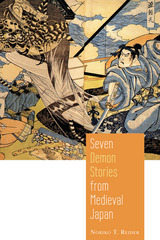 Seven Demon Stories from Medieval Japan
Noriko T. Reider
Utah State University Press, 2016 In Japanese culture, oni are ubiquitous supernatural creatures who play important roles in literature, lore, and folk belief. Characteristically ambiguous, they have been great and small, mischievous and dangerous, and ugly and beautiful over their long history. Here, author Noriko Reider presents seven oni stories from medieval Japan in full and translated for an English-speaking audience.
Reider, concordant with many scholars of Japanese cultural studies, argues that to study oni is to study humanity. These tales are from an era in which many new oni stories appeared for the purpose of both entertainment and moral/religious edification and for which oni were particularly important, as they were perceived to be living entities. They reflect not only the worldview of medieval Japan but also themes that inform twenty-first-century Japanese pop and vernacular culture, including literature, manga, film, and anime. With each translation, Reider includes an introductory essay exploring the historical and cultural importance of the characters and oni manifestations within this period.
Offering new insights into and interpretations of not only the stories therein but also the entire genre of Japanese ghost stories, Seven Demon Stories is a valuable companion to Reider’s 2010 volume Japanese Demon Lore. It will be of significant value to folklore scholars as well as students of Japanese culture.
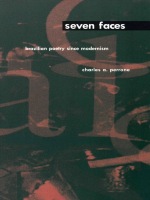 Seven Faces: Brazilian Poetry Since Modernism
Charles A. Perrone
Duke University Press, 1996 Brazil, perhaps more than any other nation of the Americas, has placed poetry at the forefront of dialogue and debate about the limits and uses of art, the social duties of artists, and the nature of nationalism and national identity. In Seven Faces, Charles A. Perrone charts the course of Brazilian poetry in the contemporary period through the principal currents, multiple tendencies, and aesthetic tensions that have made the Brazilian lyric so creatively diverse.
Perrone introduces the most important poetic themes of the second half of this century with a look back at Brazilian modernismo and the avant-garde legacy of poets of the 1920s and 30s. Brazilian poets, the author reveals, have long drawn inspiration from the other arts, experimenting with the inclusion of music, graphic arts, and other nontraditional elements within lyric forms. Relating aesthetic concerns to cultural issues, Perrone elucidates the major poetic movements in Brazil since modernismo: concretism and vanguard poetry, politically committed verse of the 60s, youth poetry of the 70s, the lyricism of Brazil’s renowned popular music, and the rethinking of poetry through postmodernism in the final decades of this century.
Providing a window on the ways in which poetry reflects a national spirit and offers a measure of the status of culture in a consumer society, Seven Faces is the only book-length study in English of contemporary Brazilian poetry. It will be welcomed by students and scholars of Latin American literature as well as by general readers interested in poetry and its influence on culture and society.
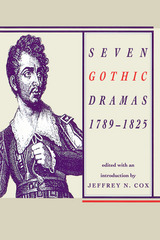 Seven Gothic Dramas, 1789–1825: 1789-1825
Jeffrey N. Cox
Ohio University Press, 1994 The Gothic drama came at a critical moment in the history of the theater, of British culture, and of European politics in the shadow of France’s revolution and the fall of Napoleon. It offered playwrights a medium to express the prevailing ideological tensions of romanticism and revolution, and also responded to a growing and changing theater audience.
In a wide-ranging introduction, Cox explores Gothic drama’s links with romanticism and its relation to other social and ideological shifts of the day. The texts are presented so as to reflect the dual life of dramatic works—on the stage and on the page. The plays are annotated and accompanied by biographic and bibliographic sketches.
Includes The Kentish Barons, by Francis North; Julia of Louvain; or, Monkish Cruelty, by J.C. Cross; The Castle Spectre, by Matthew G. Lewis; The Captive, by Matthew G. Lewis; De Monfort, by Joanna Baillie; Bertram; or, The Castle of St. Aldobrand, by C.R. Maturin; and Presumption; or, The Fate of Frankenstein, by R.B. Peake.
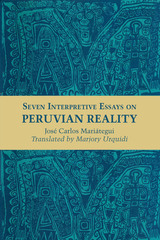 Seven Interpretive Essays on Peruvian Reality
By José Carlos Mariátegui
University of Texas Press, 1971 "Once again I repeat that I am not an impartial; objective critic. My judgments are nourished by my ideals, my sentiments, my passions. I have an avowed and resolute ambition: to assist in the creation of Peruvian socialism. I am far removed from the academic techniques of the university."—From the Author's Note Jose Carlos Mariátegui was one of the leading South American social philosophers of the early twentieth century. He identified the future of Peru with the welfare of the Indian at a time when similar ideas were beginning to develop in Middle America and the Andean region. Generations of Peruvian and other Latin American social thinkers have been profoundly influenced by his writings. Seven Interpretive Essays on Peruvian Reality (Siete ensayos de interpretación de la realidad peruana), first published in 1928, is Mariátegui's major statement of his position and has gone into many editions, not only in Peru but also in other Latin American countries. The topics discussed in the essays—economic evolution, the problem of the Indian, the land problem, public education, the religious factor, regionalism and centralism, and the literary process—are in many respects as relevant today as when the book was written. Mariátegui's thinking was strongly tinged with Marxism. Because contemporary sociology, anthropology, and economics have been influenced by Marxism much more in Latin America than in North America, it is important that North Americans become more aware of Mariátegui's position and accord it its proper historical significance. Jorge Basadre, the distinguished Peruvian historian, in an introduction written especially for this translation, provides an account of Mariátegui's life and describes the political and intellectual climate in which these essays were written.
 Seven Irish Plays, 1946-1964
Robert Hogan
University of Minnesota Press, 1967
Seven Irish Plays, 1946-1964 was first published in 1967. Minnesota Archive Editions uses digital technology to make long-unavailable books once again accessible, and are published unaltered from the original University of Minnesota Press editions.Some of the best plays written in Ireland since the end of World War II are published in this collection of seven full-length plays by six different writers. Although all of the playwrights represented are richly talented, their dramatic work is relatively unknown outside of Ireland. Only three of the plays have been previously published, and they were issued only in Ireland and only in acting editions. As Professor Hogan explains, the reason so little has been heard of the new drama of Ireland is more a matter of theatrical economics than of dramatic merit, since most of the international repertoire of modern plays is drawn from the commercial stages of London, Paris, Berlin, and New York, and not from Dublin.The plays published here are The Visiting House by Michael Molloy, Design for a Headstone by Bryan MacMahon, Copperfaced Jack by John O’Donovan, Sharon’s Grave and Many Young Men of Twenty, both by John B. Keane, and The Ice Goddess by James Douglas.In a general introduction the editor traces the history of Irish drama from the turn of the century to the present, discussing the work of numerous writers in addition to this represented in this collection. He also provides a separate introduction for each of the playwrights whose work is included and a glossary of Irish words and phrases which occur frequently in the plays.
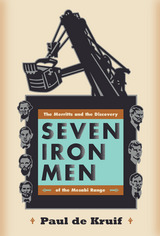 Seven Iron Men: The Merritts and the Discovery of the Mesabi Range
Paul de Kruif
University of Minnesota Press, 2007 In the tradition of great American rags to riches stories, Seven Iron Men weaves together the history of how the seven Merritt brothers discovered iron ore on the Mesabi Range. In 1890 they were poised to become one of the wealthiest families in America but lost it all to industrialist John D. Rockefeller. “The tale of their long and furious quest makes for one of the most melodramatic stories in American history. . . . The Merritts leap from the chronicle in all the colors of life—especially Lon, the king of them all, with his maudlin poetizing, his childlike faith in mankind, and his incredible tropical hat. It is a tale full of thrills, shot with sardonic humors.” —H. L. Mencken, The Nation “Certainly it is no small contribution to the history of the American people to unfold the tale of the discovery and development of those huge iron deposits of the Mesabi Range flanking much of Lake Superior. To these perhaps quite as much as to any other one factor the country owes its industrial supremacy in the ago of steel.” —New York Herald Tribune Paul de Kruif (1890–1971) was a microbiologist, served as a contributing editor to Reader’s Digest, and was the best-selling author of Microbe Hunters.
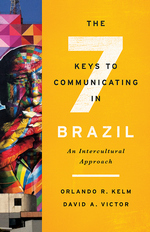 The Seven Keys to Communicating in Brazil: An Intercultural Approach
Orlando R. Kelm and David A. Victor
Georgetown University Press, 2016 The key to professional success in Brazil is understanding Brazilians. But how do you understand an unfamiliar culture? Seasoned cross-cultural trainers Orlando R. Kelm and David A. Victor use Victor’s groundbreaking approach of evaluating a culture’s language, environment, social organization, context, authority, nonverbal communication, and time conception to provide a framework for understanding Brazilians and show effective strategies to overcome these communication barriers. The method, referred to as the LESCANT approach makes you the expert evaluator of the culture and helps you easily navigate hurdles that can challenge business relationships. Each chapter of The Seven Keys to Communicating in Brazil employs memorable anecdotes, business cases on each topic from business professionals, and photographs to address key topics. The authors demonstrate how to evaluate the cultural differences between Brazil and North America and include examples of common communication mistakes. Engaging and accessible, the book helps North Americans master the nuances of the Brazilian language and achieve a real experience of the Brasil dos brasileiros.
 The Seven Keys to Communicating in Japan: An Intercultural Approach
Haru Yamada, Orlando R. Kelm, and David A. Victor.
Georgetown University Press The key to professional success in Japan is understanding Japanese people. The authors, seasoned cross-cultural trainers for businesspeople, provide a practical set of guidelines for understanding Japanese people and culture through David A. Victor's LESCANT approach of evaluating a culture's language, environment, social organization, context, authority, nonverbal communication, and time conception. Each chapter addresses one of these topics and shows effective strategies to overcoming cultural barriers and demonstrates how to evaluate the differences between Japan and North America to help avoid common communication mistakes. The book is generously peppered with photographs to provide visual examples. Exploring language and communication topics, international relations, and the business community, this book is an excellent intercultural overview for anyone traveling to or working in Japan.
 The Seven Keys to Communicating in Mexico: An Intercultural Approach
Orlando R. Kelm, Olivia Hernandez-Pozas, and David A. Victor
Georgetown University Press, 2020 How do you build successful professional connections with colleagues from Mexico? While most books focus simply on how to avoid common communication mistakes, this book leads its readers to an understanding of how to succeed and thrive within the three cultures, Mexico, the US, and Canada. Kelm, Hernandez-Pozas and Victor present a set of practical guidelines for communicating professionally with Mexicans, both in Mexico and abroad, providing many photographs as examples. The Seven Keys to Communicating in Mexico follows the model of presenting key cultural concepts used in the earlier books by Kelm and Victor on Brazil and (with Haru Yamada) on Japan. Olivia Hernandez-Pozas, Orlando Kelm, and David Victor, well-respected research professors and seasoned cross-cultural trainers for businesspeople, guide readers through Mexican culture using Victor's LESCANT Model (an acronym representing seven key cross-cultural communication areas: Language, Environment, Social Organization, Contexting, Authority, Nonverbal Behavior, and Time). Each chapter addresses one of these topics and demonstrates how to evaluate the differences among Mexican, US, and Canadian cultures. In the final chapter the authors bring all of these cultural interactions together with a sample case study about business interactions between Mexicans and North Americans. The case study includes additional observations from North American and Mexican business professionals who offer related suggestions and recommendations.
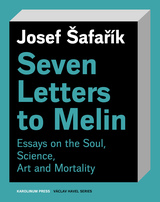 Seven Letters to Melin: Essays on the Soul, Science, Art and Mortality
Josef Šafarík
Karolinum Press, 2020 Josef Šafařík’s Seven Letters to Melin is an exploration of man’s alienation from nature—and from himself—in the modern technological age. Conceived as a series of letters to Melin, an engineer who believes in the value of science and technical progress, the book grows skeptical of such endeavors, while also examining mankind’s search for meaning in life. To help uncover this meaning, Šafařík posits a dichotomy between spectator and participant. The role of participant is played by Robert, an artist who has committed suicide. The spectator, embodied by the scientist Melin, views the world from a distance and searches for explanations, while the artist-participant creates the world through his own active engagement.
Through these exchanges, Šafařík argues for the primacy of artistic creativity over scientific explanation, of truth over accuracy, of internal moral agency over an externally imposed social morality, and of personal religious belief over organized church-going. Šafařík is neither anti-scientific nor anti-rational; however, he argues that science has limited power, and he rejects the idea of science that denies meaning and value to what cannot be measured or calculated.
Šafařík’s critiques of technology, the wage economy, and increased professionalization make him an important precursor to the philosophy of deep ecology. This book was also a major influence on the Czech president Václav Havel; in this new translation it will find a fresh cohort of readers interested in what makes us human.
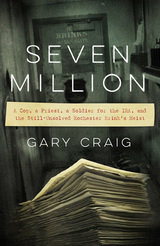 Seven Million: A Cop, a Priest, a Soldier for the IRA, and the Still-Unsolved Rochester Brink's Heist
Gary Craig
University Press of New England, 2017 On a freezing night in January 1993, masked gunmen walked through the laughably lax security at the Rochester Brink’s depot, tied up the guards, and unhurriedly made off with $7.4 million in one of the FBI’s top-five armored car heists in history. Suspicion quickly fell on a retired Rochester cop working security for Brinks at the time—as well it might. Officer Tom O’Connor had been previously suspected of everything from robbery to murder to complicity with the IRA. One ex-IRA soldier in particular was indebted to O’Connor for smuggling him and his girlfriend into the United States, and when he was caught in New York City with $2 million in cash from the Brink’s heist, prosecutors were certain they finally had enough to nail O’Connor. But they were wrong. In Seven Million, the reporter Gary Craig meticulously unwinds the long skein of leads, half-truths, false starts, and dead ends, taking us from the grim solitary pens of Northern Ireland’s Long Kesh prison to the illegal poker rooms of Manhattan to the cold lakeshore on the Canadian border where the body parts began washing up. The story is populated by a colorful cast of characters, including cops and FBI agents, prison snitches, a radical priest of the Melkite order who ran a home for troubled teenagers on the Lower East Side of Manhattan, and the IRA rebel who’d spent long years jailed in one of Northern Ireland’s most brutal prisons and who was living underground in New York posing as a comics dealer. Finally, Craig investigates the strange, sad fate of Ronnie Gibbons, a down-and-out boxer and muscle-for-hire in illegal New York City card rooms, who was in on the early planning of the heist, and who disappeared one day in 1995 after an ill-advised trip to Rochester to see some men about getting what he felt he was owed. Instead, he got was what was coming to him. Seven Million is a meticulous re-creation of a complicated heist executed by a variegated and unsavory crew, and of its many repercussions. Some of the suspects are now dead, some went to jail; none of them are talking about the robbery or what really happened to Ronnie Gibbons. And the money? Only a fraction was recovered, meaning that most of the $7 million is still out there somewhere.
 Seven Modern American Novelists: An Introduction
William Van O’Connor, Editor
University of Minnesota Press, 1964
Seven Modern American Novelists was first published in 1964. Minnesota Archive Editions uses digital technology to make long-unavailable books once again accessible, and are published unaltered from the original University of Minnesota Press editions.
This volume provides critical introductions to seven of the most significant American novelists of this century, bringing together in convenient book form the material from some of the University of Minnesota Pamphlets on American Writers. The writers discussed and the contributing authors are Edith Wharton by Louis Auchincloss, Sinclair Lewis by Mark Schorer, F. Scott Fitzgerald by Charles E. Shain, William Faulkner by William Van O'Connor, Ernest Hemingway by Philip Young, Thomas Wolfe by C. Hugh Holman, and Nathanael West by Stanley Edgar Hyman.
In an introduction Mr. O'Connor, who is one of the editors of the pamphlet series, discusses some critical principles as they apply to fiction writers in general and to twentieth-century American novelists in particular. He is the author of many volumes of literary criticism as well as a collection of short stories and was a professor of English at the University of California, Davis.
Teachers, librarians, and others who use the material of the University of Minnesota Pamphlets on American Writers for frequent reference or as classroom texts will find this book particularly useful. Biographical information about the writers as well as critical evaluations of their writing is given. A bibliography for each writer lists his works and critical and biographical works about him.
 Seven Modern American Poets: An Introduction
Leonard Unger
University of Minnesota Press, 1967
Seven Modern American Poets was first published in 1967. Minnesota Archive Editions uses digital technology to make long-unavailable books once again accessible, and are published unaltered from the original University of Minnesota Press editions.
This volume provides concise critical introductions to seven of the most important twentieth-century American poets, bringing together in convenient book form the material from some of the University of Minnesota Pamphlets on American Writers. The poets discussed and the contributing authors are Robert Frost by Lawrance Thompson, Wallace Stevens by William York Tindall, William Carlos Williams by John Malcolm Brinnin, Ezra Pound by William Van O'Connor, John Crowe Ransom by John L. Stewart, T.S. Eliot by Leonard Unger, and Allen Tate by George Hemphill.
Biographical information about the poets as well as critical discussions of their work is provided. A selected bibliography for each poet lists his works and critical and biographical writing about him.
In an introduction Mr. Unger, who is one of the editors of the pamphlet series, discusses the poets and their place in the development of modern American poetry. Mr. Unger is a professor of English at the University of Minnesota and the author of a number of critical works, including T. S. Eliot: Moments and Patterns.
Teachers, librarians, and others who use the material of the University of Minnesota Pamphlets on American Writers for frequent reference or as classroom texts will find this book particularly useful. It serves also as an excellent guide for the general reader.
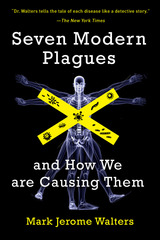 Seven Modern Plagues: and How We Are Causing Them
Mark Jerome Walters
Island Press, 2014 Epidemiologists are braced for the big one: the strain of flu that rivals the pandemic of 1918-1919, which killed at least 20 million people worldwide. In recent years, we have experienced scares with a host of new influenza viruses: bird flu, swine flu, Spanish flu, Hong Kong flu, H5N1, and most recently, H5N7. While these diseases appear to emerge from thin air, in fact, human activity is driving them. And the problem is not just flu, but a series of rapidly evolving and dangerous modern plagues.
According to veterinarian and journalist Mark Walters, we are contributing to-if not overtly causing-some of the scariest epidemics of our time. Through human stories and cutting-edge science, Walters explores the origins of seven diseases: mad cow disease, HIV/AIDS, Salmonella DT104, Lyme disease, hantavirus, West Nile, and new strains of flu. He shows that they originate from manipulation of the environment, from emitting carbon and clear-cutting forests to feeding naturally herbivorous cows "recycled animal protein."
Since Walters first drew attention to these "ecodemics" in 2003 with the publication of Six Modern Plagues, much has been learned about how they developed. In this new, fully updated edition, the author presents research that precisely pinpoints the origins of HIV, confirms the link between forest fragmentation and increased risk of Lyme disease, and expands knowledge of the ecology of West Nile virus.
He also explores developments in emerging diseases, including a new chapter on flu, examining the first influenza pandemic since the Hong Kong flu of 1968; a new tick-borne infection in the Mid-West; a second novel bird flu in China; and yet a new SARS-like virus in the Middle East.
Readers will not only learn how these diseases emerged but the conditions that make future pandemics more likely. This knowledge is critical in order to prevent the next modern plague.
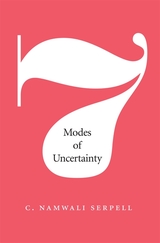 Seven Modes of Uncertainty
C. Namwali Serpell
Harvard University Press, 2014 Literature is rife with uncertainty. Literature is good for us. These two ideas about reading literature are often taken for granted. But what is the relationship between literature’s capacity to unsettle, perplex, and bewilder us, and literature’s ethical value? To revive this question, C. Namwali Serpell proposes a return to William Empson’s groundbreaking work, Seven Types of Ambiguity (1930), which contends that literary uncertainty is crucial to ethics because it pushes us beyond the limits of our own experience.
Taking as case studies experimental novels by Thomas Pynchon, Toni Morrison, Bret Easton Ellis, Ian McEwan, Elliot Perlman, Tom McCarthy, and Jonathan Safran Foer, Serpell suggests that literary uncertainty emerges from the reader’s shifting responses to structures of conflicting information. A number of these novels employ a structure of mutual exclusion, which presents opposed explanations for the same events. Some use a structure of multiplicity, which presents different perspectives regarding events or characters. The structure of repetition in other texts destabilizes the continuity of events and frustrates our ability to follow the story.
To explain how these structures produce uncertainty, Serpell borrows from cognitive psychology the concept of affordance, which describes an object’s or environment’s potential uses. Moving through these narrative structures affords various ongoing modes of uncertainty, which in turn afford ethical experiences both positive and negative. At the crossroads of recent critical turns to literary form, reading practices, and ethics, Seven Modes of Uncertainty offers a new phenomenology of how we read uncertainty now.
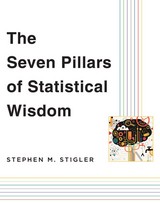 The Seven Pillars of Statistical Wisdom
Stephen M. Stigler
Harvard University Press, 2016 What gives statistics its unity as a science? Stephen Stigler sets forth the seven foundational ideas of statistics—a scientific discipline related to but distinct from mathematics and computer science.
Even the most basic idea—aggregation, exemplified by averaging—is counterintuitive. It allows one to gain information by discarding information, namely, the individuality of the observations. Stigler’s second pillar, information measurement, challenges the importance of “big data” by noting that observations are not all equally important: the amount of information in a data set is often proportional to only the square root of the number of observations, not the absolute number. The third idea is likelihood, the calibration of inferences with the use of probability. Intercomparison is the principle that statistical comparisons do not need to be made with respect to an external standard. The fifth pillar is regression, both a paradox (tall parents on average produce shorter children; tall children on average have shorter parents) and the basis of inference, including Bayesian inference and causal reasoning. The sixth concept captures the importance of experimental design—for example, by recognizing the gains to be had from a combinatorial approach with rigorous randomization. The seventh idea is the residual: the notion that a complicated phenomenon can be simplified by subtracting the effect of known causes, leaving a residual phenomenon that can be explained more easily.
The Seven Pillars of Statistical Wisdom presents an original, unified account of statistical science that will fascinate the interested layperson and engage the professional statistician.
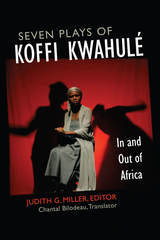 Seven Plays of Koffi Kwahulé: In and Out of Africa
Judith G. Miller, Editor, Chantal Bilodeau, Translator
University of Michigan Press, 2017 The work of renowned Ivoirian playwright Koffi Kwahulé has been translated into some 15 languages and is performed regularly throughout Europe, Africa, and the Americas. For the first time, Seven Plays of Koffi Kwahulé: In and Out of Africa makes available to an Anglophone audience some of the best and most representative plays by one of Francophone Africa’s most accomplished living playwrights.
Kwahulé’s theater delves into both the horror of civil war in Africa and the diasporic experience of peoples of African origin living in Europe and the “New World.” From the split consciousness of the protagonist and rape victim in Jaz to the careless buffoonery of mercenaries in Brewery, Kwahulé’s characters speak in riffs and refrains that resonate with the improvisational pulse of jazz music. He confronts us with a violent world that represents the damage done to Africa and asks us, through exaggeration and surreal touches, to examine the reality of an ever-expanding network of global migrants. His plays speak to the contemporary state of humanity, suffering from exile, poverty, capitalist greed, collusion, and fear of “the other”—however that “other” gets defined.
Judith G. Miller’s introductory essay situates Kwahulé among his postcolonial contemporaries. Short introductory essays to each play, accompanied by production photos, contextualize possible approaches to Kwahulé’s often enigmatic work. Anglophone theater scholars and theater professionals eager to engage with contemporary theater beyond their borders, particularly in terms of what so-called minority theater artists from other countries are creating, will welcome this indispensable collection. Students and scholars of African studies and of global French studies will also find this work intriguing and challenging.
Seven Rules for Sustainable Communities: Design Strategies for the Post Carbon World
Patrick M. Condon
Island Press, 2010 Questions of how the design of cities can respond to the challenge of climate change dominate the thoughts of urban planners and designers across the U.S. and Canada. With admirable clarity, Patrick Condon responds to these questions. He addresses transportation, housing equity, job distribution, economic development, and ecological systems issues and synthesizes his knowledge and research into a simple-to-understand set of urban design recommendations. No other book so clearly connects the form of our cities to their ecological, economic, and social consequences. No other book takes on this breadth of complex and contentious issues and distills them down to such convincing and practical solutions.
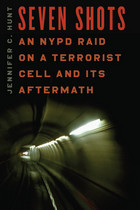 Seven Shots: An NYPD Raid on a Terrorist Cell and Its Aftermath
Jennifer C. Hunt
University of Chicago Press, 2010 On July 31, 1997, a six-man Emergency Service team from the NYPD raided a terrorist cell in Brooklyn and narrowly prevented a suicide bombing of the New York subway that would have cost hundreds, possibly thousands of lives.
Seven Shots tells the dramatic story of that raid, the painstaking police work involved, and its paradoxical aftermath, which drew the officers into a conflict with other rank-and-file police and publicity-hungry top brass. Jennifer C. Hunt draws on her personal knowledge of the NYPD and a network of police contacts extending from cop to four-star chief, to trace the experience of three officers on the Emergency Service entry team and the two bomb squad detectives who dismantled the live device. She follows their lives for five years, from that near-fatal day in 1997, through their encounters inside the brutal world of departmental politics, and on to 9/11, when they once again put their lives at risk in the fight against terrorism, racing inside the burning towers and sorting through the ash, debris, and body parts. Throughout this fast paced narrative, Hunt maintains a strikingly fine-grained, street-level view, allowing us to understand the cops on their own terms—and often in their own words. The result is a compelling insider’s picture of the human beings who work in two elite units in the NYPD and the moral and physical danger and courage involved. As gripping as an Ed McBain novel—and just as steeped in New York cop culture and personalities—Seven Shots takes readers on an unforgettable journey behind the shield and into the hearts of New York City police.
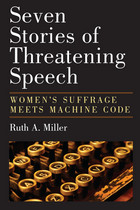 Seven Stories of Threatening Speech: Women's Suffrage Meets Machine Code
Ruth A. Miller
University of Michigan Press, 2012 Ruth A. Miller demonstrates the potential of taking nonhuman linguistic activity—such as the running of machine code—as an analytical model. Via a lively discussion of 19th-century pro- and antisuffragists, Miller tells a new computational story in which language becomes a thing that executes physically or mechanically through systems, networks, and environments, rather than a form for human recognition or representation. Language might be better understood as something that operates but never communicates, that sorts, stores, or reproduces information but never transmits meaning. Miller makes a compelling case that the work that speech has historically done is in need of reevaluation. She severs the link between language and human as well as nonhuman agency, between speech acts and embodiment, and she demonstrates that current theories of electoral politics have missed a key issue: the nonhuman, informational character of threatening linguistic activity. This book thus represents a radical methodological initiative not just for scholars of history and language but for specialists in law, political theory, political science, gender studies, semiotics, and science and technology studies. It takes posthumanist scholarship to an exciting and essential, if sometimes troubling, conclusion. “It is an erudite work by a scholar of enormous talent, who advances a thesis that is richly insightful and deeply provocative.” —Mary Hawkesworth, Rutgers University
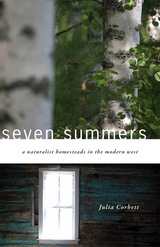 Seven Summers: A Naturalist Homesteads in the Modern West
Julia Corbett
University of Utah Press, 2013 Seven Summers is the story of a naturalist-turned-professor who flees city life each summer with her pets and power tools to pursue her lifelong dream—building a cabin in the Wyoming woods. With little money and even less experience, she learns that creating a sanctuary on her mountain meadow requires ample doses of faith, patience, and luck. This mighty task also involves a gradual and sometimes painful acquisition of flexibility and humility in the midst of great determination and naive enthusiasm. For Corbett, homesteading is not about wresting a living from the land, but respecting and immersing herself in it—observing owls and cranes, witnessing seasons and cycles, and learning the rhythms of wind and weather in her woods and meadow. The process changes her in unexpected ways, just as it did for women homesteaders more than a century ago. The more she works with wood, the more she understands the importance of “going with the grain” in wood as well as in life. She must learn to let go, to move through loss and grief, to trust her voice, and to balance independence and dependence. Corbett also gains a better understanding of her fellow Wyomingites, a mix of ranchers, builders, gas workers, and developers, who share a love of place but often hold decidedly different values. This beautifully written memoir will appeal to readers who appreciate stories of the western landscape, independent women, or the appreciation of the natural world.
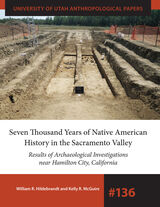 Seven Thousand Years of Native American History in the Sacramento Valley: Results of Archaeological Investigations near Hamilton City, California
William R. Hildebrandt and Kelly R. McGuire
University of Utah Press, 2022 The Sacramento Valley of northern California is a rich, diverse environment that supported some of the densest populations of nonagricultural people in the world. Periodic flooding, however, has buried much of the valley’s deep cultural history under alluvium. This volume shares the discovery of four buried archaeological sites, including one dating to 7,000 years ago, filled with a diversified assemblage of artifacts and a rich assortment of food remains. Stone net sinkers and associated fish bones represent the oldest fishery ever documented in the interior of California, while such items as marine shell beads, exotic obsidian, and newly recovered charmstones in California provide evidence for long-distance trade networks. in California provide evidence for long-distance trade networks.
The other three sites date between 4000 and 300 years ago and reflect increasing human population density, technological innovation, and the rise of sedentism and territoriality. This historical sequence culminated in findings from a 400- to 300-year-old house complex probably occupied by the Mechoopda Indian Tribe, who collaborated with the authors throughout the project.
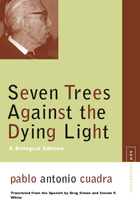 Seven Trees Against the Dying Light: A Bilingual Edition
Pablo Antonio Cuadra
Northwestern University Press, 2007 Standing against the visible landscape—the mountainous volcanoes, the jungles and savannahs—the seven trees conjured in these narrative poems by one of Latin America's masters also evoke another, more mysterious terrain. It is this other landscape, as invisible as poetry before it is written down but etched by history and animated by the collective memory of a people, that speaks through Pablo Antonio Cuadra’s Seven Trees against the Dying Light.
Storing experience as they exist, these tree-poems conserve local soil and memory in the place they inhabit. They are figures of life, stained by seawater and gun powder, by the bright red, bittersweet juice of the many life-giving plums that flourish in Nicaragua, and blood that has been spilled there. And they offer a way of remembering who we are, where we come from, and, above all, where we are bound if we cannot learn to root language in the earth that sustains us.
Printed here in Spanish with facing English translations, the edition includes an introduction with ecocritical focus, as well as complete notes on botanical, historical, mythological, and socio-political references.
|
|
